Physical Address
304 North Cardinal St.
Dorchester Center, MA 02124
The classification of lymphomas and hematopoietic neoplasms has undergone radical changes in philosophy and diagnostic criteria since the early days of Lukes and Collins, Rappaport, and the subsequent Updated Kiel classification and the Working Formulation. The majority of these earlier classifications relied mainly on morphology to differentiate between entities, and were designed to be applicable to nodal disease with little or no attention being paid to extranodal sites (including the skin) or other clinical considerations. More recently, the input of immunohistochemistry enabled recognition of B- and T-cell variants, rapidly followed by the establishment of more detailed and discriminatory criteria for the diagnosis of specific entities. The identification of consistent genetic abnormalities in association with distinct lymphoma subtypes (i.e., the t(14:18) translocation in follicular lymphoma and the t(2:5) translocation in anaplastic large cell lymphoma) has further strengthened precise classification. As a result, modern lymphoma classification schemes recognize entities on the basis of shared morphological, immunophenotypic, genetic, and clinical features, ensuring more relevant disease categories and greater diagnostic consistency.
This more systematic approach achieved general acceptance with the publication of the revised European and American lymphoma (REAL) classification in 1994. However, although the REAL classification recognized certain cutaneous lymphoproliferative disorders as independent entities, it failed to address the fact that certain lymphomas arising primarily in the skin were biologically distinct from morphologically and phenotypically similar neoplasms occurring in lymph nodes. The European Organisation for Research and Treatment of Cancer (EORTC) classification, proposed by the Cutaneous Lymphoma Study Group of the EORTC, sought to address these deficiencies. This was designed for cutaneous lymphomas with a greater emphasis on the unique clinical features of some primary cutaneous lymphomas, but otherwise employed a similar philosophy to that used in the REAL classification. It was originally based on the data derived from 626 patients in the records of the Dutch Registry for Cutaneous Lymphoma, and later validated in several large studies with follow-up data from >1300 patients. This classification subdivided primary cutaneous lesions into indolent, aggressive, and provisional categories based on behavior as determined by clinical experience ( Table 29.1 ). This was a major step forward because it provided a precise definition for a number of primary cutaneous lymphomas and recognized differences in biological behavior (and thus potential treatment requirements) between nodal and cutaneous primary disease. For example, CD30-positive (ALK-negative) large T-cell lymphomas arising in lymph nodes are high-grade tumors, with a mortality of up to 63%, whereas morphologically and immunophenotypically identical tumors arising primarily in the skin are clinically low grade, and have a mortality of less than 5%.
| Primary CTCL | Primary CBCL |
|---|---|
| Indolent | |
| Mycosis fungoides | Follicle center cell lymphoma |
| Mycosis fungoides + follicular mucinosis | Immunocytoma(marginal zone B-cell lymphoma) |
| CD30+ large cell CTCL | |
| Anaplastic | |
| Immunoblastic | |
| Pleomorphic | |
| Lymphomatoid papulosis | |
| Intermediate | |
| Large B-cell lymphoma of the leg | |
| Aggressive | |
| Sézary syndrome | |
| CD30– large cell CTCL | |
| Immunoblastic | |
| Pleomorphic | |
| Provisional | |
| Granulomatous slack skin | Intravascular large B-cell lymphoma |
| CTCL, pleomorphic small/medium-sized | Plasmacytoma |
| Subcutaneous panniculitis-like T-cell lymphoma | |
Many of the advances made in the EORTC classification were not recognized in the update of the REAL classification published jointly with the World Health Organization (WHO) in 2001. This generated considerable controversy, particularly with respect to B-cell neoplasms. Arguments used against the EORTC approach included complaints of too broad a definition of primary cutaneous follicle center cell lymphoma and the appropriateness of designating large B-cell lymphoma of the leg as a separate entity. Dissension also reigned over use of the term primary cutaneous ‘immunocytoma’ as opposed to marginal zone lymphoma, immunocytoma at that time being inclusive of lymphoplasmacytic lymphoma, an entity distinct from marginal zone lymphoma.
These differences were resolved following meetings of members of both classification systems in Lyon and Zurich in 2003 and 2004, respectively. This resulted in a consensus WHO-EORTC classification first published in 2005. The entities delineated in this system were subsequently incorporated, with refinements of some diagnostic criteria and the addition of new entities, into the WHO classification of tumors of the hematopoietic and lymphoid tissue published in 2008, with further modifications in the 2016 revision. The terminology and criteria used in this latest update will be used in this chapter. The main lymphoma subtypes that primarily affect the skin are listed along with their expectant clinical behavior in Table 29.2 .
| WHO-EORTC subtype | Behavior |
|---|---|
| Cutaneous T-cell lymphoma | |
| Mycosis fungoides | Indolent |
| MF variants | |
| Folliculotropic MF | Indolent |
| Pagetoid reticulosis | Indolent |
| Granulomatous slack skin | Indolent |
| Sézary syndrome | Aggressive |
| Adult T-cell leukemia/lymphoma | Aggressive |
| Primary cutaneous CD30+ lymphoproliferative disorders | |
| Primary cutaneous anaplastic large cell lymphoma | Indolent |
| Lymphomatoid papulosis | Indolent |
| Subcutaneous panniculitis-like T-cell lymphoma | Indolent |
| Extranodal NK/T-cell lymphoma, nasal type | Aggressive |
| Primary cutaneous T-cell lymphoma, unspecified | |
| Primary cutaneous aggressive epidermotropic CD8+ T-cell lymphoma * | Aggressive |
| Hydroa vacciniforme-like lymphoma | Aggressive |
| Cutaneous γ/δ T-cell lymphoma | Aggressive |
| Primary cutaneous acral CD8+ T-cell lymphoma * | Indolent |
| Primary cutaneous CD4+ small/medium-sized pleomorphic T-cell lymphoproliferative disorder * | Indolent |
| Cutaneous B-cell lymphoma | |
| Primary cutaneous marginal zone lymphoma | Indolent |
| Primary cutaneous follicle center lymphoma | Indolent |
| Primary cutaneous large B-cell lymphoma, leg type | Intermediate |
| Primary cutaneous large B-cell lymphoma, other | Intermediate |
| Primary cutaneous intravascular large B-cell lymphoma | Intermediate |
Mycosis fungoides (MF) (Gr. mykes , fungus; L. fungus + Gr. eidos , form), although rare, represents the commonest form of primary cutaneous T-cell lymphoma. Alibert named it, in 1806, after the mushroom-like tumors that develop in the terminal stages of the illness ( Fig. 29.1 ). The annual incidence in the United States varies from 0.36 to 0.46 cases per 10 5 of the population, with approximately 1000 new cases diagnosed per year. The incidence in Europe is somewhat less. There is predilection for males (2 : 1). It is more common in blacks (2 : 1) and less common in Asians and Hispanics. Any age group may be involved, but there is a higher incidence in the fourth to sixth decades. MF in children is discussed separately (see below).
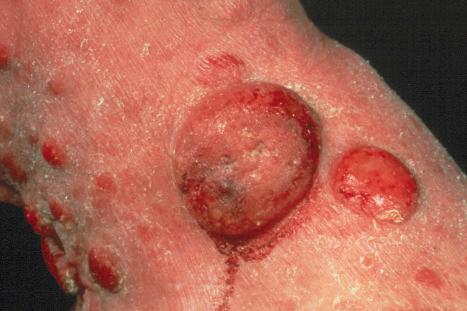
The course and outcome is unpredictable, ranging from a protracted, persistent, relatively benign illness through to a widespread malignancy with high morbidity and mortality.
In addition to the classical (Alibert) form, patients may present with a poikilodermatous variant (poikiloderma atrophicans vasculare, large plaque parapsoriasis) or with erythroderma (Hallopeau-Besnier). The last should not be confused with Sézary syndrome, which represents an erythrodermic leukemic manifestation of T-cell lymphoma, and usually develops de novo. MF presenting with tumor nodules from the outset, so-called tumeur d'emblée mycosis fungoides (Vidal Brocq), is no longer recognized as an entity. Such cases are likely to represent other variants of T-cell lymphoma including cutaneous anaplastic large cell lymphoma or primary cutaneous T-cell lymphoma, unspecified (CD30-negative large cell lymphoma).
Rarer presentations include bullous, follicular, hypopigmented, verrucous/hyperkeratotic, pustular, lichenoid papular, palmoplantar psoriasiform, granulomatous, and acanthosis nigricans-like variants. These are clinically unusual cases that run a similar course to that of classic MF, and are not considered separate entities. In contrast, folliculotropic mycosis fungoides, pagetoid reticulosis, and granulomatous slack skin disease have distinct clinicopathological features and are recognized as biologically distinct variants of MF in the WHO classification.
Classic MF is traditionally divided into patch, plaque, and tumor stages. This is, however, a somewhat arbitrary classification because all stages may be present simultaneously in one individual while other patients never progress beyond the patch stage. In addition, patch stage lesions obviously merge with plaques.
The early erythematous lesions are irregular, asymmetrical, slightly scaly, variably sized pink or red patches ( Fig. 29.2 ). Many lesions show signs of atrophy, and in some lighting conditions they appear smooth and shiny. While lesions are more commonly present on the trunk, limb girdles, breasts, and flexures; they can also be more widespread ( Figs 29.3 and 29.4 ).
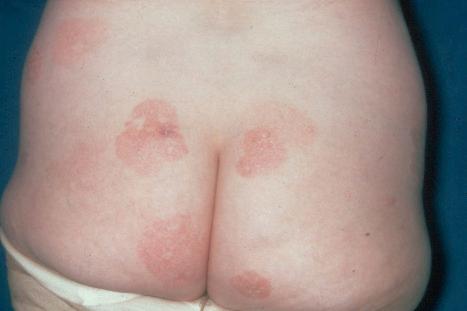
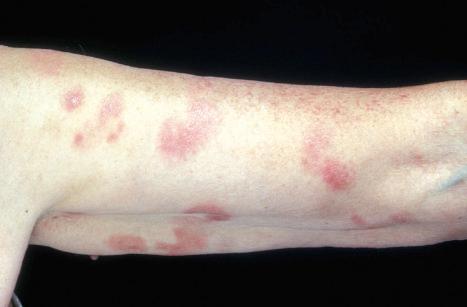
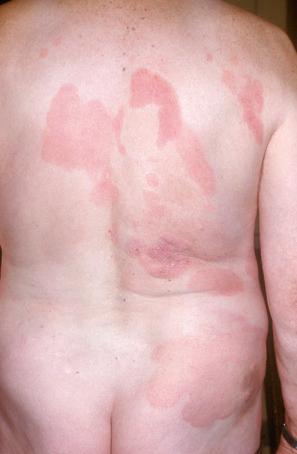
The clinical differential diagnosis includes discoid, atopic or contact allergic dermatitis, psoriasis, and, in particular, chronic superficial scaly dermatitis (small plaque parapsoriasis). Patients, usually middle aged, present with erythematous scaly persistent patches, showing predilection for the limbs and trunk, that are sometimes likened to cigarette paper. While the lesions may be round or oval, they often have a finger-like appearance – hence, the alternative designation digitate dermatosis ( Fig. 29.5 ). The patches tend to be uniform in size, shape, and color, contrasting vividly with the great variability of those of mycosis fungoides.
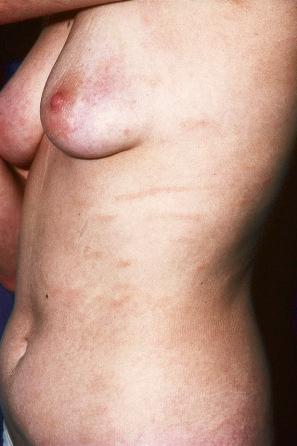
Adverse drug reactions may also mimic mycosis fungoides. Patients can present with multiple infiltrated plaques or erythroderma that are histologically indistinguishable from mycosis fungoides. Drugs which have been particularly implicated are the anticonvulsants (including phenytoin, barbiturates, carbamazepine), cardiac drugs such as atenolol and angiotensin-converting enzyme (ACE) inhibitors, antihistamines, ciclosporin, and allopurinol.
Patients sometimes develop foci of poikiloderma within a more typical background. In others, the entire eruption may be poikilodermatous – so-called poikiloderma atrophicans vasculare (Gr. poikilos , spotted, mottled, varied) (large plaque parapsoriasis). They present with small numbers of large plaques showing a predilection for the breasts, buttocks, hips, abdomen, and major flexures ( Fig. 29.6 ). Individual features of the plaques include atrophy, telangiectases, and variable hypo- and hyperpigmentation with erythema ( Fig. 29.7 ). The appearances have been likened to those of chronic radiation damage. Further progression may be similar to that of classic mycosis fungoides, although it appears that fewer patients develop tumor-stage mycosis fungoides.
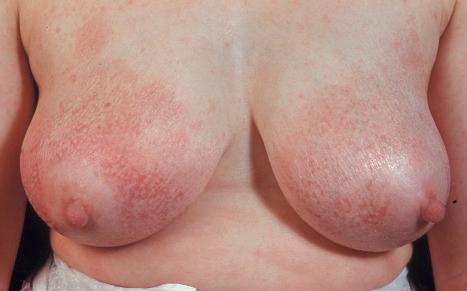
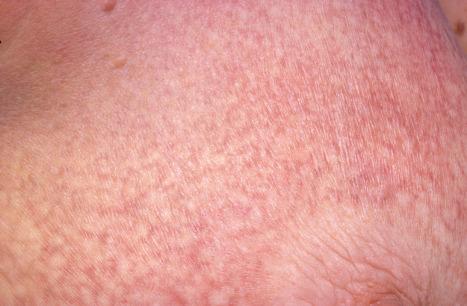
Further progression of patch stage disease leads to the development of an increased number of indurated plaques ( Figs 29.8 and 29.9 ). The lesions can be quite bizarre and, not uncommonly, due to central regression, they have an annular or serpiginous appearance ( Fig. 29.10 ). Plaques are sometimes extremely hyperkeratotic, particularly on the palms and soles (see mycosis fungoides palmaris et plantaris, page 1421 ).
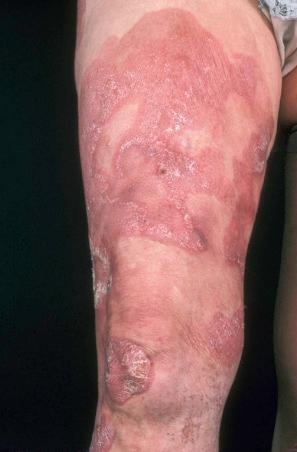
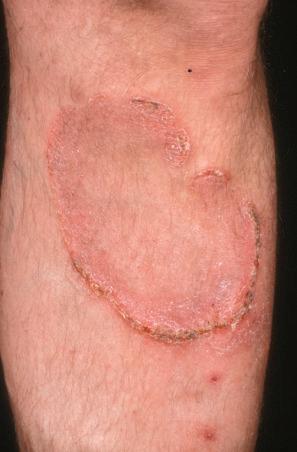
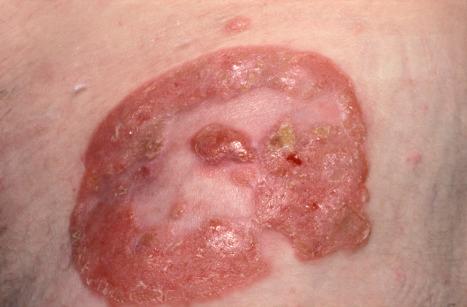
A small proportion of patients develop tumors ( Figs 29.11–29.13 ). Sometimes ulcerative lesions are seen ( Fig. 29.14 ). The face, scalp, and intertriginous areas are particularly affected.
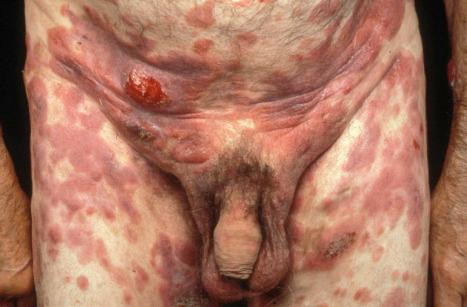
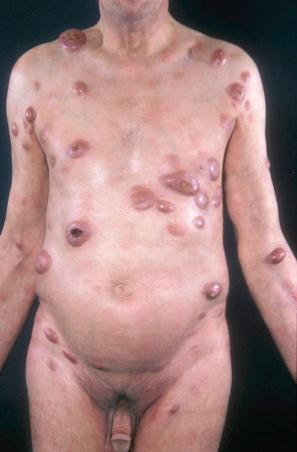
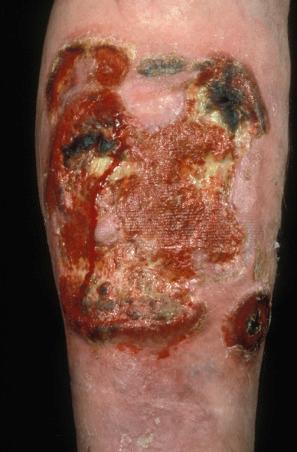
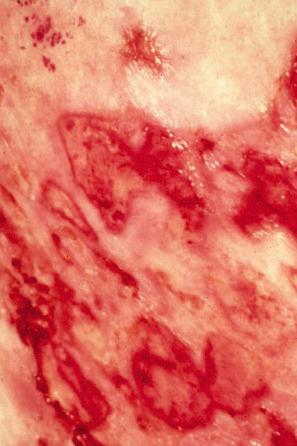
Clinical staging relates to the extent of disease and the presence or absence of cutaneous tumor nodules and erythroderma. It is based on the system proposed by the International Society for Cutaneous Lymphomas (ISCL) and the EORTC. This scheme takes account of advances in molecular biology, immunohistochemistry, and imaging, as well as new data on prognostic variables. It assesses the extent and nature of the skin lesions present, extent of nodal involvement, visceral involvement, and the presence and degree of any peripheral blood involvement ( Table 29.3 ). Combinations of these parameters (stage) can be used to determine prognosis and are essential for determining treatment. Outcome in mycosis fungoides is varied. When only patches and plaques are present at presentation, and cover 10% of body surface area (T1), survival is no different from that of age-matched controls. Patients with patches and plaques covering >10% body surface area (T2) have a median survival of 10–12 years and a 25% risk of progression, whilst the median survival for patients with tumors (T3) or erythroderma (T4) is only 4–5 years. Visceral involvement carries a very poor prognosis, with median survivals of only 1–2 years. Lymph node enlargement is common and does not necessarily indicate pathological involvement. Its impact on prognosis is often overshadowed by the extent of skin lesions. The presence of abnormal circulating cells and the tumor burden in the peripheral blood are also important parameters to assess as they are of independent prognostic significance. The patient should therefore be thoroughly investigated to assess the extent of skin lesions and to determine whether there is nodal, visceral, or hematological spread.
| Stage | Description | TNMB |
|---|---|---|
| IA | Limited patches, papules and/or plaques covering <10% skin surface area (T1); no evidence of nodal (No), visceral (M0) or significant blood involvement (B0), or low blood tumor burden (B1) | T 1 N 0 M 0 B 0,1 |
| B | Generalized patches, papules and/or plaques covering ≥10% skin surface area (T2); no evidence of nodal (No), visceral (M0) or significant blood involvement (B0), or low blood tumor burden (B1) | T 2 N 0 M 0 B 0,1 |
| II | Any extent of patches, papules and/or plaques (T! 0r T2); clinically abnormal nodes showing DL (N1) or early involvement by MF (N2); no evidence of visceral (M0) or significant blood involvement (B0), or low blood tumor burden (B1) | T 1,2 N 1,2 M 0 B 0,1 |
| IIB | One or more tumors (≥1.5 cm diameter) (T3); up to early lymph node involvement (N2); no evidence of visceral (M0) or significant blood involvement (B0), or low blood tumor burden (B1) | T 3 N 0–2 M 0 B 0,1 |
| III | Erythema covering ≥80% skin surface area; up to early lymph node involvement (N2); no evidence of visceral (M0) or significant blood involvement (B0), or low blood tumor burden (B1) | T 4 N 0–2 M 0 B 0,1 |
| IIIA | Stage III with no significant blood involvement | T 4 N 0–2 M 0 B 0 |
| IIIB | Stage III with low blood tumor burden | T 4 N 0–2 M 0 B 1 |
| IVA1 | Any degree of skin involvement; up to early lymph node involvement; no evidence of visceral spread; high blood tumor burden (B2: >1000 Sezary cells/ml with positive clone) | T 1–4 N 0–2 M 0 B 2 |
| IVA2 | Any degree of skin involvement; partial or complete effacement of node by MF (N3); no visceral involvement; any degree of blood involvement | T 1–4 N 3 M 0 B 0–2 |
| IVB | Any degree of skin involvement with visceral involvement, irrespective of nodal or blood involvement | T 1–4 N 0–3 M 1 B 0–2 |
Raised levels of lactate dehydrogenase (LDH), soluble interleukin (IL)-2 receptor, erythrocyte sedimentation rate (ESR), and raised blood eosinophil count are other markers of poor prognosis. Transformation to large cell lymphoma also relates to adverse outcome.
Infection is the major cause of death, with Staphylococcus aureus , Enterobacteriaceae and Pseudomonas aeruginosa being the most frequent pathogens. Beta-hemolytic streptococcus, herpes simplex, and varicella-zoster infections are also of importance.
Patients with mycosis fungoides also have an increased risk of epithelial tumors, including carcinoma of the lung and colon, and B-cell non-Hodgkin lymphoma (NHL).
Mycosis fungoides is a neoplastic proliferation of monoclonal T cells from the outset. While monoclonal lymphoid populations have been described in apparently non-neoplastic conditions, such as pityriasis lichenoides acuta, lichen aureus, lichen planus, pigmented purpuric dermatosis, allergic contact dermatitis, and drug reactions, the presence of a clonal TCR gene rearrangement is highly suggestive of a lymphomatous process, particularly when the same clone is found in more than one lesion or in one patient over time. Furthermore, recurrent chromosomal abnormalities have been found in some cases including loss of chromosomes 1p, 17p, 10q/10, 13q, and 19, as well as gains of 4/4q, 17q/17, and 18.
As with many malignancies, the etiology and pathogenesis of mycosis fungoides is likely to be multifactorial. Specific causative agents and precise pathogenetics are unknown.
There is little evidence of genetic predisposition to mycosis fungoides. Familial occurrence is exceptional. However, a number of studies have inconsistently linked various human leukocyte antigen (HLA) types with mycosis fungoides. For example, HLA-B8 and HLA-AW19 have been found with increased frequency in mycosis fungoides patients from the United Kingdom, whereas an association with HLA-DR5 (DRB1*11) and DQB1*03 was demonstrated in North American Caucasians. In studies from Israel, no association with HLA class I alleles was detected.
It is thought that mycosis fungoides most probably develops as a consequence of chronic antigenic stimulation, either to long-term exposure to irritant substances or infective agents. Epidemiological studies have variously pointed toward occupational exposure to metals, plastics, cutting oils, solvents, glass, pottery, and ceramics, or working as a crop or vegetable farmer, painter, woodworker, or carpenter. A pathogenetic role for infective agents has also long been postulated. A wide range of potential agents, particularly viruses, have been investigated including human T-cell lymphotropic virus-I (HTLV-I), HTLV-II, Epstein-Barr virus (EBV), cytomegalovirus (CMV), human herpes virus (HHV) 6, HHV7, and HHV8. However, the results of various studies looking for evidence of these agents in MF have produced conflicting or inconclusive results. Other organisms that have also been considered include S. aureus , persistent chlamydia infection, and Borrelia burgdorferi . However, there is no strong evidence in favor of these agents playing a direct role in MF pathogenesis. Nevertheless, it remains possible that various infectious agents are important initiators of the chronic lymphoproliferation from which lymphoma eventually develops, and a recent study has suggested that persistence of multiple infectious agents may be more important than any single one in isolation.
A variety of recurrent genetic abnormalities have been identified in mycosis fungoides, although none are specific for this entity. They include deletions of chromosomes 1p, 17p, 10q, and 19, as well as gains on 4q, 18, and 17q. Alterations in a number of tumor suppressor and apoptosis-related genes have also been detected. Silencing of p15, p16, Nav3, PTEN, and p53 due to mutations, promoter hypermethylation, or allelic loss have all been implicated in the progression from plaque to tumor stage. More recently, massive parallel sequencing approaches have uncovered recurrent mutations in a multiple genes involved in epigenetic regulation, T-cell receptor signaling and particularly the JAK-STAT and NF-κB pathways. These alterations are reflected, to a certain extent, by the gene expression profile and phenotype of the tumor cells in mycosis fungoides which display features of at least partially activated skin resident effector memory cells, with a unique expression of chemokine receptors and adhesion molecules, and a bias toward a Th2-type phenotype. These exclusive properties help explain some of the characteristic features of MF, and provide insight into the evolution and progression of the disease.
The neoplastic cells express cytokine receptors CCR4 and CCR10. CCL17 and CCL22 are ligands for CCR4 and are present in high levels in skin lesions of affected patients. CCL17 is also increased in the serum of patients with the disease and Sézary syndrome, as is CCL27, the ligand for CCR10. Interaction of CCR4 and CCR10 with their respective ligands not only influences T-cell migratory properties, but promotes their survival via downstream activation of antiapoptotic pathways such as phosphatidylinositol-3-kinase and Akt. Such chemokine interactions are therefore likely to be important in initiation and perpetuation of the skin lesions and may explain the marked propensity for the malignant cells to localize in the epidermis.
MF cells also express cell surface adhesion molecules such as CD45RO and IL-2R, and there is evidence of constitutive activation of several intracellular signaling proteins in the JAK-STAT family of molecules, similar to that witnessed following stimulation of normal T cells via the IL-2 receptor. This is likely to affect regulation of various aspects of cell survival and proliferation. Other factors may also contribute toward defects in normal apoptotic pathways in MF cells. For example, mutations of the Fas gene or abnormal splice variants of its transcript have been documented in MF and may protect against Fas-mediated stimulation of apoptosis. Also, gene expression profiling studies have generated a genetic signature specific for MF. This is characterized by multiple genes involved in the tumor necrosis factor (TNF) signaling pathway, including several inhibitors of apoptosis. Abnormalities in Fas and TNF signaling pathways may also contribute toward the constitutive activation of the NF-kappa B pathway noted in MF, further supporting a role for resistance to apoptosis in its pathogenesis.
Tumor cells in MF also seem equipped to evade the host immune system. Cytotoxic T cells can induce apoptosis via engagement of Fas, expressed on the surface of the target cell, by Fas ligand (FasL). The aforementioned defects in FasL signaling in MF cells are therefore likely to protect against tumor-specific cytotoxic T-cell-mediated immunity. Furthermore, the malignant cells in MF may express FasL, giving them the potential to eliminate tumor-specific CD8-positive cytotoxic T cells. They also show down-regulation of Th1-associated genes, and express cytokines such as IL-4, IL-5, and IL-18, most in keeping with Th2-type T cells. This Th2 bias, together with production of other immunomodulatory cytokines such as IL-10, transforming growth factor (TGF)-β, and soluble IL-2R may also contribute to suppressing the host antitumor immune response and partly account for the increased risk of infections and second malignancies. Copy number gains and amplifications of JUNB, and JUNB overexpression have been documented in MF and may contribute to the Th2 bias, as JUNB promotes IL-4-mediated TH2 lymphocyte differentiation.
The lymphocytes of MF are mature T cells that have transited through the lymph node and undergone antigenic stimulation. They show a particular tendency to colonize the epidermis (epidermotropism), although this is more evident in the patch and plaque forms than in tumor-stage disease where epidermotropism can be completely lost. To a lesser extent in early lesions, and more obviously in later stages, the infiltrate contains large cells with highly irregular, convoluted, or cerebriform nuclei, known as Sézary or mycosis cells ( Fig. 29.15 ). Assessing their significance must be tempered with caution because identical cells (albeit in small numbers) are sometimes seen in the dermal infiltrate of a variety of dermatoses. Their presence must obviously be considered in the context of the accompanying histologic features and, in particular, in the light of the clinical information. Electron microscopically, mycosis/Sézary cells are characterized by a multilobed hyperconvoluted nucleus with conspicuous peripheral chromatin margination ( Fig. 29.16 ).
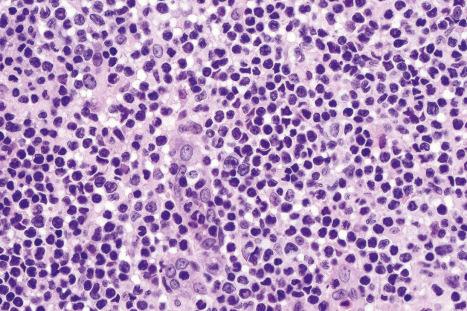
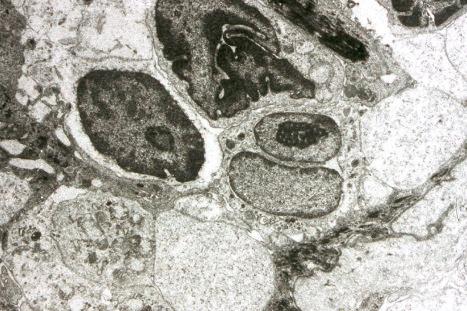
Epidermotropism is, therefore, the histologic hallmark of MF. It is related to the stage of the disease and the degree of differentiation of the lymphocytes. With the development of tumor stage MF, large transformed cells are conspicuous and epidermotropism is commonly lost. Epidermotropism as seen in cutaneous T-cell lymphoma differs from exocytosis of lymphocytes as seen in dermatitis/eczema in that there is usually no or only very mild spongiosis and vesiculation is not usually a feature. The presence of atypical lymphoid cells in an intraepidermal vesicle (the Pautrier microabscess) is typical, although not diagnostic, of mycosis fungoides ( Fig. 29.17 ). Similar features may be seen, though less often, in Sézary syndrome, adult T-cell leukemia/lymphoma (ATLL), actinic reticuloid, and drug-induced T-cell pseudolymphomas.
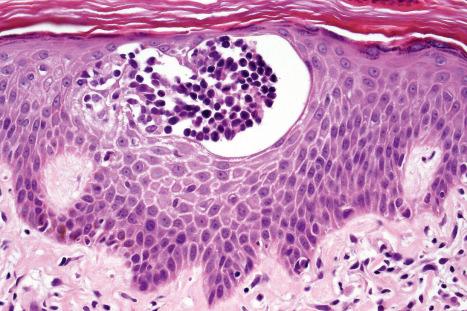
The histopathological features of the early patch stage of MF are usually subtle and easily overlooked ( Fig. 29.18 ). Multiple biopsies are commonly necessary to reach a diagnosis. The epidermis may be of normal thickness, slightly acanthotic, or less commonly atrophic, and often there is mild hyperkeratosis with focal parakeratosis. Basal cell hydropic degeneration is sometimes noted. Within the epidermis, there are characteristically small numbers of atypical irregular lymphoid cells, each surrounded by a clear halo, although in very early lesions they may sometimes be absent ( Fig. 29.19 ). Occasionally, small numbers of larger typical cells may also be evident. Palisading of lymphocytes along the basal layer of the epidermis is a diagnostic pointer. Individual necrotic keratinocytes are seen in some cases. A lymphohistiocytic infiltrate surrounds the vessels of the superficial vascular plexus and extends into the papillary dermis ( Fig. 29.20 ). Eosinophils and plasma cells are present in small numbers or absent. Red cell extravasation is sometimes evident. Pigmentary incontinence is common. The connective tissue of the papillary dermis is occasionally increased with coarsening of the collagen bundles (although this is more typical of plaque stage disease). In the more advanced patch stage, increasing numbers of atypical cells may make the diagnosis more obvious, although frank Pautrier microabscesses are uncommon ( Figs 29.21 and 29.22 ).
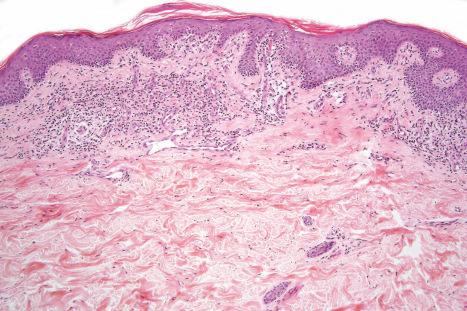
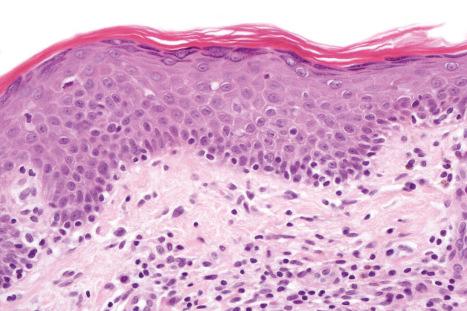
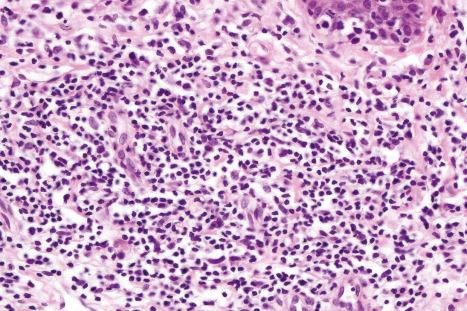
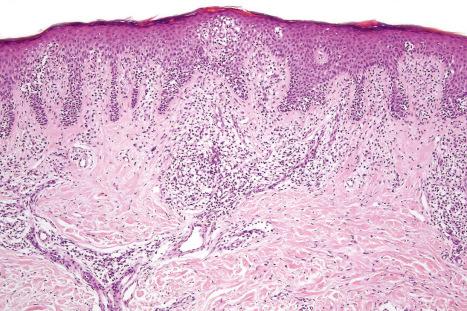
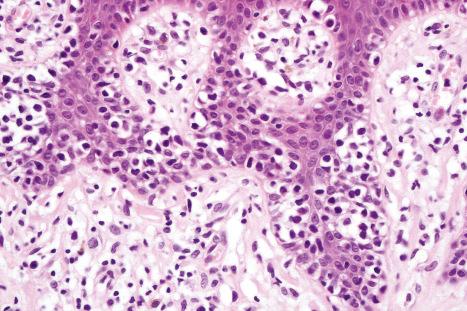
Sometimes, prior treatment with steroids or PUVA before biopsy masks the features, making the diagnosis virtually impossible, emphasizing the necessity for careful clinicopathological correlation ( Figs 29.23–29.26 ).
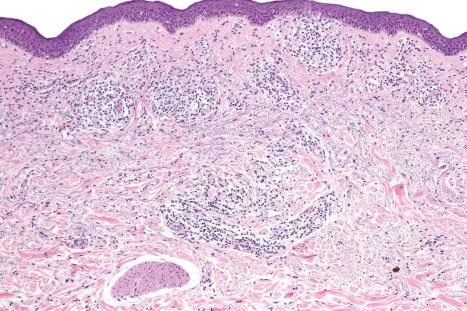
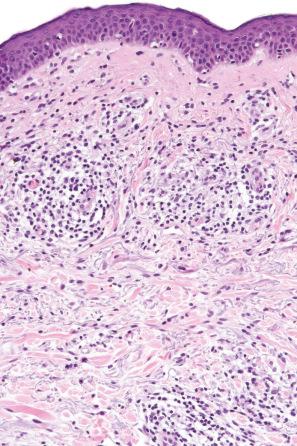
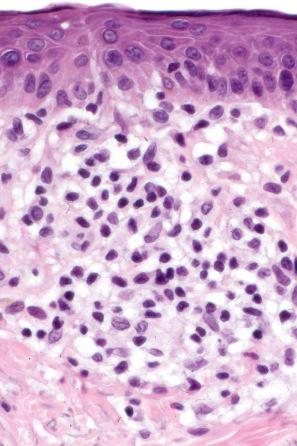
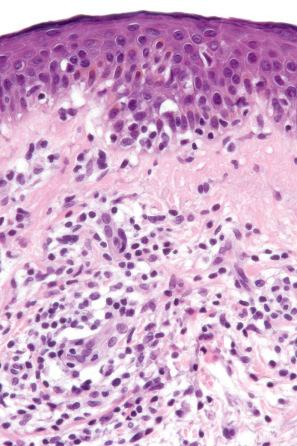
In established plaque stage disease, there is usually little difficulty in establishing the correct diagnosis. There is compact hyperkeratosis, patchy parakeratosis, and the epidermis is commonly acanthotic, frequently adopting a psoriasiform appearance ( Fig. 29.27 ). The infiltrate is much more intense than in the patch stage, and large numbers of atypical mononuclear cells are commonly present in the epidermis ( Figs 29.28 and 29.29 ). Occasionally, however, epidermotropism is absent, particularly in patients who have been treated topically. In the dermis, the distribution is predominantly superficial and bandlike in character. Mycosis/Sézary cells may be present singly or in clusters or exceptionally replace almost the entire epidermis.
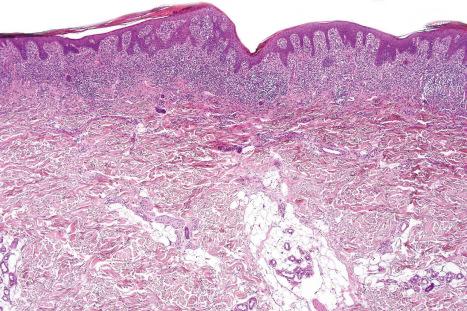
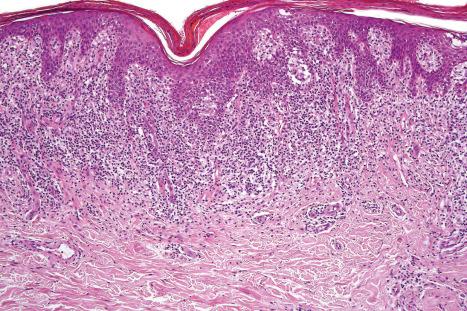
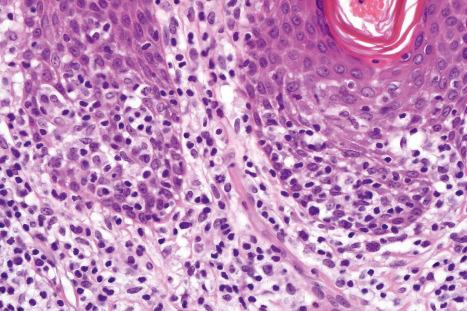
Pautrier microabscesses are not uncommon, being identified in 17–37.5% of cases. The infiltrate may obscure the dermal–epidermal junction, and cytoid bodies are sometimes present. Occasionally, the additional histologic features of confluent hyperkeratosis, irregular acanthosis, extensive basal cell hydropic degeneration, and apoptosis mimic lichen planus.
In addition to the epidermal changes, follicular epithelium may be involved, and sometimes follicular mucinosis is evident. There may also be infiltration of sweat duct epithelium by the malignant cells (syringotropism).
In poikilodermatous lesions, the epidermis is typically flattened, atrophic, and covered by a scale of hyperkeratosis or parakeratosis ( Fig. 29.30 ). Hypergranulosis is not usually a feature. Necrotic keratinocytes are occasionally seen. There is often hydropic degeneration of the basal layer of the epidermis ( Fig. 29.31 ). Epidermotropism is a constant feature and occasionally mycosis/Sézary cells may be noted. In the dermis, there is a bandlike or perivascular lymphohistiocytic infiltrate. Pigmentary incontinence is usually a feature, and often telangiectatic vessels are evident. The superficial dermis may be scarred.
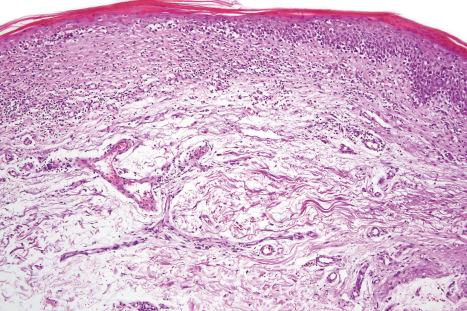
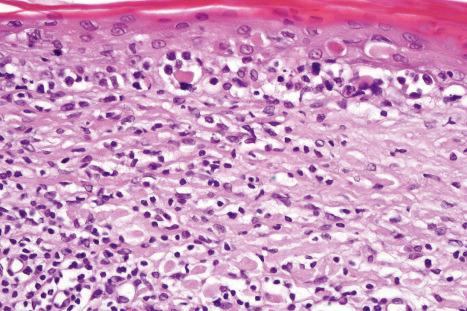
Verrucous lesions which show pseudoepitheliomatous hyperplasia and crusting with associated hyperkeratosis and parakeratosis may be clinically confused with deep mycoses and even keratoacanthoma.
The dermal infiltrate often contains an admixture of reactive inflammatory cells, including eosinophils, plasma cells, and histiocytes, in addition to atypical lymphocytes. Occasionally, multinucleate giant cells are evident and mitoses are sometimes seen. Coarse collagen bundles with or without increased numbers of fibroblasts are commonly present in the papillary dermis ( Figs 29.32 and 29.33 ).
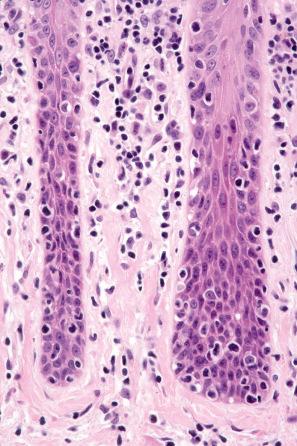
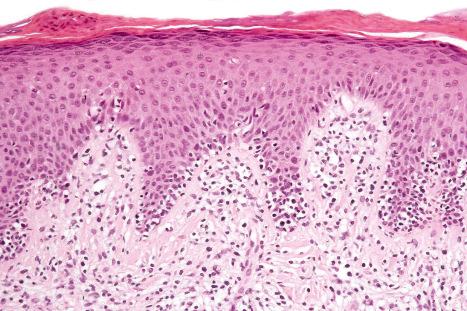
In tumor stage MF, a very dense infiltrate occupies the dermis, sometimes extending into the subcutaneous fat ( Figs 29.34–29.38 ). A top-heavy configuration may be apparent. The lesions are often ulcerated, and epidermotropism is typically either slight or absent. The infiltrate, which may be diffuse or show an ill-defined nodular outline, in addition to containing mycosis/Sézary cells, often has large numbers of highly pleomorphic cells. Mitotic figures are conspicuous and frequently abnormal.
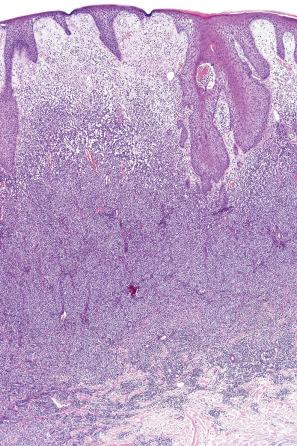
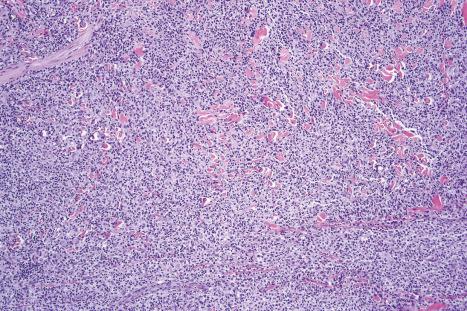
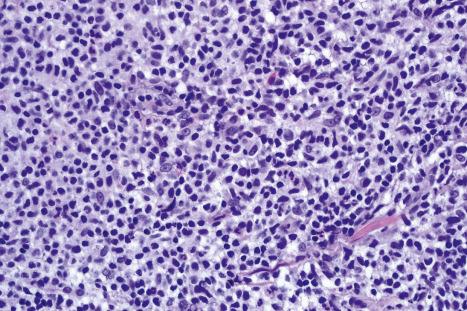
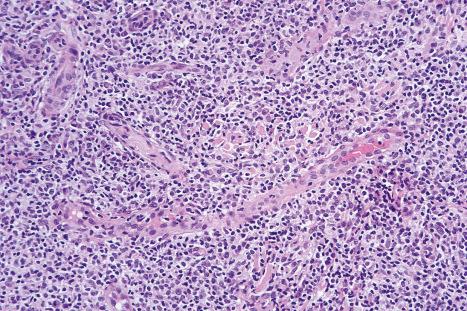
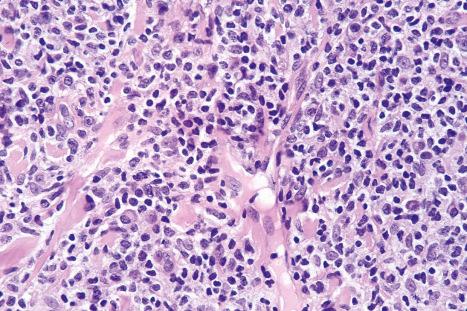
A broad spectrum of histologic changes has been described in biopsies of early stage MF, and many of these overlap with features seen in inflammatory dermatoses. The following have been reported to be useful when trying to establish a definite diagnosis in such situations:
lymphocytes in linear array at the dermal–epidermal junction (linear epidermotropism),
hyperconvoluted lymphocytes within the epidermis (epidermal cerebriform cells),
disproportionate epidermotropism,
Pautrier microabscesses,
epidermal lymphocytes larger than dermal lymphocytes,
wiry bundles of papillary dermal collagen associated with a lichenoid infiltrate,
lymphocyte atypia, although characteristic, is often not apparent in early lesions,
mitotic activity is of little value in early disease.
However, two multivariate analyzes produced conflicting results as to which of these features was the most helpful. This emphasizes the need for good clinicopathological correlation, and is the reason why diagnostic algorithms incorporating clinical, pathological, and molecular findings have been proposed (see below). It is also important to be aware of a patient's current treatment when assessing a biopsy specimen, since local treatments may mask any tendency to epidermotropism.
MF is commonly characterized by accumulation and proliferation of CD4+, CD45RO-positive helper/memory T lymphocytes, although occasionally a CD8+ and even CD4/CD8-phenotypes may be seen ( Figs 29.39 and 29.40 ). The latter has no bearing on prognosis. The lymphocytes usually also express the pan-T-cell antigens CD2, CD3, CD5, and CD7, as well as TCRαβ and cutaneous lymphocyte antigen (CLA). CD7 is often focally lost very early, and it is not of diagnostic value as its expression is also often lost in reactive conditions ( Fig. 29.41 ), as are less frequently CD2, CD3, or CD5. CD25 (IL-2 receptor) is positive in up to 50% of cases, and the T-follicular helper cell marker, PD1, is also frequently expressed. CD30 expression correlates with transformation but has no prognostic implications. Unlike some other cutaneous T-cell lymphomas, MUM1, as identified by the MUM1p antibody, is rarely expressed. Aberrant expression of CD20 is occasionally seen, and this is not associated with expression of other B-cell markers. Expression of TCRγδ is rarely found, and this has no bearing on behavior or prognosis in the context of classic cutaneous T-cell lymphoma (mycosis fungoides).
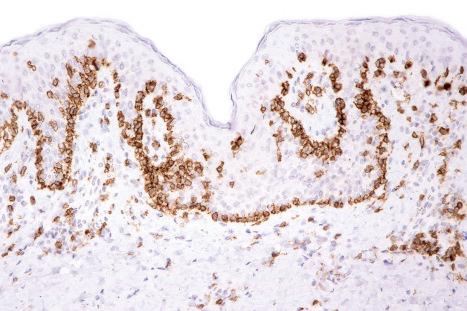
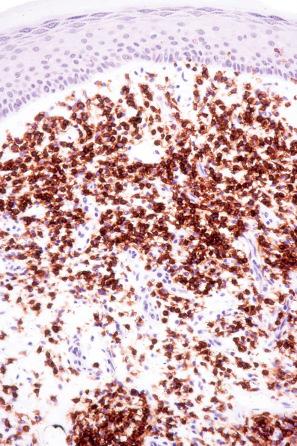
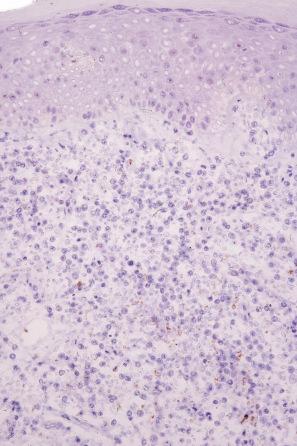
Evidence of a clonal T-cell receptor gene rearrangement may be identified by Southern blot or polymerase chain reaction (PCR) in the majority of cases. Overall, TCR gene rearrangements can be anticipated in up to 100% of cases of tumor stage, 50–100% of plaque stage, and 50–78% of patch stage MF. The results should, however, be interpreted with caution since TCR gene rearrangements have been described in a number of inflammatory dermatoses including discoid lupus erythematosus, lichen planus, lichen sclerosus, and pityriasis lichenoides et varioliformis acuta (PLEVA).
Lymphadenopathy is frequently present in MF but does not always correlate with histologic evidence of lymphomatous involvement. The features of dermatopathic lymphadenitis are characterized by a marked infiltration of the nodal paracortical region by large numbers of histiocytes, including interdigitating reticulum cells and Langerhans cells. Occasional plasma cells and eosinophils may be present. The histiocytes often contain melanin. At this stage, there is no distortion of the lymph node architecture. With progression, careful study of the paracortex may reveal infiltration by mycosis/Sézary cells ( Fig. 29.42 ). These are best identified around the postcapillary venules ( Figs 29.43 and 29.44 ). At first, they may be present singly or in small groups, but in advanced disease sheets of tumor cells are evident and the nodal architecture is effaced.
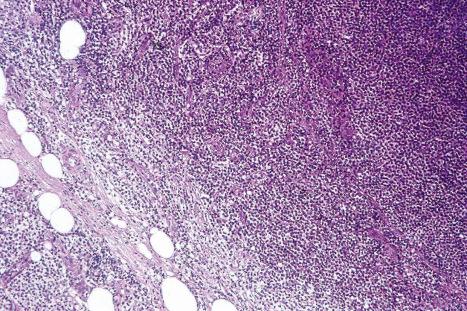
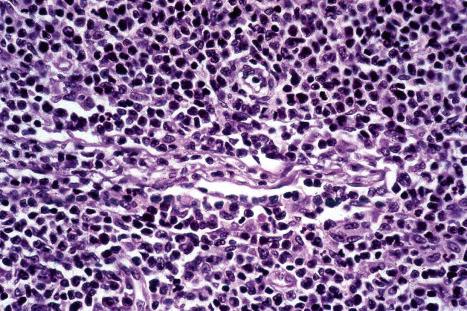
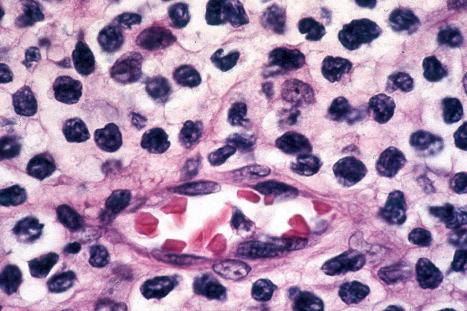
Historically, two histologic staging systems have been used to document the degree of lymph node involvement. Both record the number and distribution of ‘abnormal’ lymphocytes within the nodal parenchyma, but differ in their definition of what constitutes ‘abnormal’. In the NVI/VA system, neoplastic cells are defined as lymphocytes with cerebriform, irregularly folded, hyperconvoluted nuclei irrespective of size. The Dutch system only accepts cerebriform cells >7.5 microns in diameter as neoplastic. Both of these approaches have been incorporated into a simplified version in the proposed ISCL/EORTC staging system. In this, minor degrees of lymph node involvement are grouped with changes of dermatopathic lymphadenopathy, since the prognostic impact of the former is unclear. Partial and complete effacement of lymph node architecture clearly impacts on survival and is worthy of separate consideration. The results of clonality studies can also be included in lymph nodes showing possible early involvement. However, there is no clear evidence that the presence of a clone detected by PCR in an uninvolved or minimally involved lymph node has any added impact on outcome. The definitions of the various stages are summarized below, and a comparison of the various systems is shown in Table 29.4 :
N0N: clinically abnormal nodes therefore no biopsy required (abnormal node ≥1.5 cm),
N1: clinically abnormal nodes; dermatopathic lymphadenopathy; atypically lymphocytes may be present but only singly or in small clusters (3–6 cells),
– N1aNo: evidence of monoclonal T-cell population by PCR,
– N1b: clonal T-cell population detected by PCR,
N2: clinically abnormal nodes; aggregates of atypical cells present but nodal architecture preserved,
– N2aNo: evidence of monoclonal T-cell population by PCR,
– N2b: clonal T-cell population detected by PCR,
N3: clinically abnormal nodes; partial or complete effacement of nodal architecture,
Nx: clinically abnormal nodes; no histologic confirmation.
| Updated ISCL/EORTC classification | Dutch system | NCI-VA classification |
|---|---|---|
| N1 | Grade 1: dermatopathic lymphadenopathy | LN0: no atypical lymphocytes seen LN1: scattered atypical lymphocytes, not in clusters LN2: many atypical lymphocytes arranged in clusters of 3–6 cells |
| N2 | Grade 2: early involvement by mycosis fungoides | LN3: aggregates of atypical lymphocytes observed but lymph node architecture preserved |
| N3 | Grade 3: lymph node architecture partially effaced by lymphoma Grade 4: complete effacement of lymph node architecture by lymphoma |
LN4: partial or complete effacement of the lymph node architecture by lymphoma |
Skin biopsies from patients with MF often show features that are also seen in various benign dermatoses. Patch stage mycosis fungoides must be distinguished in particular from chronic superficial dermatitis, which is typically a mild spongiotic process. Lymphocyte atypia and epidermotropism are not features. Lymphomatoid drug reactions may be histologically indistinguishable from MF. Differential diagnosis requires consideration of a constellation of clinical, histologic, immunohistochemical, and molecular features. This is recognized in the diagnostic algorithm recently proposed by the ISCL. This system assigns weighted scores to multiple criteria, up to a maximum of six, a diagnosis of MF requiring a total of at least four. This is an eminently sensible approach, but as yet there are only limited reports of its usefulness.
MF showing marked epidermotropism should be distinguished from CD8+ primary cutaneous epidermotropic T-cell lymphoma. ATLL commonly presents with histologic features indistinguishable from mycosis fungoides.
Tumor stage MF may be confused with other lymphomatous infiltrates, particularly if the cells are very pleomorphic and especially if epidermotropism is absent. Often, only careful review of the clinical information, taken in conjunction with the histologic features of previous biopsies (if available) and immunohistochemistry, allows the correct diagnosis to be made.
Large cell transformation in MF occurs in 10–23% of cases in larger series in which all stages of mycosis fungoides are included as the denominator. Transformation is associated with a very poor prognosis and predicts for inferior outcome even in patients with advance stage disease. Median survival from transformation ranges from 11 to 36 months.
The pathogenesis of large cell transformation in MF is unknown. p53 overexpression has been correlated with transformation, but this is not associated with a p53 gene mutation and is of uncertain significance. More recently, loss of CDKN2A/CDKN2B as well as overexpression of micro-RNAs miR-93-5p, miR-181a, miR181b, miR-34a, and miR-326 have been documented at high frequency in transformed MF, but the role these abnormalities play in disease progress remains undetermined.
Large cell transformation may be recognized when the infiltrate contains 25% or more large cells or if there is a discrete tumor cell nodule ( Fig. 29.45 ). Large cells are defined as being four or more times the size of a small lymphocyte. They have prominent vesicular or hyperchromatic nuclei, often with conspicuous nucleoli and abundant cytoplasm ( Fig. 29.46 ). Nuclear pleomorphism is common, and giant cells (including Reed-Sternberg-like variants) are sometimes present. Mitotic activity is usually marked and abnormal forms may be identified ( Figs 29.47 and 29.48 ). Although in most instances the tumor is of the large cell phenotype, pleomorphic and immunoblastic variants have also been documented. The immunophenotype is similar to prototypical mycosis fungoides, although there is more frequent loss of CD7, CD2, and CD5. The transformed tumor cell population is typically CD4+ although these may acquire a cytotoxic phenotype with expression of cytotoxic molecules such as TIA-1, perforin, and granzyme B. Exceptionally, CD8+ variants have been described. Some degree of CD30 expression is seen in 30–50% of cases, and in half of these, 75% of the infiltrate express this antigen. Expression of CD30 is not associated with prognosis. CD25 expression is also seen in many cases ( Fig. 29.49 ). In addition, although small and large B cells are often prominent in infiltrates of transformed MF, aberrant CD20 expression has also been confirmed on the surface of the neoplastic T cells.
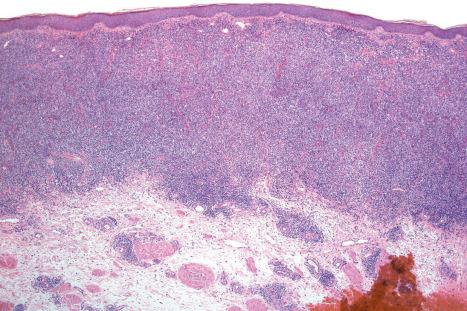
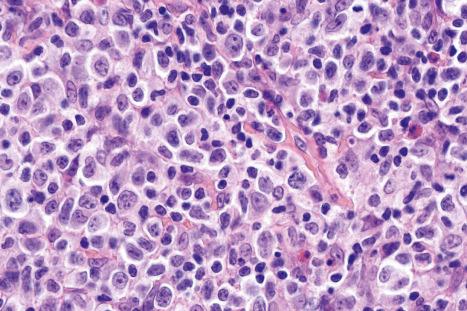
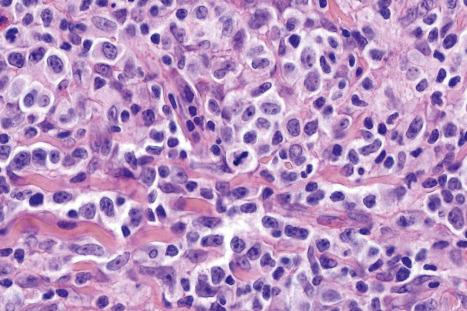
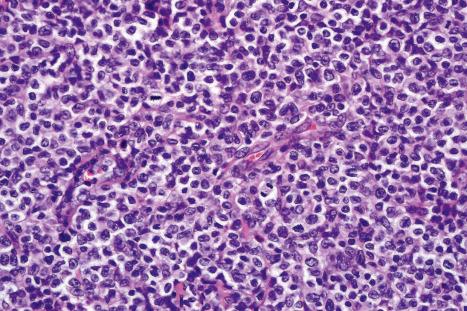
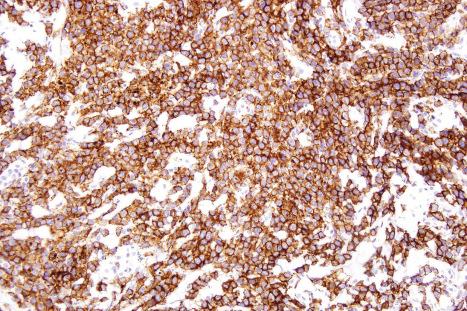
It is most important to distinguish CD30-positive large cell transformation from lymphomatoid papulosis or cutaneous anaplastic large cell lymphoma, which may also develop in patients with MF (especially lymphomatoid papulosis). Both conditions can be distinguished on clinical grounds, and clinical course is often the only distinguishing feature.
This section describes a group of mycosis fungoides cases with unusual clinical features that run a similar course of classic MF. They may display overlapping features, and can be seen in patients with otherwise typical lesions of MF.
Mycosis fungoides in children and adolescents accounts for 0.5–2.7% of cases in the literature. In one population-based registry, the incidence of MF in patients under 20 years of age was 0.05 per 100 000 persons. In addition, in young adults with MF, presentation may well have been much earlier although this has not necessarily been documented. The youngest patient documented was 22 months at diagnosis. As in adults, males are affected more often than females.
In most patients, presentation is as patch or plaque stage disease, and hypopigmented variants are particularly prevalent in childhood ( Fig. 29.50 ). Exceptionally, unilesional disease has been documented. Although there are very rare cases in which children have developed fatal tumor stage disease, leading some authors to postulate that the prognosis in children is worse than in adults, these are very much in the minority. In general, prognosis is good and relates to the disease stage. In fact, it has been shown that children fare slightly better than adults overall in terms of both 5- and 10-year survival (93% vs. 81% and 74% vs. 68%, respectively) although this does not reach statistical significance.
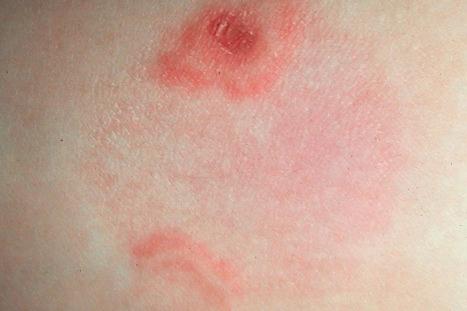
HTLV-I serology has been positive in one documented patient with hypopigmented lesions. The significance of this is uncertain.
MF in childhood and adolescence is histologically indistinguishable from the disease in adults ( Fig. 29.51 ).
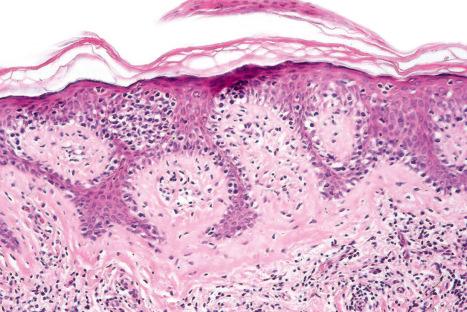
The immunophenotype in most cases is CD2+, CD3+, CD4–, CD5+, CD7–, and CD8+. A CD8+ phenotype is also commonly encountered in hypopigmented variants (see below).
Mycosis fungoides associated with hypopigmentation is a rare occurrence and may be clinically confused with vitiligo, pityriasis alba, tinea versicolor, annular lichenoid dermatosis, and postinflammatory hypopigmentation. It is more often seen in children and adolescents. The sex ratio is equal. Dark-skinned patients are particularly affected, although there is a small number of reports in Caucasians ( Figs 29.52 and 29.53 ). Patients present with asymptomatic or rarely pruritic, slightly scaly, hypopigmented patches, most often affecting the trunk and extremities. Very occasionally, a macular presentation is seen. In general, this variant is indolent with a good prognosis. Exceptional cases of markedly hyperpigmented MF have been documented.
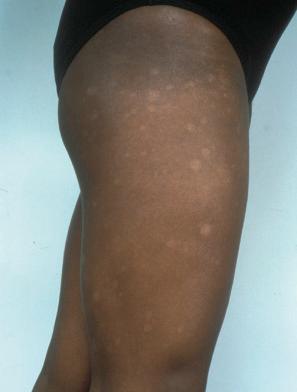
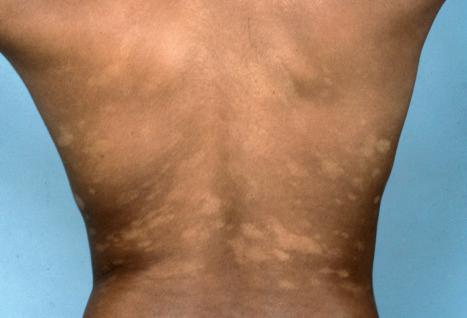
The pathogenesis of hypopigmentation is uncertain. Ultrastructural studies have been conflicting. Some authors have demonstrated melanocyte degenerative changes including dilatation of the rough endoplasmic reticulum, mitochondrial swelling, cytoplasmic vacuolation, and incompletely melanized melanosomes with keratinocytes containing normal numbers of melanosomes. These changes are thought to represent a non-specific response to cellular injury with no evidence of a block of melanosome transfer to keratinocytes. Other authors, however, have documented impaired melanosome transfer in the absence of any evidence of melanocyte injury.
Histologically, hypopigmented lesions are usually indistinguishable from classical mycosis fungoides except for the presence of very marked pigment incontinence. Some reports note striking epidermotropism mimicking pagetoid reticulosis. The immunophenotype is also usually identical. There is a number of reports of cytotoxic suppressor CD8+ T cells predominating in the epidermal infiltrate, which probably reflects the disproportionate number of childhood and juvenile-onset cases in most series.
Hyperpigmented lesions have been characterized by marked elongation of the rete ridges with increased pigmentation and conspicuous dermal melanophages superimposed upon the changes of MF.
There is only a small number of cases documenting presentation of MF as acquired ichthyosis. In one study, they accounted for 3.5% of all patients with MF. Patients have generally shown a fine scaly eruption resembling autosomal dominant ichthyosis vulgaris. The condition may be localized to the lower limbs or may be more widespread. A more typical presentation of MF may be seen. Comedo-like lesions have also been described overlapping with folliculotropic MF.
Histologically, the features of ichthyosis (hyperkeratosis, acanthosis with a thinned granular cell layer) are superimposed upon MF. The immunophenotype when reported has usually been CD2+, CD3+, and CD4+, with loss of CD7, apart from one CD8+ case.
Bullous MF is exceptional. Lesions, which may resemble bullous pemphigoid, pemphigus vulgaris, or pemphigus foliaceus, can be generalized, although in some reports there is a predilection for the palms and soles. Superimposed allergic contact dermatitis following topical therapy may give rise to spongiotic vesiculation.
The blisters may be subcorneal, intraepidermal, or subepidermal, although the last are most common ( Fig. 29.54 ). They develop as a result of tumor cell infiltration with possible cytokine release rather than as a consequence of a coexistent autoimmune bullous dermatosis. Immunofluorescence is invariably negative.
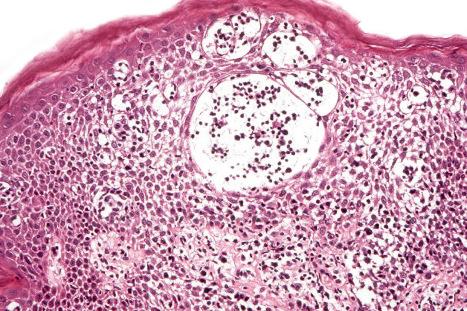
Gram stain and periodic acid-Schiff (PAS) should be performed to exclude secondary infection. Vesiculobullous mycosis fungoides must be distinguished from bullous pemphigoid arising in patients with pre-existent mycosis fungoides and sometimes complicating PUVA, ultraviolet (UV) B therapy, or other treatments such as topical methchlorethamine and interferon (IFN)-alpha.
Pustular lesions are very rare in cutaneous T-cell lymphomas including MF and erythrodermic variants such that there can be confusion with pemphigus and subcorneal pustular dermatosis. A palmoplantar pustulosis-like variant has also been documented. Similar lesions may be encountered in patients with psoriasis and MF.
The cause of pustulation is unknown. Histologically, the pustular lesions may be related to subcorneal neutrophil abscesses (i.e., true pustules) or else reflect conspicuous Pautrier microabscesses ( Fig. 29.55 ).
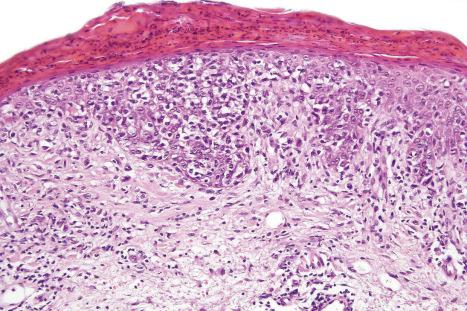
PAS and Gram stains should be performed to exclude a secondary infection. Pustular lesions have been described in a patient with MF as a result of demodex folliculitis.
Exceptionally, MF presents with purpuric lesions simulating a pigmented purpuric dermatosis. However, in the latter, the eruption is generally restricted to the lower legs, whereas in MF the eruption is more often generalized and there is usually a background of more typical clinical lesions.
Histologically, there can be considerable overlap with both conditions showing lymphocytes aligned along the epidermal side of the dermal–epidermal junction, red cell extravasation, and hemosiderin deposition ( Figs 29.56 and 29.57 ). In purpuric mycosis fungoides, however, the epidermotropism is likely to be more marked and the dermal infiltrate tends to be deeper and denser. In addition, careful scrutiny is necessary for atypical lymphocytes present in mycosis fungoides and not in pigmented purpuric eruptions. Although theoretically a clonal T-cell population could be taken as supportive of a diagnosis of a lymphomatous process, clonal populations have been identified in a background of otherwise typical pigmented purpura.
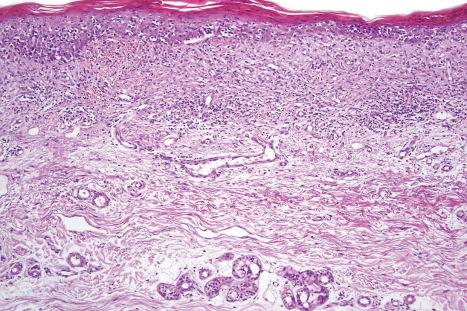
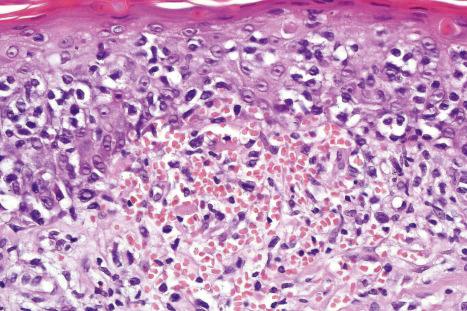
In the vast majority of cases, pigmented purpuric dermatosis tends to be self-limited, resolving in a few months or sometimes years, and does not progress to mycosis fungoides. There are, however, a sufficient number of cases where pigmented purpura appears to have progressed or been associated with lymphoma so that a prolonged and careful follow-up is warranted.
Palmar and plantar involvement during the course of MF occurs in up to 11.5% of patients. Purely palmar/plantar involvement is exceedingly rare, accounting for only 0.6% of cases in a series of 722 patients with mycosis fungoides. Patients present with erythematous, hyperkeratotic, scaly palmar, and/or plantar plaques that may be initially misdiagnosed as contact dermatitis, palmoplantar psoriasis, dermatophyte infection, or pompholyx.
The literature concerning this condition is confusing. While some authors have used the term to describe a variant of MF, others have used it synonymously for pagetoid reticulosis. Although there are undoubtedly similarities, palmoplantar MF contrasts with pagetoid reticulosis by the invariable CD4+ T-helper nature of the infiltrate in contrast to pagetoid reticulosis where the immunophenotype is CD8+ or CD4–/CD8– as often as it is CD4+ and in which the infiltrate is almost entirely epidermotropic.
Very rarely, patients with MF present with large verrucous crusted lesions that may be clinically mistaken for a halogenoderma, or deep fungal or atypical mycobacterial infection. Lesions are sometimes quite widespread. Occasionally, they are located acrally and might then be better classified as palmoplantar MF or pagetoid reticulosis.
Unilesional (solitary) MF is very rare. Patients usually develop a solitary, slowly growing patch or plaque, typically on the trunk or upper extremity. Although most documented cases have been in adults, there are occasional instances of childhood presentation. Folliculotropic and hypopigmented variants have been reported. Although complete remission is generally achieved following treatment (e.g., with excision, localized electron beam therapy or topical nitrogen mustard), occasional recurrences have been noted and noncontiguous spread may occur after many years. Systemic spread and death have not been described, reflecting the excellent prognosis of early-stage disease.
Histologically, unilesional MF is indistinguishable from the more usual multilesional variant. Clonal TCR gene rearrangements are present in up to 50% of cases.
It has long been recognized that clinically normal skin may be affected histologically in MF. Exceptionally, MF may present with intense pruritus and no clinically visible lesions but with evidence of histologic involvement – so-called invisible mycosis fungoides.
A minority of cases of otherwise classic MF display unusual histologic features. These have perhaps been granted unwarranted significance in the literature through designation with specific names. Nevertheless, although not biologically distinct entities, these different histologic patterns merit recognition in order to heighten awareness of the spectrum of changes that can be seen in MF. Spongiosis is sometimes prominent, and in other cases a bandlike infiltrate closely mimicking lichen planus may be seen. In the former situation, the underlying changes are those of MF, and in the latter scenario there is often migration of lymphocytes above the basal cell layer of the epidermis, lymphocytes appear to extend into basal keratinocytes rather than stay in the junction as they do in lichen planus, and other features of MF are present.
A granulomatous infiltrate is seen in up to 4% of cases of MF. The clinical features are indistinguishable from those of typical MF; patients present with papules, plaques, and tumors, and may run a stepwise progression ( Fig. 29.58 ). Most reported cases have been described in adults, but exceptional cases occur in children. It may rarely be seen in association with sarcoidosis or generalized granuloma annulare, and an ichthyosis-like presentation has been reported. Granulomas are thought to represent an immunologically mediated reaction to the tumor, and was initially supposed to indicate a favorable prognosis. However, there are examples of rapidly progressing forms of the disease, so other factors are likely to be more important in determining outcome.
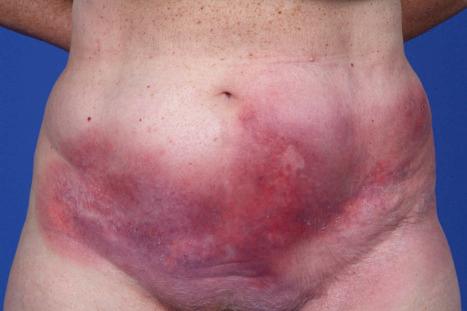
Granulomatous inflammation is also commonly encountered in folliculotropic MF and may be seen in up to one-quarter of cases. In this situation, the granulomatous inflammation represents a reaction to ruptured hair follicles.
In all cases, there are underlying features of MF. The associated granulomas are usually sarcoid type, often accompanied by foreign body and Langhans giant cells ( Figs 29.59–29.61 ). While this may represent only a minor component of the infiltrate, in many cases it can constitute 25% or more with the potential for misdiagnosis as an inflammatory or infective condition. Lymphophagocytosis is sometimes present, and elastophagocytosis is common. In some instances, palisading histiocytic granulomata reminiscent of granuloma annulare or necrobiosis lipoidica are noted ( Figs 29.62 and 29.63 ), whilst in others the granulomata are tuberculoid. Special stains for microorganisms should be performed to exclude an infection.
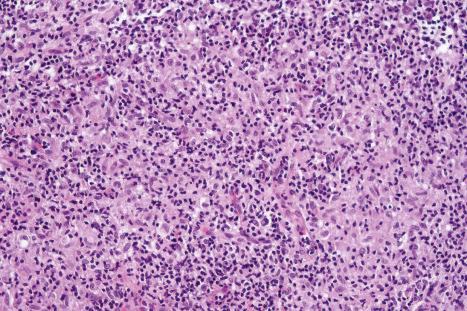
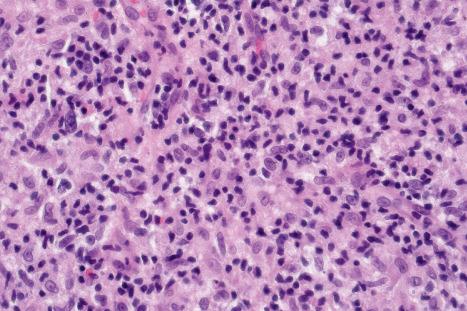
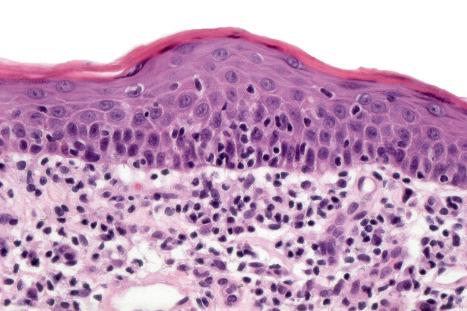
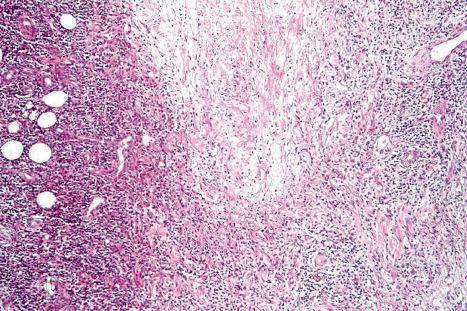
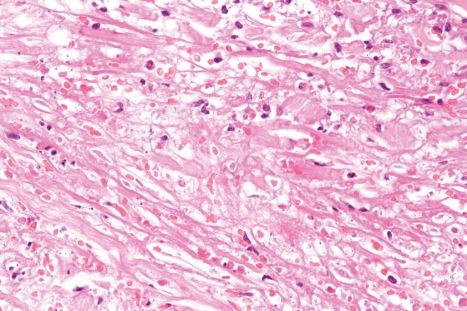
Granulomatous MF can be distinguished from granulomatous slack skin in which the infiltrate is usually much denser and regularly involves the subcutis. The granulomata are generally less well formed, and there is more lymphophagocytosis in the latter. The loss of elastic tissue is typically focal in granulomatous MF, and very prominent in granulomatous slack skin. However, histologic overlap may be seen and reliable distinction relies on clinical correlation.
Granulomatous inflammation has been described as a feature in a range of other cutaneous lymphomas, and these must also be considered in the differential diagnosis. These include subcutaneous panniculitic T-cell lymphoma, Sézary syndrome, small/medium pleomorphic T-cell lymphoproliferative disorder, primary cutaneous anaplastic (CD30+) large cell lymphoma, angioimmunoblastic T-cell lymphoma (AITL), peripheral T-cell lymphoma secondarily involving the skin, and primary cutaneous B-cell lymphoma (PCBCL).
Syringotropism in MF is a very rare occurrence, usually manifesting as small papules arising in a background of patch or plaque stage disease. Less often, it may present de novo. It most frequently accompanies the folliculotropic variant of MF.
The so-called syringolymphoid hyperplasia presenting with localized alopecia and anhidrosis is likely to represent a form of syringotropic T-cell lymphoma. In rare cases, biopsies show subtle changes with no evidence of lymphoid atypia, and these patients should be monitored carefully with repeat biopsies for evidence of lymphoma.
Syringotropism in MF is seen most frequently in males (12 : 5). In general, lesions are localized, presenting as erythematous or brown patches and plaques with superimposed papules, often accompanied by localized hair loss ( Fig. 29.64 ). Ulceration and scarring are not uncommon. Hypoesthesia and anhidrosis may be seen. Because of the deep-seated nature of the infiltrate, response to skin directed therapies may be poor and localized radiotherapy required.
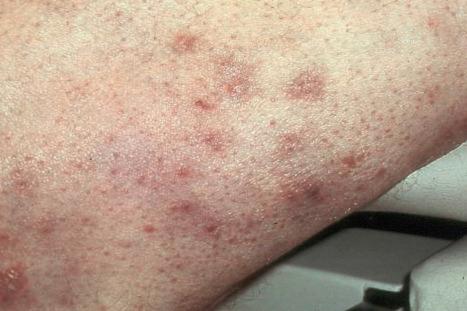
Lesions are characterized by dense lymphoid infiltrates surrounding and infiltrating the sweat gland and ductal epithelium ( Figs 29.65–29.67 ). In those patients in whom a diagnosis of lymphoma is apparent, there are conspicuous atypical lymphoid cells with enlarged, irregular, and hyperchromatic nuclei. The sweat gland epithelium may be hyperplastic, and frequently the lumen is obliterated ( Fig. 29.68 ). Follicular mucinosis or folliculotropic MF is sometimes present and in those lesions arising in a background of typical MF, an atypical superficial dermal infiltrate with epidermotropism is seen.
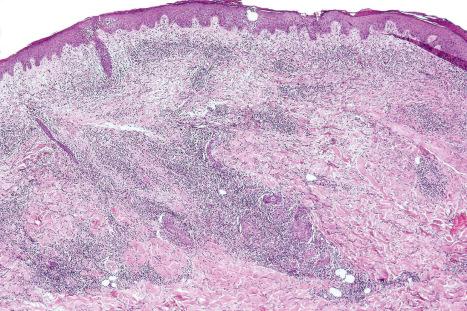
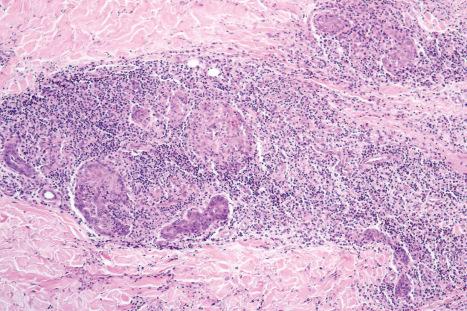
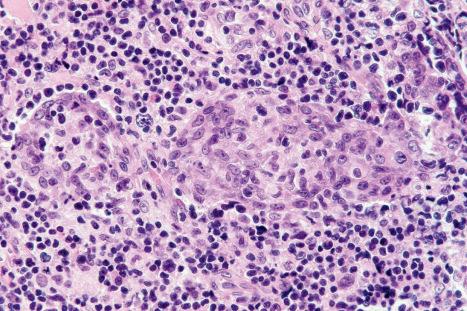
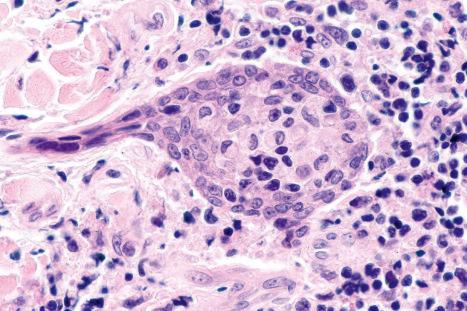
The lymphocytes express CD2, CD3, CD4, and CD45RO. Loss of CD7 has been documented. Keratin immunohistochemistry can be of value in highlighting destroyed sweat gland epithelium. TCR gene rearrangements assists in making the diagnosis.
Very exceptionally, widespread dermal mucin deposition (unrelated to follicular mucinosis) has been described in MF. In one case, mucin deposition was accompanied by a storiform spindle cell proliferation. Clinically, the latter lesions were reminiscent of scleromyxedema. Whether this represents a genuine variant or coincident expression of two disorders is uncertain.
In contrast to the above, the following three entities have distinctive clinicopathological features that mark them out as biologically distinct variants of MF.
Folliculotropic MF is a rare, biologically distinct variant of MF characterized by follicular infiltrates of cerebriform T cells, often with sparing of the epidermis. While a number of cases are associated with follicular mucinosis, this is not a prerequisite for making the diagnosis, despite earlier reports suggesting that lymphomas with and without this feature should be regarded separately. The disease has been described under different names including follicular MF, pilotropic MF, folliculotropic MF, MF presenting with follicular mucinosis, MF-associated follicular mucinosis, and basaloid folliculolymphoid hyperplasia with alopecia.
Follicular MF is more common in middle aged to elderly males. It has predilection for the head and neck, particularly the face and scalp, although lesions are frequently seen on the trunk. Involvement of the limbs may also be seen. Most patients present with patches, plaques, or grouped papules ( Figs 29.69–29.73 ). Tumor stage lesions may also be encountered. Intense pruritus and alopecia are common. Less frequent are acneiform lesions such as comedone-like cysts, pustules, or milia. Some patients present with spiky keratosis. In lesions associated with sweat gland involvement, hypohydrosis may also be a feature. Mucinorrhea and erythroderma are rarely seen.
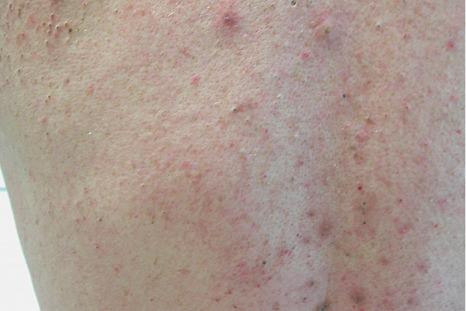
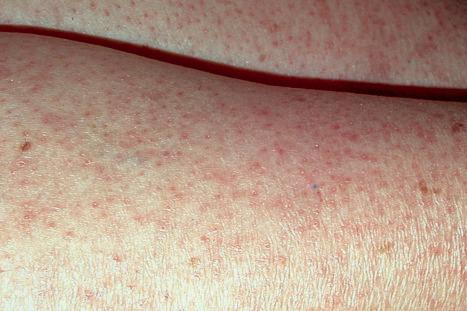
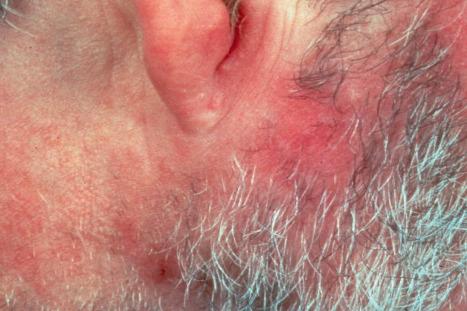
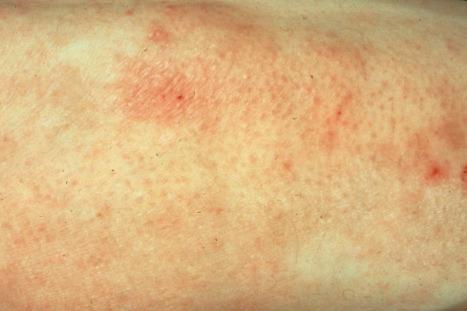
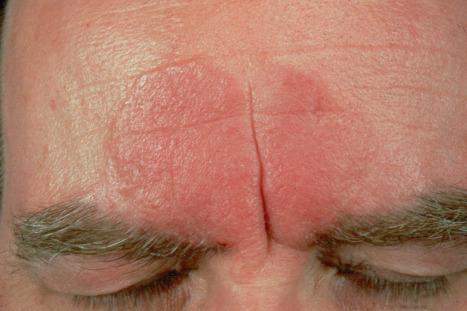
The principal reason for distinguishing folliculotropic MF as a specific entity is because it is more difficult to treat than classic MF and has a higher incidence of disease progression with worse prognosis. Early-stage folliculotropic MF has a significantly poorer progression-free, disease-free, and overall survival than classic MF and displays outcomes more similar to those seen in tumor stage MF. This may in part be due to the fact that folliculotropic MF is generally more refractory to treatment, with lower rates of complete remission. However, even when treated more aggressively at the outset, outcomes are poor, and there may be intrinsic differences in tumor cell biology that contribute to outcome.
The pathogenesis of folliculotropic MF is unknown, although it has been speculated that folliculotropism is mediated through intracellular adhesion molecule 1 (ICAM-1) expression by follicular epithelium and lymphocyte function-associated antigen (LFA-1) expression by the lymphoid cells. Gene expression profiling studies have also shown that folliculotropic MF cases tend to express genes associated with inflammation and pathways involved with epidermal proliferation, and to cluster with cases of typical MF of advanced stage with poor prognosis.
The defining histologic feature of this variant is infiltration of hair follicle epithelium by medium to large cerebriform cells ( Figs 29.74–29.81 ). Collection of acid mucopolysaccharides within the involved follicles (follicular mucinosis) is present to varying degrees but is often absent. Other histologic features include basaloid follicular hyperplasia, granulomatous inflammation, numerous eosinophils in and around hair follicles, and follicular cystic change even with formation of epidermoid cysts and comedone-like lesions. Basaloid follicular hyperplasia refers to the proliferation of basaloid cells extending from follicles, or complete basaloid transformation of hair follicles with infiltrating atypical lymphocytes. Granulomatous inflammation is usually secondary to ruptured hair follicles. Other non-specific changes may be seen including neutrophilic pustular lesions, syringotropism, prominent interface dermatitis of the follicular epithelium or epidermis, and epidermotropism involving nonfollicular epithelium. Not infrequently, blast cells are numerous, and large cell transformation may be seen in some cases.
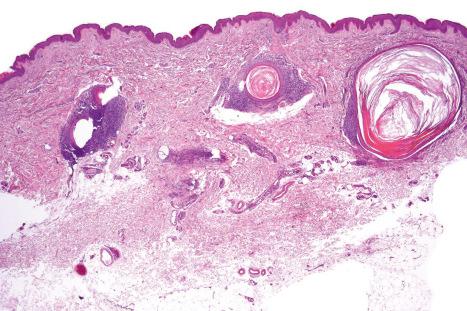
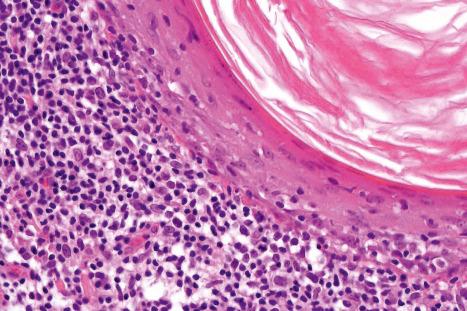
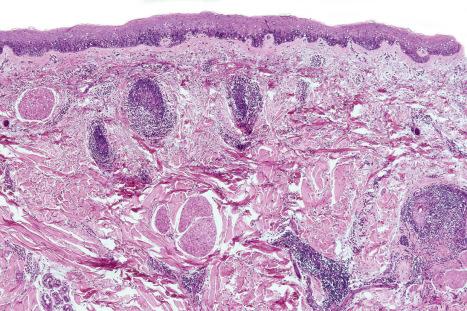
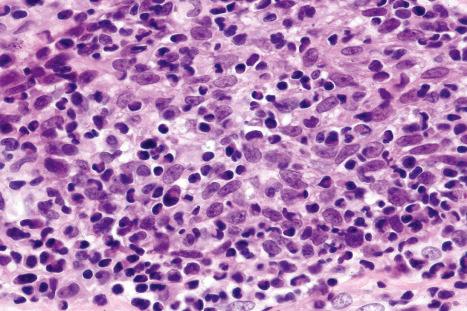
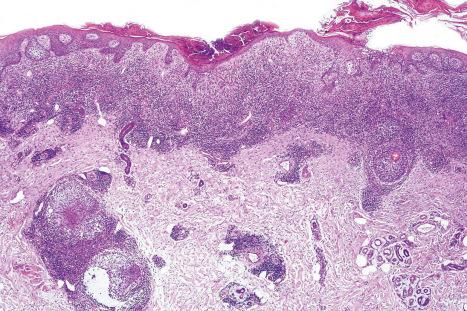
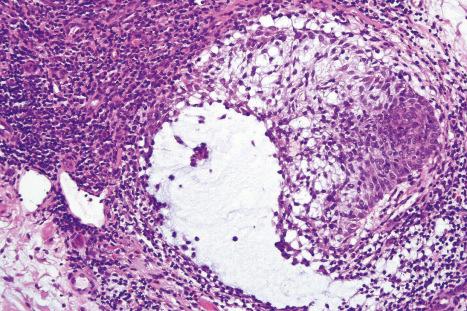
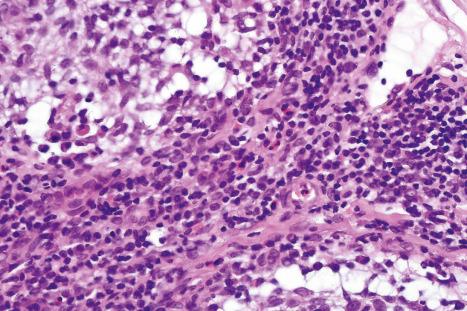
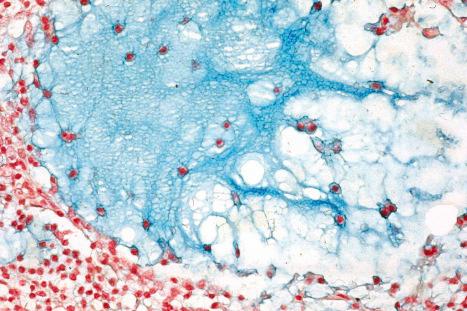
The neoplastic lymphocytes in folliculotropic mycosis fungoides usually have a T-helper phenotype. Blast cells, when present, are often CD30 positive.
Folliculotropic MF must be distinguished from lichen planopilaris, pseudolymphomatous folliculitis, eosinophilic folliculitis, follicular lymphomatoid papulosis, and follicular mucinosis/alopecia mucinosa.
In lichen planopilaris, there is a bandlike infiltrate, colloid bodies are conspicuous, and atypical folliculotropic lymphocytes are lacking. It may be difficult to distinguish folliculotropic MF from pseudolymphomatous folliculitis. In the latter, the hair follicles have an activated appearance, destruction of hair follicles is absent, and lesions tend to be solitary and resolve spontaneously. Although PCR was originally said to show polyclonal patterns of gene rearrangement, examples of ‘clonal pseudolymphomatous folliculitis’ have been described. Follicular mucinosis may be present incidentally or in conditions such as eosinophilic folliculitis of both Ofuji disease and HIV-associated cases, but atypical folliculotropic lymphocytes are not present. Clinical features are more helpful in distinguishing follicular lymphomatoid papulosis from folliculotropic MF, in particular, the presence of crops of spontaneously regressing papules.
The terms alopecia mucinosa and follicular mucinosis have often been used synonymously in the literature, creating much confusion. Follicular mucinosis is a histologic reaction pattern that may be seen in a variety of conditions including Ofuji disease, HIV-associated eosinophilic folliculitis, angiolymphoid hyperplasia, Pityrosporum folliculitis, arthropod bite, melanocytic nevi, and lentigo maligna. Alopecia mucinosa is the term historically given to the constellation of clinical features seen in cases of follicular mucinosis unattributable to other cutaneous or extracutaneous diseases (idiopathic alopecia mucinosa) or when follicular mucinosis occurs in association with MF or Sézary syndrome (secondary alopecia mucinosa) ( Figs 29.82–29.85 ). Most of the latter probably represent examples of folliculotropic MF. Moreover, several studies have demonstrated that there are no repeatable, dependable clinical, histologic, or molecular findings that allow idiopathic alopecia mucinosa to be distinguished from follicular mucinosis associated with lymphoma. This applies even to cases presenting as solitary lesions in young adults, running an indolent course. Over 50% of these cases show a monoclonal pattern of T-cell receptor gene rearrangement by PCR, even when no evidence of overt lymphoma is seen at presentation or during the course of follow-up. It therefore seems likely that ‘idiopathic’ alopecia mucinosa is not a distinct entity, but a form of localized MF with good prognosis, and the term idiopathic alopecia mucinosa should be discontinued. Of course, this interpretation raises questions as to the veracity of the association between folliculotropic MF and poor prognosis. It suggests that folliculotropic MF can show the same spectrum of behavior as classic MF, some cases remaining localized to the skin with the affected patients having a normal life expectancy.
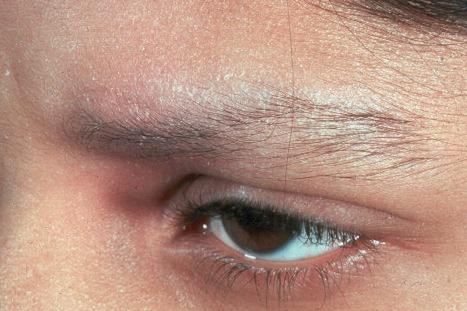
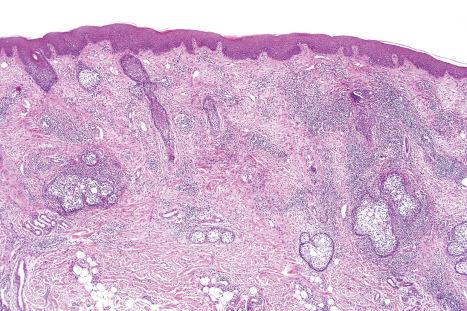
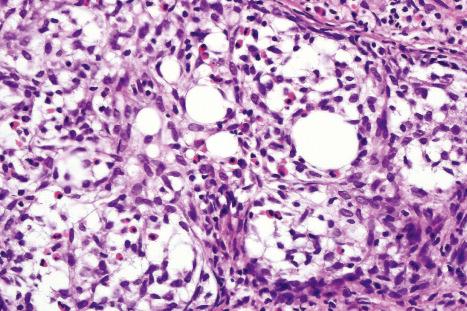
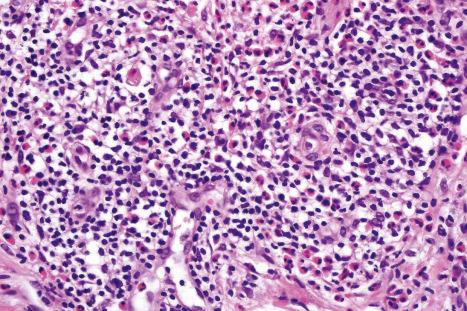
Pagetoid reticulosis (PR) is rare and characterized by localized lesions and a prominent intraepidermal proliferation of neoplastic lymphocytes. Historically, localized and disseminated forms of pagetoid reticulosis have been described under the names Woringer-Kolopp disease and Ketron-Goodman disease, respectively. However, most cases of disseminated pagetoid reticulosis are likely to represent examples of aggressive epidermotropic CD8-positive cutaneous T-cell lymphoma, cutaneous γ/δ T-cell lymphoma, or tumor stage mycosis fungoides, and the term pagetoid reticulosis should be reserved only for the localized form of the disease.
Most cases present as a solitary, erythematous lesion which typically enlarges slowly to form a thick plaque or localized group of plaques, with evolution often taking many years. There is a marked predilection for the extremities. Plaques tend to be scaly and have sharply demarcated borders ( Fig. 29.86 ). They can measure up to 30 cm in diameter. Ulceration, verrucosity, and tumor formation are frequent complications. The lesions can easily be clinically misdiagnosed as a plaque of Bowen disease, superficial basal cell carcinoma, discoid eczema, psoriasis, or even extramammary Paget disease. Regional lymph nodes may be enlarged, although histologically they show reactive changes only. The disorder usually has an indolent course and responds to excision or radiotherapy. However, recurrences either at the same or a distant site are not uncommon. Occasional cases are relatively resistant to therapy and behave in a more progressive fashion. Prolonged follow-up is therefore advisable.
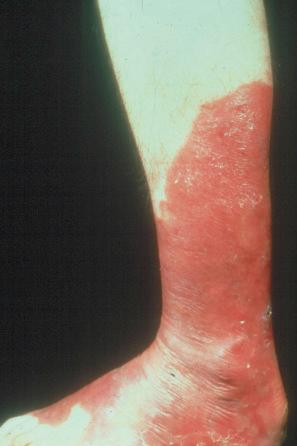
Histologically, PR is characterized by an almost completely intraepidermal infiltrate of atypical mononuclear cells. Occasional reports documenting expression of CLA and α E β 7 (CD103; an adhesion molecule that binds to E-cadherin on epithelial cells) by the tumor cells suggest an important role for adhesion molecules in the extreme epidermotropism characteristic of this condition.
The epidermis shows hyperkeratosis and/or parakeratosis in association with acanthosis, which often adopts a psoriasiform appearance. The epithelium is infiltrated (particularly in the lower reaches) by medium to large lymphocytes with large and irregular nuclei, and abundant vacuolated cytoplasm ( Figs 29.87–29.90 ). A perinuclear halo is commonly present. The cells may adopt a single-cell diffuse distribution, show Pautrier microabscess-like configurations, or be present in large lacunae. Mitotic figures are sometimes conspicuous. Involvement of adnexal epithelium is often a feature. The superficial dermis contains a perivascular lymphohistiocytic infiltrate, but atypical cells are very sparse or absent.
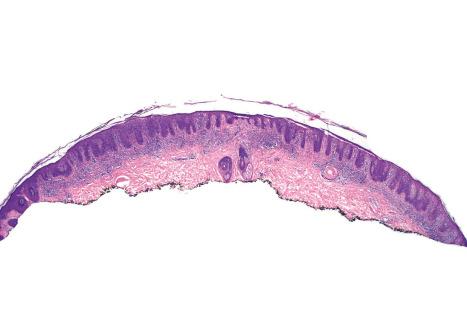
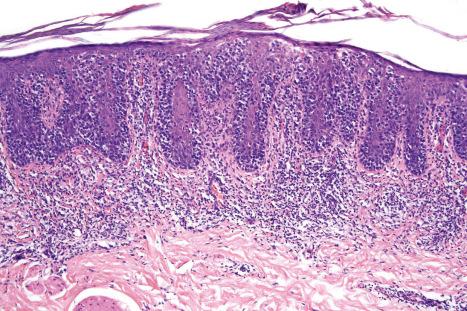
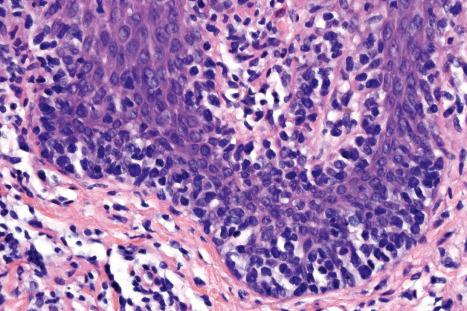
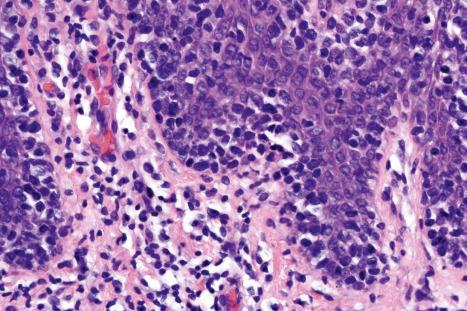
PR represents a proliferative lesion of CD45+ hematopoietic cells that are of T-cell derivation. They show expression of the pan-T-cell antigens CD2, CD3, and CD5, but CD7 is frequently lost or down-regulated ( Fig. 29.91 ). Both T-helper (CD4+) and T-suppressor/cytotoxic (CD8+) phenotypes have been reported. Although CD4/CD8 double negative forms have also been described, such cases may represent examples of γ/δ T-cell lymphomas. Loss of CD45RO (UCHL-1), a marker of memory T cells, has been documented by some authors. High levels of expression of CD30 (>50%) and Ki-67 (50%) may be demonstrated. The dermal infiltrate consists of immunophenotypically normal T cells (CD4+/CD8– and CD4–/CD8+) with an admixture of B cells and macrophages. Keratinocyte HLA-DR expression has been noted. Most cases tested show a monoclonal pattern of TCR gene rearrangement.
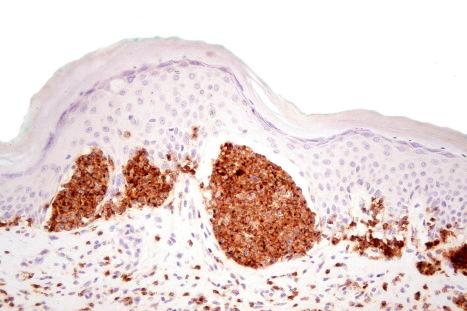
Pagetoid reticulosis should be distinguished from mycosis fungoides palmaris et plantaris. The latter is invariably of a CD4+ phenotype and is clinically characterized by thin plaques in contrast to the thickened and often verrucous lesions of PR. Histologic distinction is mainly based in the presence of prominent epidermotropism in the latter. The main differential diagnosis is with primary cutaneous CD8-positive aggressive epidermotropic cytotoxic T-cell lymphoma. The distinction is mainly clinical as in the latter the disease is aggressive with widespread cutaneous lesions and poor prognosis. Histologically, the appearances are identical, but a number of cases of pagetoid reticulosis have a CD4 phenotype. However, primary cutaneous CD8-positive aggressive epidermotropic cytotoxic T-cell lymphoma tends to display a more prominent dermal infiltrate.
Unlike granulomatous mycosis fungoides, granulomatous slack skin is recognized as a distinct variant of MF in the WHO classification. It is an exceedingly rare disease, with fewer than 50 cases documented to date. It shows a predilection for Caucasians, with male predilection. Most patients are in the third to fifth decades of life. Children are exceptionally affected.
Presentation is initially as asymptomatic, erythematous, or red–purple papules and plaques. With progression, atrophy supervenes with loss of elastic tissue, and boggy pendulous folds of redundant skin reminiscent of cutis laxa develop. There is predilection for the inguinal and axillary regions ( Fig. 29.92 ), although involvement may be more widespread. Lesions may develop de novo or less often present within a background of patch or plaque stage mycosis fungoides. The affected areas are generally resistant to treatment and commonly recur following surgery. Progression is very slow over many years, and by itself does not appear to be life threatening. However, affected patients have high risk of developing a second lymphoma in up to 50% of cases. The latter may arise concurrently, precede, or follow the development of slack skin lesions. In the majority of cases, patients develop Hodgkin lymphoma (HL) or other NHLs. Leukemia and Langerhans cell histiocytosis (LCH) may also occur.
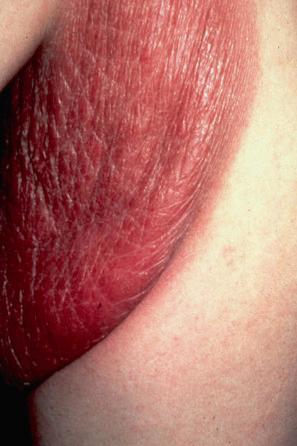
Monoclonal TCR gene rearrangements have been identified in almost all cases tested. Trisomy 8 has been documented in two cases and a t(3;9)(q12;p24) in another. The latter did not involve the JAK2 gene located on chromosome 9p.
In its early stages, the histologic features are reminiscent of evolving mycosis fungoides with focal epidermotropism. Within the superficial dermis is a bandlike or perivascular lymphohistiocytic infiltrate accompanied by multinucleate giant cells. The lymphocytes are irregular and small- to medium-sized with hyperchromatic nuclei. Typical mycosis fungoides/Sézary syndrome cells are sparse or absent.
In established lesions, the histologic features are both dramatic and diagnostic. There is a dense infiltrate of atypical, irregular, and convoluted lymphocytes often involving the dermis and even extending to the subcutis ( Figs 29.93–29.95 ). Mycosis fungoides cells are sometimes conspicuous. Epidermotropism, folliculotropism, and Pautrier microabscesses may be seen but are not usually prominent. Many histiocytes and individual scattered multinucleate giant cells are present in association with the dermal infiltrate and display prominent lymphophagocytosis and elastophagocytosis. Discreet granulomas including noncaseating granulomata are sometimes a feature. The giant cells characteristically have numerous nuclei, and special stains show widespread loss of the dermal elastic tissue. A background population of small lymphocytes, plasma cells, and eosinophils may also be seen. Granulomatous vasculitis has been reported in one patient, and granulomas in the absence of overt lymphoma has been described in lymph nodes and spleen. In addition, dissemination of the neoplastic clone and associated granulomatous inflammation to lymph nodes and bronchus has been reported.
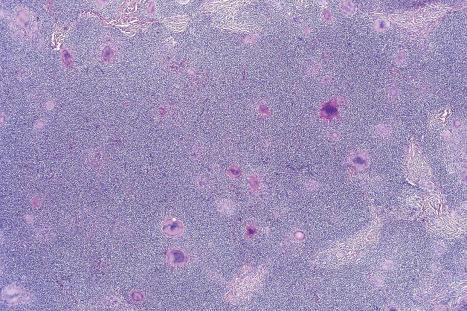
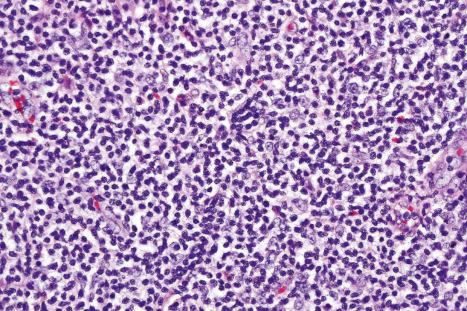
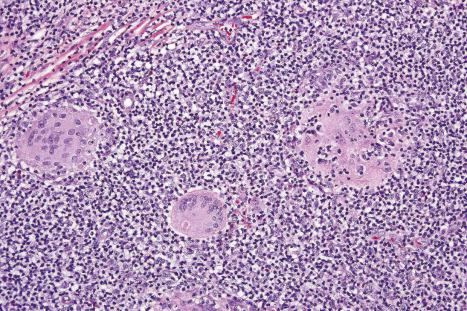
The lymphocytes are predominantly of the helper T-cell phenotype and express CD4 and CD45RO. They may show loss or diminished expression of CD3, CD5, and/or CD7. Rare CD30-positive cells are identified. The giant cells express histiocytic markers. Many of the surrounding histiocytes can be labeled with CD1a, suggesting that they represent Langerhans cells or dermal dendritic cells.
Granulomatous slack skin shows considerable histologic overlap with granulomatous mycosis fungoides, since elastophagocytosis may be a feature of both conditions. Although the distinction is best made clinically, in granulomatous mycosis fungoides elastic tissue loss is typically focal rather than widespread, the giant cells usually contain fewer nuclei than in granulomatous slack skin, and lymphophagocytosis is distinctly uncommon. Other lymphomas that may be associated with prominent granulomatous inflammation should also be considered.
Sézary syndrome is a rare variant of cutaneous T-cell lymphoma, accounting for <5% of cases and characterized by erythroderma, blood involvement, and a poor prognosis. Sézary syndrome belongs to the broader spectrum of erythrodermic cutaneous T-cell lymphomas. Also within this group are cases of erythroderma arising in patients with mycosis fungoides (erythrodermic mycosis fungoides), and cases of cutaneous T-cell lymphoma not conforming to mycosis fungoides or Sézary syndrome (erythrodermic cutaneous T-cell lymphoma, not otherwise specified). Cutaneous T-cell lymphoma with peripheral blood findings of Sézary syndrome but without erythroderma is not included, but diagnosed as ‘mycosis fungoides with leukemic involvement’.
Erythroderma is defined as a disease state in which there is diffuse erythema involving >80% of the skin surface, with or without scaling. It may be seen in cutaneous T-cell lymphoma as well as in a variety of other benign and malignant conditions. The latter include other lymphomas such as B-cell chronic lymphocytic leukemia, ATLL, and T-prolymphocytic leukemia. Benign causes include psoriasis, atopic and contact dermatitis, drug rash, and pityriasis rubra pilaris. Idiopathic erythroderma refers to cases with no identifiable etiology.
Diagnosis is usually at least in part dependent on peripheral blood findings, and the ISCL recommends adherence to a rigorous set of criteria designed to reflect the increased blood tumor burden and poor prognosis associated with Sézary syndrome. These have largely been adopted in the WHO/EORTC classification of skin lymphomas and include;
an absolute Sézary cell count of 1000 cells/mm 3 or more,
a CD4/CD8 ratio of 10 or higher caused by an increase in CD3+ CD4+ cells by flow cytometry,
aberrant expression of pan-T-cell markers (CD2, CD3, CD4, CD5) by flow cytometry; deficient CD7 expression on T cells (or expanded CD4+/CD7– cells = 40%) represents a tentative criterion of Sézary syndrome,
increased lymphocyte counts with evidence of a T-cell clone in the blood by Southern blot or PCR technique,
a chromosomally abnormal T-cell clone.
It should be noted that some peripheral blood findings may overlap with those of nonmalignant causes of erythroderma. For example, small numbers of Sézary cells may be seen in benign conditions and rarely even exceed the threshold of 1000/mm 3 . The presence of very large (diameter >14 µm) Sézary cells is a more specific but less sensitive finding. Some of the flow cytometric parameters are also relatively insensitive and are also occasionally seen in benign dermatoses. It may, therefore, be prudent to look for other cytometric parameters that suggest the presence of a neoplastic clone in the peripheral blood. These include the presence of expanded populations of CD4+CD27– T cells, CD4+CD26– T cells (with or without CD27), or an excess of T cells expressing a particular Vβ chain as part of their T-cell receptor. Expression of CD158 in combination with other markers may also be useful in identifying the malignant population in the peripheral blood of patients with Sézary syndrome. T-cell clones detectable by PCR or Southern blot are also rarely encountered in blood samples from patients with benign erythroderma, and can be seen as an incidental finding in the elderly. A more clinically meaningful result is obtained when an identical clone can be demonstrated in other tissues, including lymph node or skin.
Sézary syndrome shows a predilection for males (3 : 2) and occurs most commonly in the fifth to seventh decades. Black populations are affected twice as often as white populations. It is intensely pruritic and is characterized by infiltrative erythroderma ( Fig. 29.96 ). In addition, patients often show edema of the skin and scaling, which may be particularly marked on the palms and soles (palmoplantar keratoderma) ( Fig. 29.97 ). Hepatomegaly, alopecia, ectropion, and nail dystrophy are common manifestations, and lymphadenopathy is common.
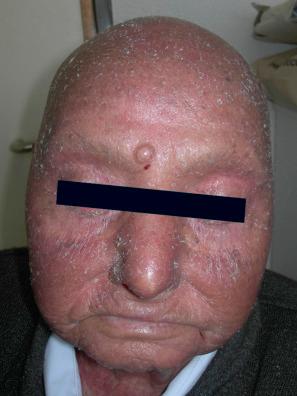
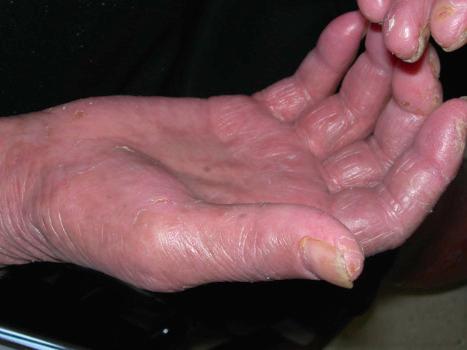
The outcome of the disease is variable but it is often associated with poor prognosis. Median survival figures of 45–48 months are often quoted, and a recent study reported a 5-year survival of 51.4%. Patients with visceral involvement fare particularly badly. Documented important prognostic indicators have included lymph node status, absolute Sézary cell count, fast evolution of the disease, large cell transformation and serum LDH and beta-2-microglobulin levels. The cause of death may be the tumor itself or overwhelming secondary infection. Visceral spread is similar to that of advanced mycosis fungoides.
Erythrodermic cutaneous T-cell lymphoma should be classified as stage 4 disease.
The etiology of Sézary syndrome remains unknown. No consistent viral, environmental, or occupational causative factor or hereditary mutation has been found. Most cases show evidence of chromosomal instability with complex karyotypes and/or large numbers of chromosomal abnormalities. This genetic complexity has been confirmed in more recent genomic analyzes. These studies also demonstrate consistent genomic alterations affecting genes involved in cell cycle and epigenetic regulation as well as the T-cell receptor and JAK/STAT signaling pathways. Genomic differences between Sézary syndrome and mycosis fungoides have also been described, suggesting that these two entities may not be as closely related as previously thought.
The term Sézary cell is synonymous with ‘mycosis cell’, ‘Lutzner cell’, and ‘cerebriform lymphocyte’. On electron microscopy, Sézary cells have characteristic hyperconvoluted (cerebriform) nuclei. They may be classified into three subtypes in peripheral blood smear according to size ( Fig. 29.98 ):
small Sézary cells (Lutzner cells): 8–11 µm,
intermediate-sized Sézary cells: 11–14 µm,
very large Sézary cells: >14 µm.
Very large Sézary cells tend only to be seen in association with lymphoma where they correlate with a worse prognosis, but it is important to remember that circulating Sézary cells of small and intermediate size may be found in a number of benign conditions including contact dermatitis, atopic dermatitis, erythrodermic psoriasis, erythrodermic eczema, actinic reticuloid, and pseudolymphomatous drug reactions. They may even be found in the blood of healthy elderly people.
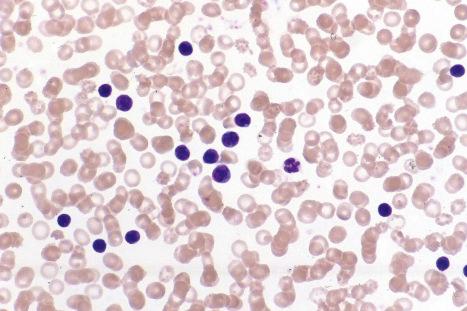
Diagnostic biopsies contain significant numbers of atypical lymphocytes with cerebriform nuclei (Sézary cells), although they are often in the minority. In 20–40% of cases these cells display epidermotropism, and the histologic features are similar to those seen in mycosis fungoides ( Figs 29.99–29.101 ). In the remainder of diagnostic cases, epidermotropism is absent and the lymphoid infiltrate assumes a perivascular or superficial dermal bandlike distribution. Uniform small lymphocytes often predominate, but there are sufficient identifiable small, intermediate, and/or large Sézary cells to permit a diagnosis of Sézary syndrome, given the appropriate clinical setting. In a minority of nonepidermotropic cases, the dermal infiltrate consists entirely of large atypical lymphocytes and the histologic features are those of a large cell lymphoma. In one series, adnexal involvement was frequently seen and included follicular mucinosis in rare cases.
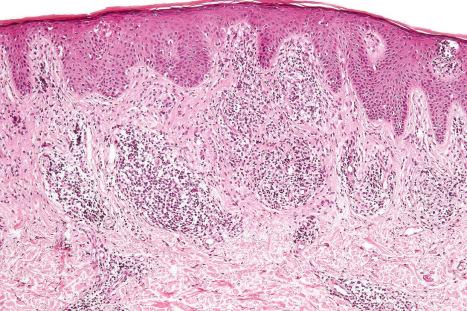
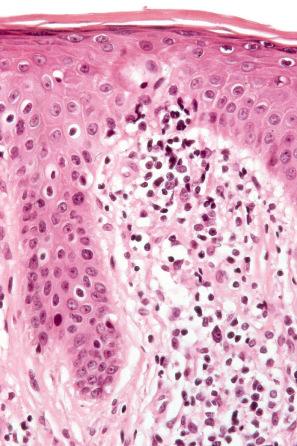
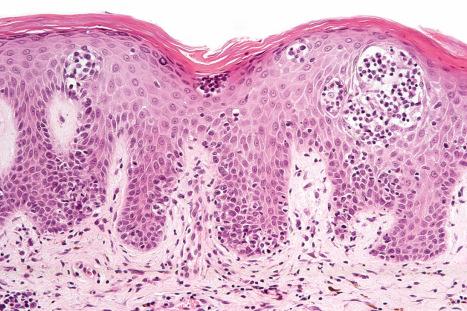
Biopsies of patients with Sézary syndrome are reported to show non-specific and/or nondiagnostic features in around 40% of cases. Earlier studies using less precise diagnostic criteria may have included examples of benign erythroderma, leading to an overestimate in the proportion of such cases. However, a significant proportion of cases lack diagnostic features even in more recent studies in which Sézary syndrome was more stringently defined.
In some studies, >50% of biopsies show features that are not diagnostic of lymphoma. These include cases with a predominantly dermal infiltrate with few, if any, recognizable Sézary cells, as well as cases showing features consistent with chronic dermatitis.
Occasional nondiscriminatory additional features in diagnostic and nondiagnostic biopsies include acanthosis, parakeratosis, spongiosis, basal layer damage, and dermal fibrosis. A mixture of inflammatory cells including histiocytes, eosinophils, neutrophils, and plasma cells is sometimes seen.
The difficulty in arriving at a histologic diagnosis has in part been attributed to a loss of epidermotropism in Sézary cells. It is speculated that this is due to accumulation of Th2-polarized neoplastic lymphocytes in the skin, resulting in reduced production of IFN-γ, leading to decreased production of IFN-γ inducible protein-10 and ICAM-1 by keratinocytes. Topical treatment prior to biopsy and inadequate sampling may also contribute to the frequent lack of diagnostic features. However, even when both these criteria are satisfied, the diagnosis may remain elusive.
Lymph nodes usually show features of dermatopathic lymphadenopathy but may show partial or complete effacement of the architecture by lymphoma. In contrast to mycosis fungoides, large transformed cells are not usually conspicuous.
By immunohistochemistry, Sézary cells are typically CD2+, CD3+, CD4+, CD5+, CD8–, TCRαβ+, CLA+, and CD45RO+ T cells. CD7 is commonly diminished or absent, and CD2, CD3, and CD5 are sometimes lost. CD4–/CD8+ variants have been described, and occasionally a CD4+/CD8+ phenotype is encountered. PD1 is often positive. CD158 can be demonstrated on neoplastic cells if frozen tissue is available.
Monoclonality may be demonstrated in skin biopsies of patients with Sézary syndrome. Such finding is best regarded as significant, particularly when an identical clone is demonstrated in peripheral blood.
Primary cutaneous CD30-positive T-cell lymphoproliferative disorders are collectively the second most common group of cutaneous T-cell lymphomas, accounting for approximately 30% of cases. This category comprises a spectrum of disease with overlapping histologic and immunophenotypic characteristics, and encompasses lymphomatoid papulosis at one end and primary cutaneous anaplastic lymphoma at the other. Clinical appearances and disease course are critical for determining the diagnosis. ‘Borderline’ is the term applied to cases in which the distinction between lymphomatoid papulosis and primary cutaneous anaplastic large cell lymphoma cannot be readily made, usually because of a discrepancy between the clinical and pathological features. Cases of CD30-positive transformed mycosis fungoides are excluded, as are other systemic CD30-positive large T- and B-cell lymphomas involving the skin.
First described in 1968, lymphomatoid papulosis is a chronic, self-healing eruption. It is now classified as an indolent lymphoproliferative disorder in the WHO classification.
Lymphomatoid papulosis occurs more frequently in males (2 : 1). Patients are usually in their fifth decade, although a wide age range, including children, may be affected. The typical presentation is crops of erythematous papules, 0.5–1.0 cm across, which develop over the course of 3–4 weeks, become hemorrhagic and necrotic, and then heal, forming atrophic scars ( Figs 29.102–29.104 ). The clinical features often overlap with those of pityriasis lichenoides acuta. Other lesions may be larger and nodular, and heal with deep varioliform scars. The condition commonly presents on the trunk and limbs, but occasionally other sites are involved. Numbers of lesions are variable, ranging from several to hundreds and take from a few weeks to several months to regress.
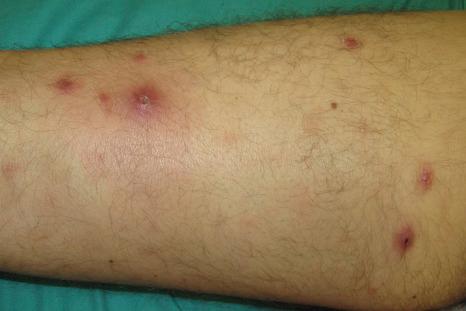
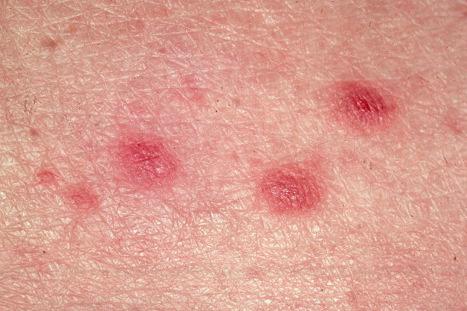
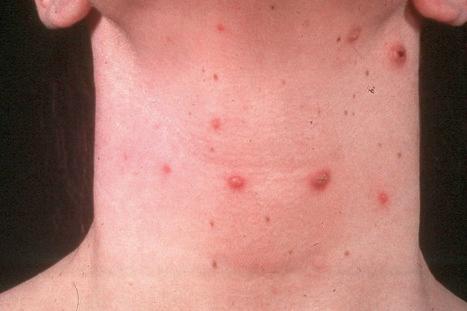
Rare clinical variants have been described. In regional lymphomatoid papulosis, lesions are limited to one body region for years, and seem to be more common in children. Mucosal involvement is exceptional. Oral lesions present as recurring and spontaneously regressing painful ulcers, nodules, or erythematous indurated plaques. Follicular and pustular variants have been described, as has a hydroa vacciniforme (HV)-like presentation in Japan. Pediatric and adolescent disease constitutes 6–10% of cases. The clinical presentation may be alarming, with the rapid development of large ulcerating lesions in addition to the usual papular eruption. However, the disease is otherwise typical.
Lymphomatoid papulosis may run a short self-limiting course, or a more protracted course of 5–10 years or longer. Whatever the scenario, the outcome is generally benign, with treatment only being required when lesions are particularly numerous and/or cosmetically disturbing. However, between 9% and 19% of cases are associated with another lymphoma, such as mycosis fungoides, primary cutaneous anaplastic large cell lymphoma, or HL. The lymphoma may precede, arise concurrently with, or succeed lymphomatoid papulosis. The occurrence of lymphomatoid papulosis lesions restricted to the site of mycosis fungoides lesions has been described as persistent agmination of lymphomatoid papulosis.
The pathogenesis remains undetermined. Most cases appear to represent clonal proliferations of T lymphocytes, more likely a T-regulatory cell subset. Some studies have shown a high rate of apoptosis probably contributing to regression. This may be mediated by death-receptor pathway signaling via cell surface Fas (CD95) signaling and/or due to increased levels of the proapoptotic protein bax. An autocrine or paracrine growth control mechanism has been proposed, mediated by TGF-β secretion and signaling. Mutations of TGF-β signaling receptor genes results in disease progression. More recently, a distinctive subset of lymphomatoid papulosis cases characterized by predominantly localized lesions presenting in elderly patients and associated with chromosomal rearrangements involving 6p25.3 has been described.
In cases of lymphomatoid papulosis associated with another lymphoma, a common clonal identity can often be demonstrated, suggesting a common stem cell giving rise to both. This theory, supported by cytogenetic findings, holds that different tumor cell phenotypes with distinct histopathologies and behaviors arise from accumulated genetic alterations in subclones of a common, occult stem cell.
Patients with lymphomatoid papulosis exhibit a variety of pathologies. An awareness of this spectrum is important as many of the patterns encountered can be mistaken for more aggressive lymphomas. The different types described overlap and may be seen in different biopsies from the same patient. Traditionally, the different patterns of lymphomatoid papulosis have been designated subtypes with a letter of the alphabet appended for identification. This is a rather arbitrary subdivision but is adhered to herein to highlight the range of specific features that may be encountered.
Type A pattern (75–80% of cases) consists of a mixed, wedge-shaped dermal and rarely focally subcutaneous infiltrate containing large anaplastic cells (15–30 µm in diameter) with pleomorphic vesicular nuclei containing prominent nucleoli and abundant cytoplasm ( Figs 29.105–29.109 ). These may be multinucleate and can resemble Reed-Sternberg cells. Mitotic figures are frequent ( Fig. 29.110 ). In established lesions, these cells are scattered or arranged in small clusters, and admixed with neutrophils, eosinophils, plasma cells, lymphocytes, and histiocytes. Epidermotropism of large atypical cells is rare.
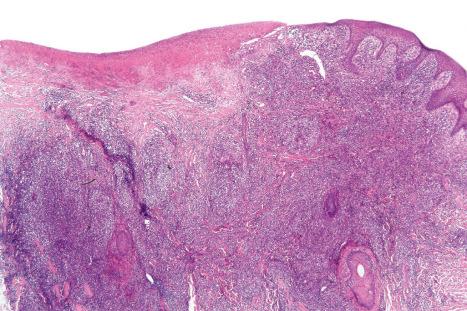
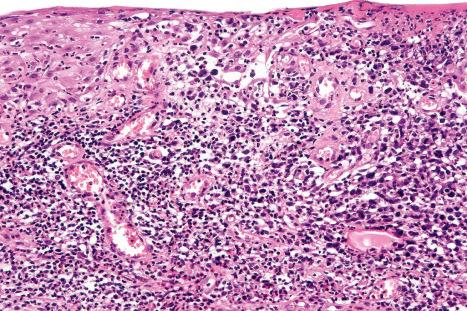
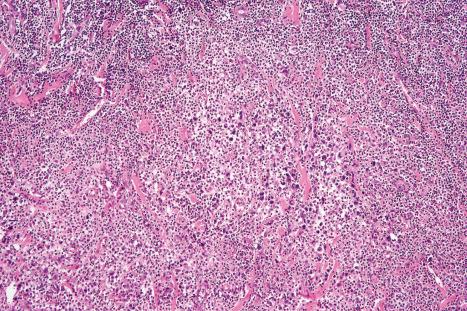
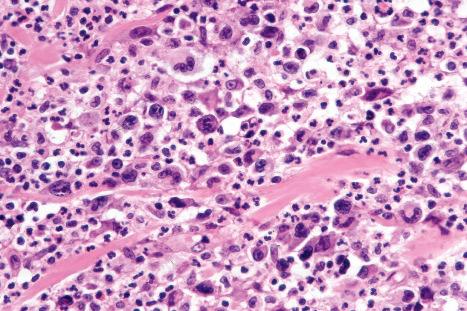
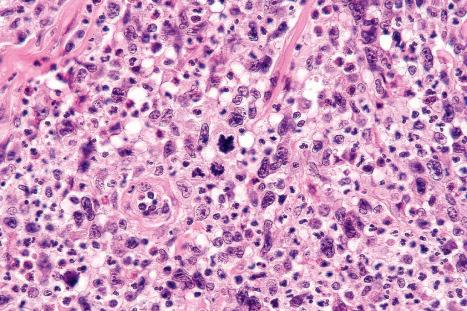
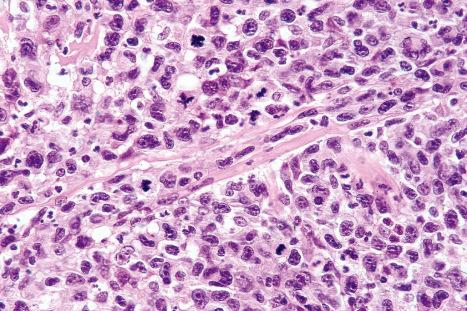
Type B pattern (5–10% of cases) has a preponderance of small to medium-sized lymphocytes with pleomorphic irregular and enlarged nuclei ( Figs 29.111 and 29.112 ). The infiltrate displays a bandlike distribution in the upper dermis. Epidermotropism is prominent, and it simulates plaque stage mycosis fungoides, although Pautrier microabscesses, halos, and basal lymphocytic palisades are usually absent.
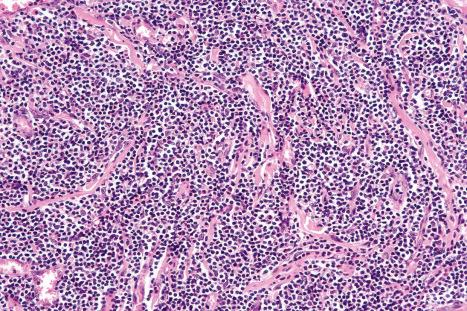
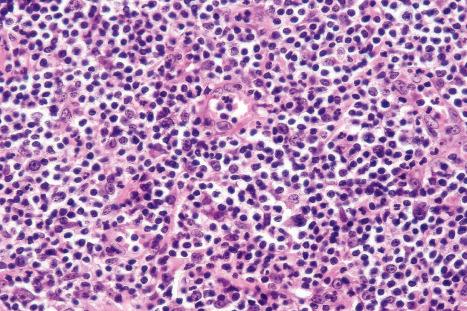
In type C pattern (7–10% of cases), the infiltrate is nodular with large clusters or cohesive sheets of type A cells with relatively few inflammatory cells. The features may be identical to those seen in primary cutaneous anaplastic large cell lymphoma, and the two processes are only distinguished on the basis of clinical features.
Type D lymphomatoid papulosis is associated with prominent epidermal hyperplasia and marked epidermotropism. The intraepidermal lymphocytes are usually larger than those seen in type B lesions and express CD8 rather than CD4. However, large anaplastic cells, as seen in types A and C lymphomatoid papulosis, are usually absent.
So-called type E lymphomatoid papulosis is characterized by an angioinvasive growth pattern with destruction of blood vessel walls. The infiltrating lymphocytes may be small, medium, or large and are admixed with eosinophils and neotrophils. There is often associated necrosis. Clinically, these patients are slightly different from those with classical lymphomatoid papulosis, presenting with relatively few papulonodules that evolve into large flat ulcerations (eschar-like) measuring up to 4 cm in diameter.
A type F lymphomatoid papulosis has also been proposed for cases exhibiting prominent folliculotropism, although this is not an uncommon feature seen in association with other patterns of infiltration. Secondary changes, including follicular mucinosis, hyperplasia of hair follicle epithelium, folliculitis, and granulomatous inflammation, often ensue.
Recently, a specific subtype of lymphomatoid papulosis associated with a specific genetic abnormality has been described in a small number of patients. All have translocations involving the DUSP22-IRF4 locus at 6p25.3. These patients present with one to several eruptive papulonodular lesions limited to a single body area. Biopsy shows a cohesive nodular dermal infiltrate of medium to large blast cells. The overlying epidermis shows extensive colonization by small to medium lymphocytes, often with cerebriform nuclear contours. Pautrier microabscess-like collections may be seen, and the epidermal changes often resemble those seen in pagetoid reticulosis.
It should be noted that not all cases of lymphomatoid papulosis neatly subclassify into the variants described above. In up to 10% of cases, there are overlapping features of two or more subtypes within a single lesion, and lesions displaying different patterns may be present at different sites and/or times within a single patient.
Other features are common to all of the subtypes. Dermal edema and hemorrhage are often conspicuous. Some vessels may show fibrin deposition and occlusion. Reactive epidermal changes are variable, depending on the stage of evolution of the papule. Early lesions show intercellular edema and occasional intraepidermal lymphocytes. Intermediate lesions are characterized by variable necrosis of keratinocytes, intercellular edema, and intraepidermal cells, many of which are atypical. Intraepidermal polymorphs and erythrocytes are commonly found. Late lesions are characterized by extensive epidermal necrosis, ulceration, and the formation of a scaly, parakeratotic crust. Occasionally, there is striking pseudoepitheliomatous hyperplasia such that misdiagnosis as a squamous cell carcinoma or keratoacanthoma may result.
Rare histologic patterns described include a myxoid variant with a sarcoma-like appearance and a syringotropic example.
In all histologic patterns, the atypical lymphoid cells express CLA and are usually CD4+ and CD8–, although occasionally CD4–/CD8+ (type D and type E in particular), CD4–/CD8– and CD4+/CD8+ variants are encountered. Cytotoxic molecules, such as TIA-1, perforin, and granzyme B, are usually identifiable, irrespective of the CD4/CD8 status. There is variable expression of the pan-T-cell antigens, CD2, CD3, CD5, and CD7. The anaplastic cells in the types A and C variants express CD45 and CD30, but not CD15, or p80/ALK1 reactivity with CD25 may also be seen ( Fig. 29.113 ). Although epithelial membrane antigen (EMA) is usually negative, it may be focally positive in some cases. Conversely, in type B lesions, CD30 is often, although not always, negative. Although earlier studies suggested an absence of CD56, more recently expression of this molecule has frequently been seen. In general, tumors of natural killer (NK)/T-cell origin have been generally associated with a very poor prognosis, but this does not appear to be the case in lymphomatoid papulosis. Most cases (75–80%) of lymphomatoid papulosis are also positive for IRF4 (MUM1), but this protein is also expressed in most primary cutaneous anaplastic large cell lymphomas and is not a useful marker for distinguishing between these two ends of a spectrum. Some cases of lymphomatoid papulosis type D express TCR-γ.
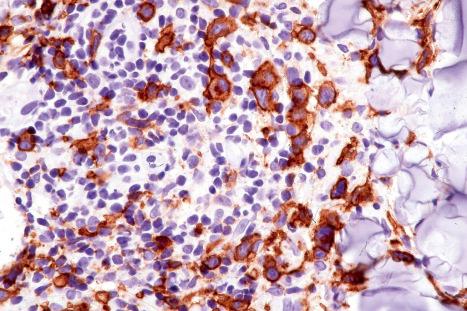
TCR gene rearrangements are detected in approximately 60% of cases.
Expression of CD30 is not a reliable discriminator for differentiating cutaneous CD30+ T-cell lymphoproliferative disorders from reactive inflammatory skin conditions or other types of lymphoma. An increasing number of infectious skin diseases have been shown to contain significant numbers of CD30+ cells and mimic lymphomatoid papulosis. These include cutaneous lesions in various viral infections, including herpes virus, molluscum contagiosum, parapox virus (milker's nodule), EBV, HTLV-1, and HIV. Lesions of scabies, syphilis, and superficial fungal infections may also contain CD30+ cells. Noninfectious cutaneous inflammatory processes, such as pityriais lichenoides et varioliformis acuta, atopic dermatitis, and drug reactions (particularly to anticonvulsants), may also harbor small numbers of CD30+ cells. Cutaneous eruption of lymphocyte recovery may also contain CD30+ cells.
In most of these disorders, the CD30+ cells lack the anaplastic features and are present in fewer numbers than in lymphomatoid papulosis. They also tend to be scattered, rather than in small clusters, but this is not always the case. However, close clinicopathological correlation remains essential.
Type B and type D lymphomatoid papulosis displaying epidermotropism may be impossible to distinguish from other epidermotropic lymphomas such as mycosis fungoides (including pagetoid reticulosis) and primary cutaneous CD8-positive aggressive epidermotropic T-cell lymphoma on the basis of pathological features. In such situations, the diagnosis is dependent on the clinical features.
Primary cutaneous anaplastic large cell lymphoma is a tumor composed of at least 75% of CD30-positive T cells. These latter may display anaplastic, pleomorphic, or immunoblastic morphology. The outcome is similar irrespective of histologic subtype. The prognosis is excellent, particularly when compared to other CD30-positive large cell lymphomas involving the skin. The latter include transformed mycosis fungoides, as well as nodal/systemic ALK-positive and ALK-negative anaplastic large cell lymphoma with cutaneous dissemination. Primary cutaneous CD30-negative large cell lymphomas are also excluded from this category because of their much more aggressive behavior and poorer prognosis.
Primary cutaneous anaplastic large cell lymphoma occurs mainly in the seventh decade. Although a wide age range may be affected, childhood cases are rare and, unlike systemic anaplastic large cell lymphoma, there is no bimodal age distribution. There is male predilection. Most cases (approximately 80%) present with a solitary erythematous or violaceous, often ulcerated nodule or group of nodules/papules restricted to a single region ( Figs 29.114 and 29.115 ). The extremities are particularly involved. Multifocal disease, defined as two or more lesions at multiple anatomic sites, is seen in around 20% of cases ( Fig. 29.116 ).
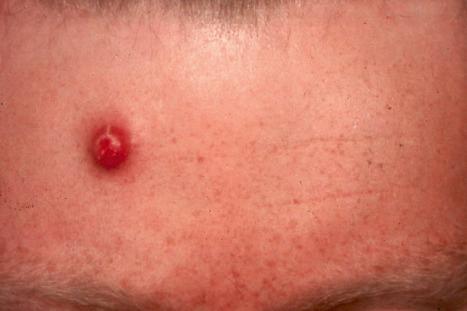
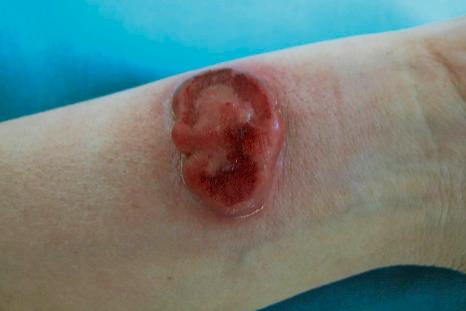
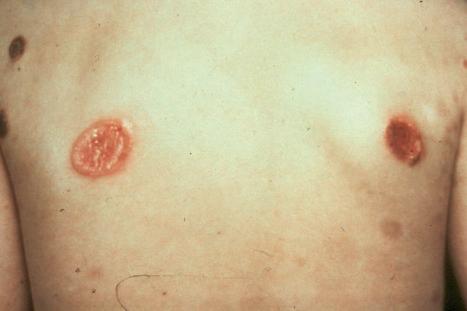
Clinical behavior varies: 42% of lesions are associated with partial or complete regression; such variants were described as ‘regressing atypical histiocytosis’ in the older literature. A further 42% are associated with one or more recurrences, but only 10–20% are associated with extracutaneous (generally nodal) spread. There does not, however, appear to be any significant difference in behavior between those that are confined to the skin and those that spread to one draining lymph node region. The 5- and 10-year disease-related survival ranges from 91% to 96% for patients with primary disease (depending on whether or not there is concomitant lymph node involvement) compared with 24% for patients with secondary cutaneous involvement by nodal CD30-positive large T-cell lymphoma. Risk factors for tumor progression are unknown.
Primary cutaneous anaplastic large cell lymphoma is a neoplasm of activated skin-homing T lymphocytes which appear to show a Th2-type bias of cytokine production. They have clonally rearranged T-cell receptor genes but are deficient in T-cell receptor and T-cell receptor associated proximal signaling molecules.
The pathogenesis is unknown. Consistent cytogenetic abnormalities have been identified and a variety of oncogenes implicated, including JUNB, but specific mechanisms of tumor development have yet to be elucidated. As with lymphomatoid papulosis, it is possible that expression of the proapoptotic protein bax and/or death-receptor (CD95) signaling may contribute to the spontaneous regression of some cases and the generally favorable outcome.
Primary cutaneous anaplastic large cell lymphomas typically lack the t(2;5)(p23;q35) and resulting overexpression of the NPM-ALK fusion protein normally associated with this translocation. Nevertheless, rare cases of ALK protein and ALK gene translocation positive lymphomas presenting primarily in the skin have recently been described and appear to be associated with a similarly favorable prognosis. In addition, cases of primary cutaneous anaplastic large cell lymphoma displaying cytoplasmic ALK expression but lacking evidence of an underlying genetic abnormality are noted. Thus, even if bona fide cases of ALK-positive primary cutaneous anaplastic large cell lymphoma do exist, they are currently best excluded from this category until there is sufficient information to better understand their biology and predict their behavior ( Fig. 29.117 ). A further finding is the presence of translocations involving the DUSP22/IRF4 locus at 6p25.3 that have been documented in around 20% of cases, although this is not specific for primary cutaneous anaplastic large cell lymphoma, also being found in a similar percentage of systemic ALK-negative anaplastic large cell lymphomas and a small subset of lymphomatoid papulosis cases.
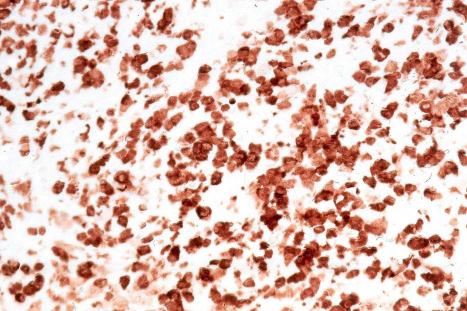
In contrast to lymphomatoid papulosis where the infiltrate is largely restricted to the dermis, in primary cutaneous large cell lymphoma, the tumor (which is often ulcerated) commonly extends into the subcutaneous fat or deeper tissues. Rare cases confined to the subcutis have also been reported and occasionally an angiodestructive growth pattern is evident.
A number of histologic variants are recognized, with a similar spectrum of appearances to that seen in systemic ALK-positive anaplastic large cell lymphoma. Most commonly, the tumor cells display an anaplastic morphology with abundant cytoplasm and pleomorphic vesicular nuclei with clumped heterochromatin and prominent nucleoli ( Figs 29.118–29.121 ). Some cells may show cytoplasmic vacuolation and even assume a signet ring appearance. Bizarre forms are common and include multinucleated giant cells resembling Reed-Sternberg cells, as well as cells with nuclei arranged in wreath configurations ( Fig. 29.122 ). Lymphophagocytosis may be seen ( Fig. 29.123 ). Mitoses including atypical forms are common ( Fig. 29.124 ). Less often, tumor cells have a pleomorphic or immunoblastic appearance. Small cell (pleomorphic) variants may resemble tumor stage mycosis fungoides and are rare ( Figs 29.125 and 29.126 ). They are characterized by an infiltrate of atypical hyperchromatic and only weakly CD30+ cerebriform T lymphocytes with much smaller numbers of anaplastic large cells and inflammatory cells. Rarely, the tumor cells may have a pleomorphic spindle cell morphology, myxoid stroma, or a storiform growth pattern, mimicking a sarcoma.
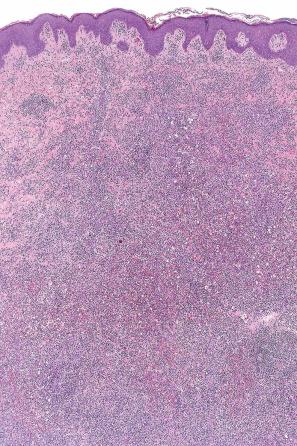
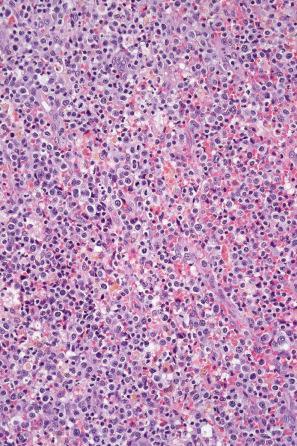
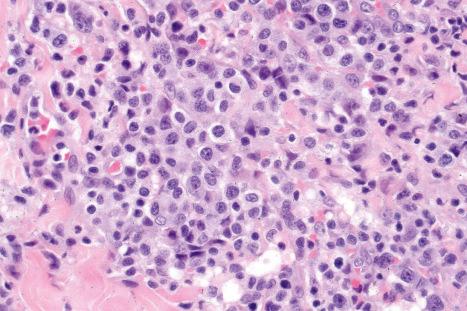
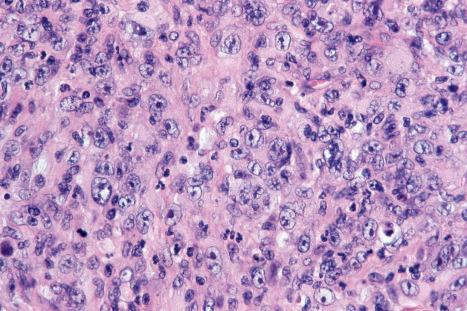
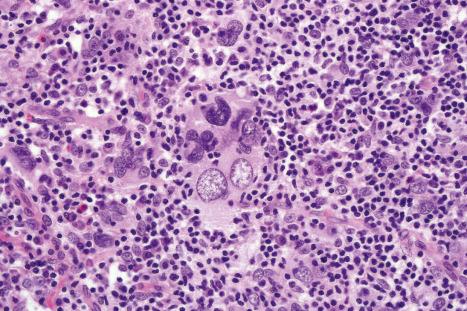
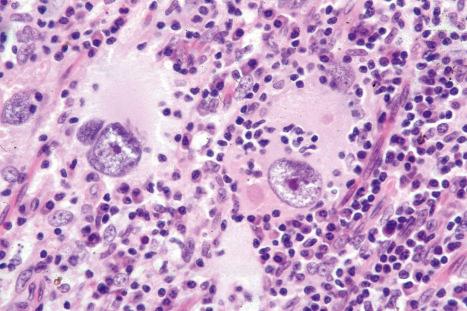
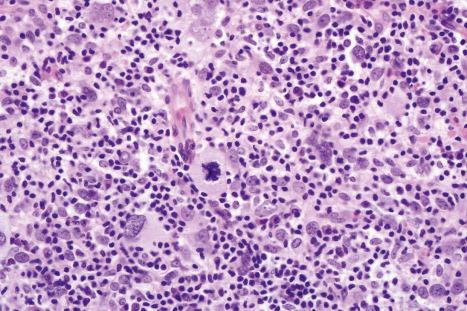
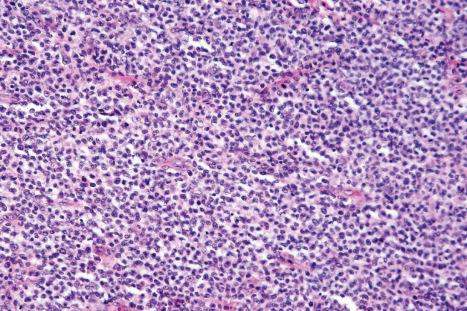
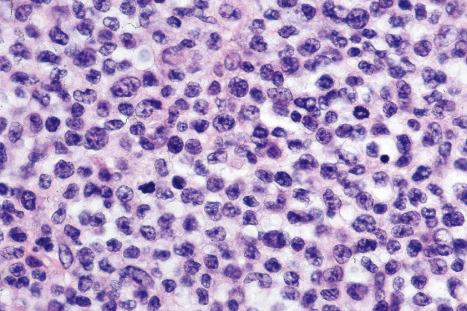
The tumor cells grow in large nests or diffuse sheets (occasionally leading to a mistaken diagnosis of metastatic carcinoma or melanoma) commonly showing areas of necrosis ( Figs 29.127 and 29.128 ). Intralymphatic permeation is relatively common. Epidermotropism may be seen in up to 40% of cases. Pseudoepitheliomatous hyperplasia may be marked, closely mimicking malignancy, especially in small biopsies.
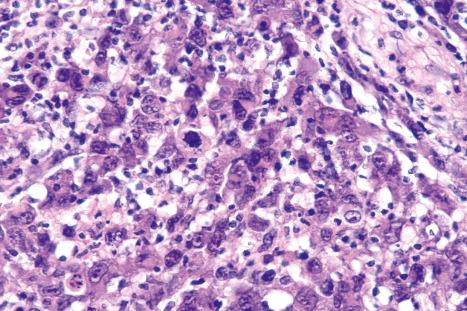
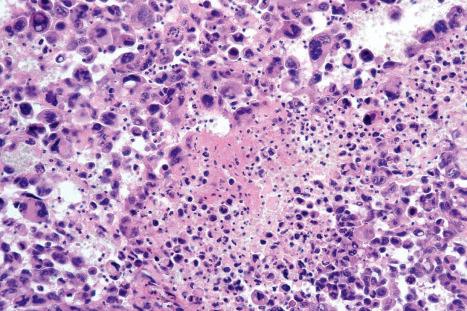
Inflammatory cells including neutrophils, eosinophils, histiocytes, lymphocytes, and plasma cells are frequent ( Figs 29.129 and 29.130 ). Rarely, neutrophils are so conspicuous that an inflammatory process such as a pustular/infective dermatosis may initially be suspected (neutrophil-rich variant, pyogenic lymphoma). It has been suggested that the intense neutrophil infiltrates result from IL-8 production by the tumor cells. In other cases, large numbers of eosinophils are present and may represent the disease described as eosinophilic histiocytosis. A lymphohistiocytic variant characterized by the presence of numerous histiocytes, which may display hemophagocytosis, has also been described. Some cases harboring translocations of the IRF4-DUSP22 locus may show distinctive features, similar to those seen in lymphomatoid papulosis associated with the same genetic abnormality. These cases exhibit a biphasic pattern characterized by nodular and diffuse dermal infiltrates of large cells with overlying pagetoid reticulosis-like changes, the intraepidermal lymphocytes generally being of small size.
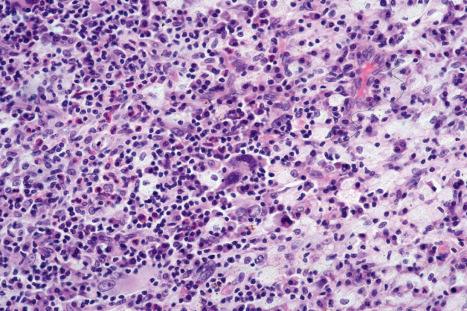
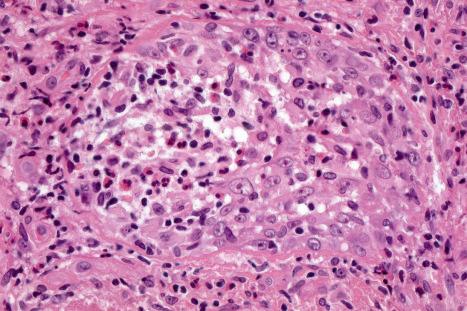
By definition, 75% or more of the tumor cells express membranous and Golgi CD30 (Ber-H2/Ki-1) ( Fig. 29.131 ). Most cases display an activated CD4+ T-cell phenotype, although occasionally CD8+ or null cell variants are encountered ( Fig. 29.132 ). There is variable loss of various pan-T-cell antigens. The majority of cells express cytotoxic molecules TIA-1, perforin, or granzyme B. CD25, CD71, and HLA-DR are also usually present. CD15 is typically absent. In contrast to primary nodal variants, EMA is almost invariably absent in primary cutaneous lesions although it may sometimes be evident in children ( Fig. 29.133 ). Staining for ALK1 is also usually negative (see above). Spindle cell variants may express smooth muscle actin. Fascin is expressed in up to 64% of cases of CD30-positive anaplastic large cell lymphoma, compared with only 24% of cases of lymphomatoid papulosis. Occasional CD56+ tumors have been documented, but this does not appear to be associated with prognosis. IRF4 (MUM1) may also be expressed but has limited utility in distinguishing primary cutaneous anaplastic large cell lymphoma from lymphomatoid papulosis, transformed mycosis fungoides, and systemic T-cell lymphoma secondarily involving the skin.
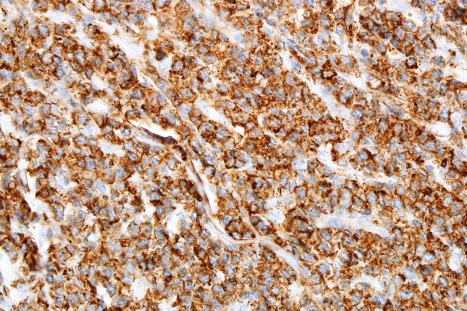
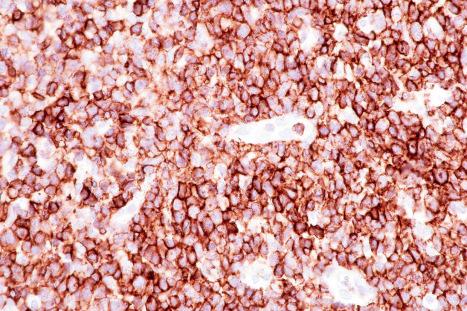
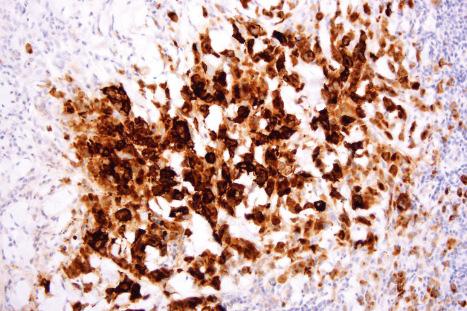
Clinical correlation is essential in differentiating primary cutaneous anaplastic large cell lymphoma from other CD30+ large cell lymphomas that may arise in, or disseminate to, the skin. The clinical appearance of lesions and course of disease are the only reliable discriminants of primary cutaneous anaplastic large cell lymphoma and lymphomatoid papulosis types A and C. Primary cutaneous anaplastic large cell lymphoma may also be indistinguishable from transformed CD30+ mycosis fungoides, and this possibility should always be excluded by careful clinicopathologic correlation. Staging, including CT of chest and abdomen and bone examination, is essential in excluding dissemination of nodal CD30+ large T-cell lymphomas, such as ALK+ and ALK– anaplastic large cell lymphoma and some examples of peripheral T-cell lymphoma, unspecified.
Immunohistochemistry and genetic analysis may facilitate distinction from nodal ALK+ anaplastic large cell lymphoma, with the above caveats. Immunohistochemistry will also permit distinction from rare cases of CD30+ large B-cell lymphoma involving the skin, and will facilitate distinction of spindle cell variants from spindle cell carcinoma, spindle cell melanoma, dermal sarcomas, inflammatory pseudotumor (IPT), follicular dendritic cell (FDC) sarcoma, dendritic reticulum cell sarcoma, and spindle cell leukemic infiltrates.
Inflammatory conditions containing CD30+ cells are more likely to be mistaken for lymphomatoid papulosis than cutaneous anaplastic large cell lymphoma.
Primary cutaneous CD4-positive small/medium T-cell lymphoma was included as a provisional entity in the 2008 WHO classification. It remains a provisional entity in the 2016 update although the nomenclature has been altered to primary cutaneous CD4-positive small/medium T-cell lymphoproliferative disorder to reflect the uncertain malignant potential associated with such lesions. It has been suggested to represent a limited clonal response to an unknown stimulus, lacking sufficient criteria to designate a malignancy. It is defined as a proliferation of small to medium-sized CD4-positive pleomorphic T cells in patients lacking patches or plaques typical for mycosis fungoides. It is rare, accounting for approximately 2–3% of all primary cutaneous T-cell lymphomas.
Females and males appear to be equally affected. The age range is wide, and most patients are adults, with a median age at presentation in the sixth decade; pediatric cases may be encountered. The majority of patients present with solitary or localized asymptomatic, erythematous to purple papulonodules or plaques, particularly on the head and neck and upper trunk. A minority of patients present with large tumors or multiple lesions. The prognosis is good. Early series quoted 5-year survivals of around 80%. However, more recent reports in which the majority of patients presented with solitary or localized lesions, have a much more favorable outcome with survival approaching 100%. Those with multiple lesions/large tumors run a more aggressive clinical course.
Histologically, the tumor is composed of a fairly uniform population of small to medium-sized lymphocytes with pale scanty cytoplasm and hyperchromatic irregular noncerebriform nuclei in a perivascular, bandlike, nodular, or diffuse fashion, often involving the entire dermis and sometimes extending into the subcutis ( Figs 29.134 and 29.135 ). By definition, large cells make up less than 30% of the population. Mitotic figures are rare and epidermotropism is absent, or focal ( Fig. 29.136 ). Lymphocytes, neutrophils, eosinophils, and plasma cells may sometimes be present, and rarely there is a granulomatous component. Formation of germinal centers is not usually seen.
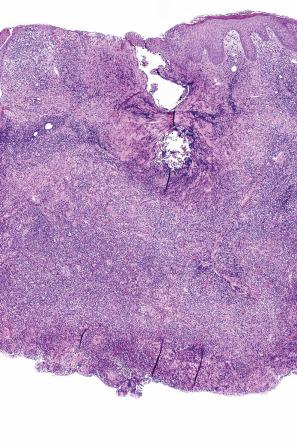
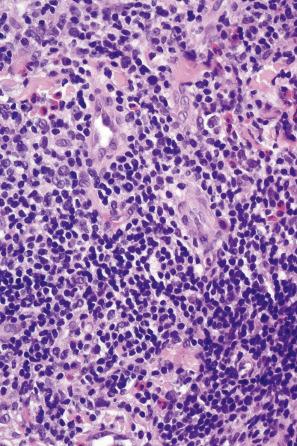
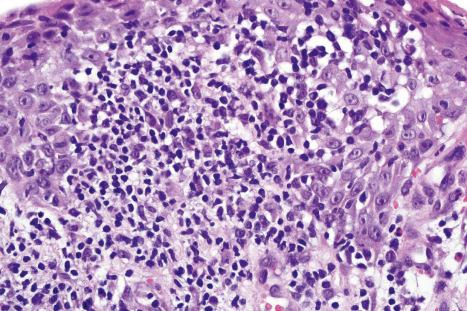
Tumor cells have a T-helper phenotype, and there may be loss of CD7 and rarely CD2 and/or CD5 ( Fig. 29.137 ). CD30, cytotoxic molecules, and EBV are negative. The neoplastic lymphocytes also show reactivity with antibodies to PD1 and BCL6, with lesser numbers also usually expressing CXCL13 and ICOS, but they are usually CD10 negative. PD1-positive cells are often seen in clusters, but this is not specific. Based on the immunoprofile, it has been suggested that primary cutaneous CD4-positive small/medium T-cell lymphoproliferative disorder is a lesion of T-follicular helper cells, although the absence of CXCR5 in the clonal lymphocytes casts some doubt on this hypothesis. Antibodies to CD20 highlight B lymphocytes. These are often numerous and include blast cells that may coexpress CD30, and are often surrounded by the PD1-positive lymphocytes.
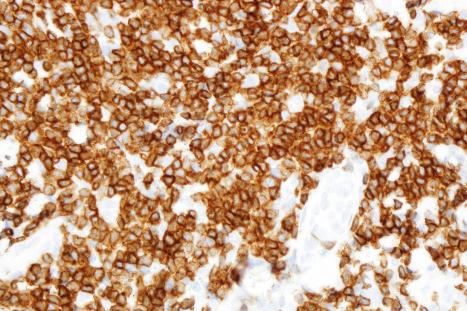
Clonal rearrangements of the T-cell receptor genes are found in the majority of cases.
Primary cutaneous small/medium-sized T-cell lymphoma should be distinguished from tumor stage mycosis fungoides, lymphomatoid papulosis, subcutaneous panniculitis-like T-cell lymphoma, and T-cell pseudolymphoma. The distinction depends as much on clinical information as on histologic and immunophenotypic investigations. The distinction with T-cell pseudolymphoma is not clear-cut. T-cell pseudolymphomas often presents with a solitary plaque or nodule, and recent studies have shown considerable pathological overlap, including clonality and expression of T-follicular helper cell markers. This has led some to propose that most cases previously called T-cell pseudolymphoma would now be classified as primary cutaneous CD4-positive small/medium T-cell lymphoproliferative disorder.
Primary cutaneous acral CD8+ T-cell lymphoma appears for the first time as a provisional entity in the 2016 update of the WHO classification. It is the name now proposed for a variant of cutaneous T-cell lymphoma first described as ‘indolent CD8-positive lymphoid proliferation of the ear’ in a very small series of cases in 2007. Since this original publication, additional cases have been reported, all with similar pathological and clinical features, but with a broader distribution of lesions, including elsewhere on the face, particularly the nose, and other acral sites. Presentation is with asymptomatic, slow-growing, often solitary papules, nodules, or plaques on the ear (helix or earlobe), elsewhere on the face, particularly the nose, or the hands and feet. The behavior seems to be indolent with no dissemination.
The pathogenesis is unknown. Histologically, the epidermis appears unremarkable, and it is separated from a diffuse prominent dermal, and focally subcutaneous infiltrate by a grenz zone ( Fig. 29.138 ). Tumor cells are medium-sized and fairly monotonous with a blast-like appearance, irregular nuclei, and a small nucleolus ( Fig. 29.139 ). The proliferative activity is low. By immunohistochemistry, tumor cells stain for CD3, CD8, CD45RA, and cytotoxic granules including granzyme B ( Fig. 29.140 ). CD4 and CD30 are negative, and there may be loss of other T-cell markers including CD2 and CD5. A few reactive B cells are present in the background. A T-cell clone is usually demonstrated.
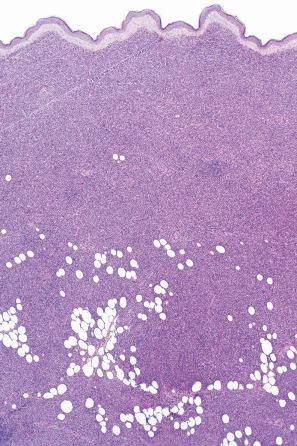
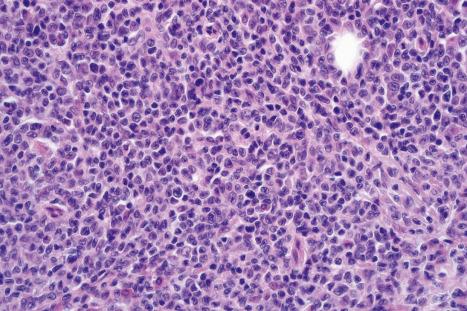
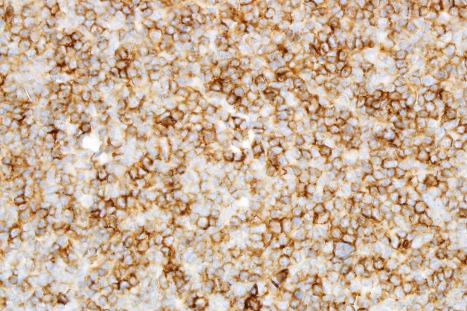
Despite these features of malignancy, and irrespective of the blast cell morphology and cytotoxic T-cell phenotype, this is an indolent process. Cases treated with only locally directed therapy, including biopsy or excision alone, almost invariably go into complete remission and, although relapses may occur, no disease related deaths have yet been reported.
The main challenge is therefore to differentiate these lesions from the other lymphomas with a cytotoxic phenotype that often exhibit a more aggressive behavior. Clinicopathological correlation should help discriminate from other specific cutaneous lymphomas that occasionally express CD8 rather than CD4 such as mycosis fungoides, pagetoid reticulosis, primary cutaneous anaplastic large cell lymphoma, lymphomatoid papulosis, or others which are also characterized by a cytotoxic phenotype, including CD8 expression in some or all cases. The latter include subcutaneous panniculitis-like T-cell lymphoma, primary cutaneous CD8-positive aggressive epidermotropic cytotoxic T-cell lymphoma, primary cutaneous γ/δ T-cell lymphoma, and extranodal NK/T-cell lymphoma of nasal type. However, the distinction may not always be clear-cut, and localized nonepidermotropic cutaneous CD8-positive lymphoproliferations with a poor outcome have previously been described. Expression of CD68 by the neoplastic lymphocytes may help as it has recently been reported to be specific for primary cutaneous acral CD8+ T-cell lymphoma, although the utility of this marker has yet to be tested in large series of cases.
Angioimmunoblastic T-cell lymphoma (AITL) is a peripheral T-cell lymphoma characterized by systemic disease including generalized lymphadenopathy, hepatosplenomegaly, anemia, and hypergammaglobulinemia. The reported male/female ratio is variable, but age of presentation is in the sixth or seventh decades. The disease is usually in an advanced stage at presentation with generalized lymphadenopathy and frequent hepatosplenomegaly, bone marrow and skin involvement, and systemic symptoms. Pleural effusions, ascites, arthritis and/or arthralgia, ear, nose, and throat involvement, and neurological manifestations may also be present. Often, patients have hemolytic (Coombs positive) anemia, polyclonal hypergammaglobulinemia, raised LDH, leukocytosis, including eosinophilia, or lymphopenia and thrombocytopenia. Additional autoimmune phenomena may be encountered including cold agglutinins, cryoglobulins, circulating immune complexes, smooth muscle antibody, rheumatoid factor, and antinuclear antibodies.
Cutaneous lesions occur in up to 50% of patients at presentation and/or relapse. Skin involvement manifests as a pruritic maculopapular eruption on the trunk and extremities; this may mimic a viral exanthem or drug hypersensitivity reaction, and in some cases skin lesions may follow drug administration ( Figs 29.141 and 29.142 ). Other reported manifestations include urticaria, erythroderma, erosions, petechiae, purpura, papulovesicular prurigo-like lesions, plaques, and tumor nodules.
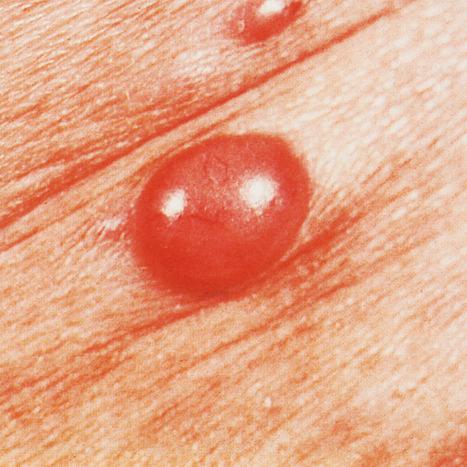
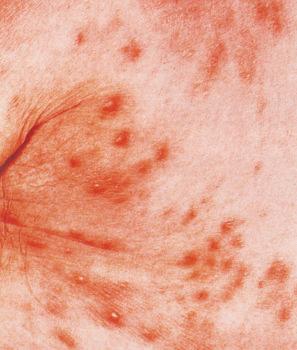
The outlook for patients with AITL is poor, and while the initial response to treatment is good, it tends to be short-lived. The median survival is <36 months, and 5-year overall survival is between 30% and 35%. Death is often due to infectious complications.
AITL is a malignancy of follicular helper T cells, as evidenced by the immunophenotype and gene expression profile. Chromosomal abnormalities have been detected in AITL, the most common being trisomies of chromosomes 3, 5, 18, and 19, gain of chromosome X, and deletion of chromosome 7. Comparative genomic hybridization (CGH) has also documented gains of 11q13, 19, and 22p, and losses of 13q in a subset of cases. More recent studies have shown that mutations of epigenetic regulators, such as RHOA, TET2, DNMT3, and IDH2, are common in AITL, although only IDH2 mutations appear to be relatively specific for this subtype of T-cell lymphoma.
Lymph nodes involved by AITL typically show partial effacement of their architecture by a polymorphic infiltrate, mainly in paracortical areas. The sinuses are usually preserved, but perinodal connective tissues are often involved. In the early stages of the disease, there may be hyperplastic B-cell follicles, but frequently follicles are regressed or absent. Paracortical areas show marked proliferation of high endothelial venules and a mixed population of lymphocytes, plasma cells, eosinophils, and histiocytes. The neoplastic lymphocytes are usually of intermediate size with abundant clear or pale cytoplasm. They are typically found in small clusters around follicles and high endothelial venules. Small reactive lymphocytes are also present, as are scattered large B immunoblasts, some resembling Reed-Sternberg cells.
Biopsies of cutaneous lesions most often show superficial or superficial and deep perivascular or rarely periadnexal lymphocytic infiltrates that are suspicious or diagnostic of lymphoma. The infiltrates range from sparse to dense, contain pleomorphic atypical lymphocytes, and are associated with vascular hyperplasia with prominence of endothelial cells. Less commonly, the changes are non-specific, comprising superficial perivascular infiltrates of small lymphocytes showing no atypia, eosinophils, and sometimes plasma cells. Mild interface changes have been described in a number of cases in one series. Biopsies showing leukocytoclastic vasculitis and granulomatous inflammation are seen in some cases ( Figs 29.143 and 29.144 ). Rarely, the associated and sometimes neoplastic B-cell expansion may dominate the histologic picture, masking the underlying T-cell lymphoma. Most often, the B-cell proliferation resembles diffuse large B-cell lymphoma (DLBCL), but in others it may mimic lymphoplasmacytic or marginal zone lymphoma, or a plasma cell neoplasm.
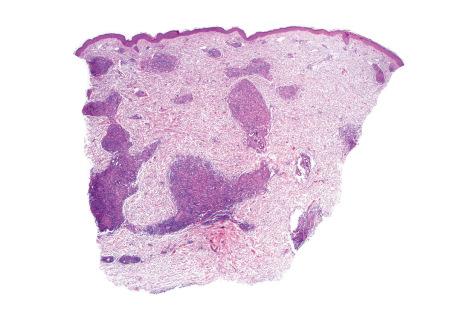
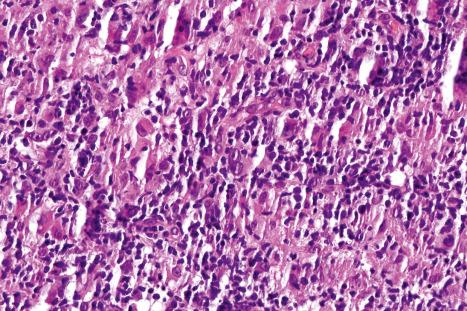
Tumor cells often best highlighted in lymph nodes are CD4 positive, and usually express CD2, CD3, and CD5, although significant numbers of reactive CD8-positive T cells may also be present. In common with follicular T-helper cells, at least a proportion express CD10, CXCL13, PD1, and sometimes bcl6. CD20 highlights the B immunoblasts, and these are often positive for EBV by in situ hybridization. Irregular, expanded FDC meshworks, often in the vicinity of high endothelial venules, are highlighted by CD21, CD23, CD35, and/or CNA42. In the skin, it is often harder to identify the neoplastic lymphocytes, but immunohistochemistry with antibodies to CXCL13 seems to be sensitive and specific.
Clonal rearrangements of the TCR gene are identifiable in lymph nodes in most cases, and correlate well with the presence of CXCL13-positive tumor cells in the skin. Clonal immunoglobulin gene rearrangements are seen in 20–30% of cases and correspond to expanded populations of EBV-positive B cells.
Differentiating cutaneous involvement by AITL from reactive cutaneous infiltrates is best achieved by correlation with the lymph node pathology and clinical features. In certain situations, staining for CXCL13 and gene rearrangement studies may prove useful.
Adult T-cell leukemia/lymphoma (ATLL) is a systemic disease induced by human T-cell leukemia virus type 1 (HTLV-1) with variable clinical manifestations, and frequent skin involvement. It was first described on the island of Kyushu in southwestern Japan. It also occurs in the Caribbean, northeastern South America, southeastern United States, Central Africa, and the Pacific basin. Cases are occasionally diagnosed in the rest of the United States and Europe as a consequence of immigration. The disease predominantly affects adults, pediatric cases being rare.
There may be a prodromal phase, but once established, four variants are recognized: acute, chronic, smoldering. and lymphomatous:
Acute ATLL (55%): This is the most common subtype, usually presenting with an abrupt onset, and is characterized by a leukemic phase. Hypercalcemia, with or without lytic bone lesions, constitutional symptoms, and raised LDH are typical. A very high white cell count, numerous circulating neoplastic lymphocytes, neutrophilia, and eosinophilia are common. Skin lesions are present in about 50% of cases, and there may be lymphadenopathy and hepatosplenomegaly.
Chronic ATLL (20%): A lymphocytosis may be present with few circulating atypical lymphoid cells. Hypercalcemia is absent and serum LDH is normal or only slightly raised (less than or equal to twice the upper limit of normal). Skin lesions, including an exfoliative rash, may occur and there may be mild lymphadenopathy and/or splenomegaly.
Smoldering ATLL (5%): The lymphocyte count is normal but >5% of circulating lymphocytes are abnormal T cells. Hypercalcemia is absent. Skin and pulmonary involvement are frequent. Lymphadenopathy or hepatosplenomegaly are absent. Serum LDH is normal or only slightly raised (less than or equal to 1.5 times the upper limit of normal).
Lymphomatous ATLL (20%): Peripheral blood involvement is seen in this variant, the disease being characterized by prominent lymphadenopathy, usually of advanced stage. Hypercalcemia is less frequent than in the acute form of the disease, but skin lesions are common.
Cutaneous lesions are reported in 43–72% of cases and may be seen in all forms of the disease, but are less common in the lymphomatous subtype ( Figs 29.145 and 29.146 ). Skin lesions are somewhat heterogeneous, presenting as papules, nodules, tumors, plaques, or erythema/erythroderma. Rarely, pompholyx-, keloid-, and granuloma-like lesions and hyperpigmented, purpuric, vesicular, and bullous lesions are seen. A cutaneous variant, in which monoclonal lymphocytes proliferate in skin only, has been proposed. This is because such cases are associated with a poorer prognosis than smoldering ATLL (the category in which most would currently be grouped), but a much better outcome than the other variants.
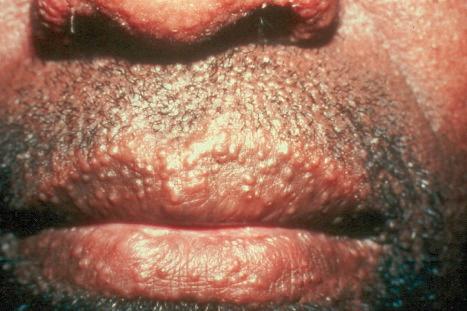
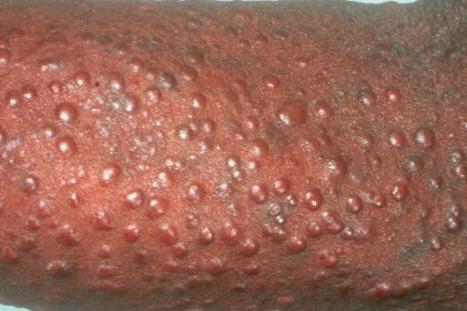
Many patients have a T-cell-associated immunodeficiency and are immunocompromised. Opportunistic infections, including Pneumocystis jiroveci pneumonia, candidiasis, cryptococcosis, CMV, and strongyloidiasis, are common. Prognosis is related to the clinical subtype, age, serum calcium, and LDH levels and, for cases with cutaneous involvement, the type of skin lesion, those with patches and plaques doing relatively well, whilst those with eryhtroderma have a particularly poor outcome. The median survival for acute and lymphomatous variants ranges from around 2 weeks to 1 year while patients with chronic and smoldering forms can survive for up to 2 years or longer. Death is usually due to infection, hypercalcemia, or tumor burden.
ATLL develops only in HTLV-1 infection and the malignant cells contain integrated HTLV-1 provirus, providing strong support for a causative role. HTLV-1 is transmitted via peripheral blood (intravenous drug abuse, sexual intercourse), blood products, or from mother to child transplacentally or via breast milk. However, a relatively low proportion of infected individuals go on to develop ATLL, the cumulative risk for males being 6.6% and for females 2.1%. There is also a long latent period, most cases seeming to follow transmission by breastfeeding, with the average age of a Japanese patient being 60 years. This implies that an as-yet unidentified cofactor is necessary for transformation.
HTLV-1 proviral DNA is randomly integrated into host cell DNA with transcription of viral genes. Expression of the transcriptional transactivator protein, Tax, and/or the HTLV-1 basic leucine zipper factor seems to be important for transformation. These may act via downstream effects on cell cycle progression and/or apoptosis following activation of the NF-κB pathway.
Complex karyotypes are seen in ATLL together with a variety of clonal chromosomal abnormalities. Mutations or loss of function of a number of tumor suppressor genes, including cyclin-dependent kinase inhibitors (p15, p16), p53, and Rb have also been identified, particularly in the lymphomatous and acute variants. Overexpression of p21 may also occur. Recurrent mutations involving the RHOA, TET2, and CCR4 genes have also been demonstrated in a significant percentage of cases.
Circulating leukemic cells have characteristic morphology with hyperlobated pleomorphic nuclei that sometimes resemble a clover leaf, with condensed chromatin and inconspicuous nucleoli. They contain acid phosphatase, β-glucuronidase, and acid-naphthyl acetate esterase. Immunophenotypically, they are helper/inducer T lymphocytes.
In tissues, a broad spectrum of cytological appearances may be seen including pleomorphic small, medium, and large cell, anaplastic large cell, Hodgkin-like and AITL-like ( Figs 29.147 and 29.148 ). Cutaneous lesions may show perivascular, nodular, or diffuse patterns of infiltration. In erythematous lesions, tumor cells are located in the upper dermis and are small to medium-sized lymphocytes with mild nuclear irregularity and few mitotic figures. In papules and nodules, a pan-dermal and sometimes subcutaneous nodular or diffuse infiltrate is seen. The lymphocytes are usually of medium to large size with highly irregular nuclear outlines, coarsely clumped chromatin, and sometimes prominent nucleoli. Blast-like cells, cerebriform giant cells, and Reed-Sternberg-like cells are present in some cases, and mitotic figures are frequent. Epidermotropism, with Pautrier microabscesses, may be seen, most frequently in association with perivascular infiltrates and lesions resemble mycosis fungoides or Sézary syndrome. Histiocytes, plasma cells, and sometimes eosinophils are often evident. Rare cases are associated with follicular mucinosis and granulomas are exceptional.
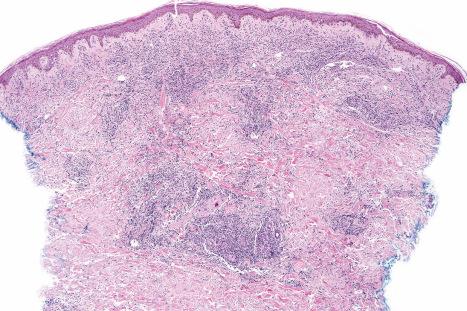
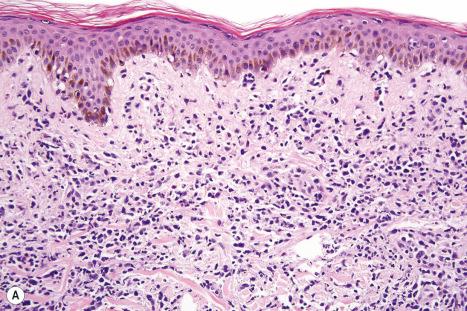
In addition to bone marrow, skin, and lymph node involvement, widespread tumor infiltration is commonly present in the lung, liver, kidney, gastrointestinal tract, and central nervous system (CNS), in decreasing order of frequency.
The cells are usually CD2+, CD3+, CD4+, CD5+, CD25+, and CD7– ( Figs 29.149 and 29.150 ). CD8+ variants have occasionally been documented, and rarely the tumor cells express both CD4 and CD8. The large transformed cells may express CD30 but are negative for ALK1 and cytotoxic molecules. The tumor cells also frequently express the chemokine receptor CCR4 and FoxP3, suggesting a relationship to T-regulatory cells.
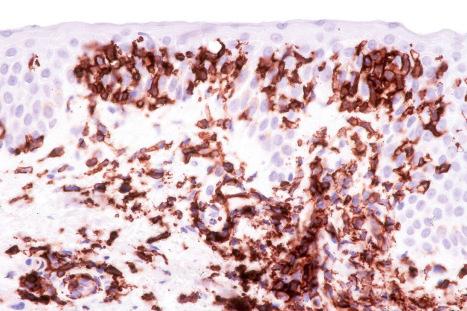
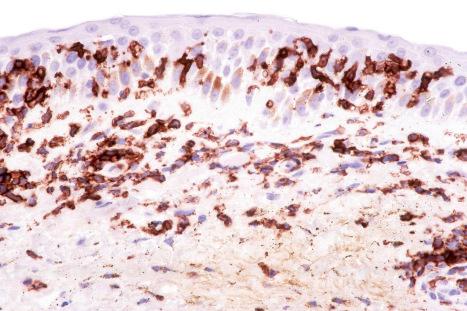
ATLL may show considerable overlap with mycosis fungoides and Sézary syndrome. The acute onset and typical lack of a patch stage are useful discriminants. In cases of doubt, the diagnosis of ATLL may be firmly established serologically or by the identification of HTLV-I sequences in tumor DNA.
Subcutaneous panniculitis-like T-cell lymphoma (SPTCL), first described in 1991, is a rare tumor that may be associated with hemophagocytic syndrome. Previously, many cases may have been variously reported as cytophagic histiocytic panniculitis, Weber-Christian disease, histiocytic lymphoma, malignant histiocytosis, or histiocytic medullary reticulosis. SPTCL became recognized as a distinct entity in the 2001 WHO Classification. However, since then, it has become increasingly evident that distinction should be made between cases of alpha-beta and gamma-delta T-cell lineage, on the basis that the former usually display a CD4–, CD8+, CD56– phenotype and a favorable prognosis, and the latter, which are most often aggressive tumors with a CD4–, CD8–, CD56+ phenotype. The current EORTC/WHO classification, and its 2016 update, therefore reserves the term SPTCL for alpha-beta positive cases, while gamma-delta cases are regarded as a separate entity, ‘gamma-delta cutaneous T-cell lymphoma’.
There is predilection for females (2 : 1). SPTCL is seen in a wide age range, including children and the elderly. Up to 20% of patients are <20 years old at diagnosis with a median age of 36 years. Presentation is with erythematous or violaceous nodules or deep-seated plaques measuring from <1 to >20 cm ( Fig. 29.151 ). Ulceration is uncommon. In most cases, lesions are generalized at presentation and involve the limbs and trunk, followed rarely by the face, neck, axilla, groins, and buttocks ( Fig. 29.152 ). Patients with solitary or localized lesions are relatively uncommon. B symptoms are seen in 50% of patients, and anemia, cytopenias, raised ESR, and deranged liver function tests are common. There is usually no lymphadenopathy, and while hepatosplenomegaly may be seen, this is not due to lymphomatous infiltration. A hemophagocytic syndrome is seen in up to 20% of cases, characterized by hepatosplenomegaly, coagulopathy with widespread bleeding, weight loss, fever, and myalgia.
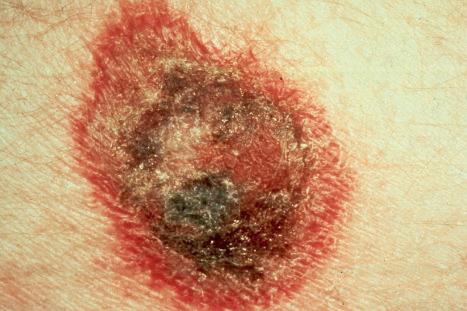
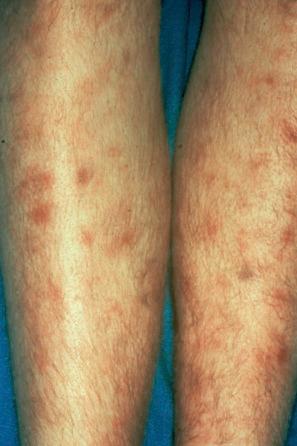
Although earlier literature suggests that SPTCL is an aggressive disease with a high mortality, this is largely due to the inclusion of gamma-delta-positive cases. If more stringent criteria are used to define the entity, then SPTCL has a favorable prognosis with 5-year overall and disease-specific survival rates of 80–90%. Cases associated with a hemophagocytic syndrome have a poorer prognosis, with a 5-year overall survival of only 46%. Although polychemotherapy may be required, particularly in patients with hemophagocytic syndrome, first-line treatment with immunomodulatory agents, such as steroids and ciclosporin A, may be effective in some patients. SPTCL usually remains confined to the skin throughout its course, with death occurring due to hemophagocytic syndrome or complications of treatment.
The etiology of SPTCL is unknown. A significant percentage of cases are associated with autoimmune disease, particularly lupus erythematosus, and lupus erythematosus panniculitis (LEP) and SPTCL may exhibit overlapping clinical and pathological features. Thus, it has been proposed that there is a spectrum of disease encompassing LEP and SPTCL at either end. This is supported by recent gene expression profiling studies demonstrating up-regulation of genes in SPTCL that are also associated with autoimmune disorders, including lupus. SPTCL also harbors chromosomal abnormalities that identify it as a specific subgroup among cutaneous T-cell lymphomas.
The infiltrate typically involves fat lobules with limited septal involvement. There may be some extension into the deep reticular dermis, but the superficial dermis and epidermis are usually spared. Angioinvasion and angiodestruction are uncommon. Neoplastic lymphocytes vary in size and comprise small to intermediate-sized lymphocytes with only scattered large cells. Nuclei are hyperchromatic and cytoplasm is scanty ( Figs 29.153–29.158 ). Rimming of individual fat cells is typical, but may be focal and is not specific. Karyorrhexis and fat necrosis are almost always present, usually in association with histiocytes, and occasionally granulomatous inflammation. Histiocytes are frequently vacuolated, may contain phagocytosed nuclear debris, or display erythrophagocytosis. Reactive small lymphocytes may also be seen, while neutrophils and eosinophils are rare. Plasma cells and lymphoid follicles are also sparse except in cases overlapping with LEP.
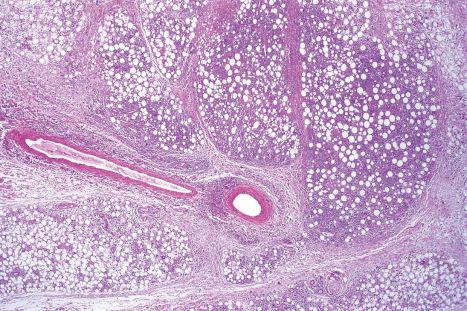
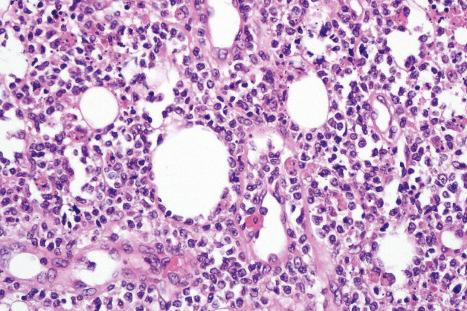
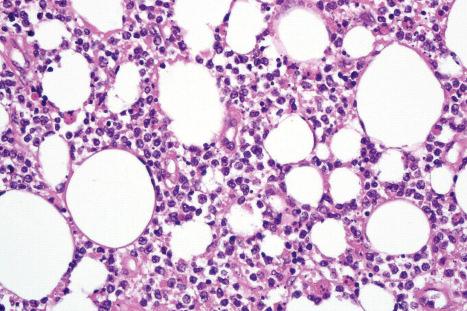
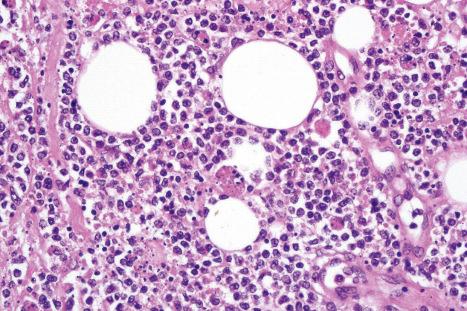
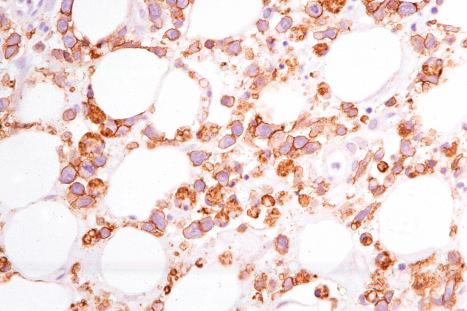
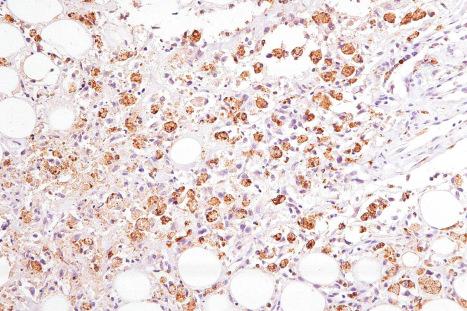
Tumor cells display a cytotoxic phenotype and are CD3+, CD4–, CD8+ with expression of the cytotoxic molecules granzyme B, TIA-1, and perforin, although rarely CD4+, CD8–, and CD4–, CD8– cases may occur. Loss of the pan-T-cell antigens CD2, CD5, and CD7 occurs in 10%, 50%, and 44% of cases, respectively. CD30 is usually negative, and rarely few CD56+ cells are seen. Beta F1 is usually identifiable, commensurate with an alpha-beta phenotype. EBV is absent, apart from exceptional cases from Asia.
Clonal rearrangements of the T-cell receptor genes are generally identified.
The main differential diagnosis includes cutaneous gamma-delta T-cell lymphoma and extranodal T/NK-cell lymphoma, nasal type. Immunohistochemistry should readily help distinguish between these entities. Cutaneous gamma-delta T-cell lymphomas are usually CD4–, CD8–, lack beta F1, and typically express CD56. Extranodal T/NK-cell lymphomas usually lack CD3 as well as CD4 and CD8, and express CD56. Moreover, staining for EBV is invariably positive.
LEP may be difficult to distinguish from SPTCL. It may be prudent to screen all cases of suspected SPTCL for lupus erythematosus. In general, a diagnosis of LEP should be strongly considered when numerous plasma cells, areas of hyalinization, and reactive germinal centers are seen, with epidermal involvement. Aggregates of CD123 positive plasmocytoid dendritic cells may also be seen. A polyclonal pattern of gene rearrangement would also favor a diagnosis of lupus.
Natural killer (NK) cells are members of the innate immune system that mediate major histocompatibility complex (MHC)-unrestricted target cell lysis without prior antigen exposure. True NK cells are characterized by germline TCR genes, absence of a fully assembled TCR-CD3 complex on the cell surface, and expression of CD16 and CD56. They typically possess cytotoxic granules.
NK cells and cytotoxic T cells are closely related and share certain phenotypic features. Cytotoxic T cells often express NK-associated antigens such as CD56, and NK cells may react with antibodies to T-cell-associated antigens including CD2, CD7, and CD8. The diagnostic category of NK/T-cell lymphoma reflects this blurred distinction, and while most cases belonging to this entity are genuine neoplasms of NK cells, inclusion of cases displaying some features of a cytotoxic T-cell phenotype is also permitted.
Examples of NK/T-cell lymphoma have previously been described as lethal midline granuloma, polymorphic reticulosis, and angiocentric T-cell lymphoma. However, these diagnostic categories also contain a variety of other malignancies that share some clinical (e.g., involvement of upper respiratory tract or skin) and pathological (e.g., an angiocentric growth pattern, expression of CD56) features with NK/T-cell lymphoma. These entities have now been separated into their own categories, such as lymphomatoid granulomatosis (LG), γ/δ T-cell lymphoma, and subcutaneous panniculitis-like T-cell lymphoma. Most patients are adults with a median age at presentation of around 50 years and a slight male predominance. It is more common in East Asian countries such as China, Korea, and Japan, rare in Europeans, and relatively frequently encountered in Native Americans in Mexico and South and Central America. As the name implies, most cases are extranodal in location with predilection for the upper aerodigestive tract, particularly the nasal cavity, nasopharynx, paranasal sinuses, and palate. It is characterized by destructive midline lesions and involvement of the nasal cavity, nasopharynx, paranasal sinuses, and/or palate. Orbital swelling and edema may be prominent. Other extranodal sites may also be involved including skin, soft tissue, gastrointestinal tract, and testis, and in some cases disease is present in the absence of nasal involvement (so-called ‘extranasal type’). After the upper aerodigestive tract, skin is the most frequently involved site of presentation, and in rare cases the disease may be primary cutaneous in origin. Cutaneous lesions consist of multiple nodules or plaque, sometimes ulcerated. Vasculitis, panniculitis-like, and cellulitis-like appearances may occur. Lesions present at more than one anatomic site, with predilection for the trunk and/or limbs. However, sometimes they are solitary, restricted to one anatomic site, and this seems to be more common in the skin.
Systemic symptoms (fever, malaise, and weight loss) and the hemophagocytic syndrome may be present. Lymph nodes are involved as part of disseminated disease and only rarely represent primary disease. Bone marrow and peripheral blood involvement is uncommon and when present raises the possibility of aggressive NK-cell leukemia.
The survival rates for extranodal NK/T-cell lymphoma have been very poor, with more than 60% of patients succumbing to disease, often within a matter of months. However, response and survival rates have improved with more aggressive treatments. The most important prognostic factor is the presence or absence of nasal disease, those with nasal involvement having a significantly superior survival compared to ‘extranasal’ cases. A particularly poor prognosis appears to be associated with extranodal NK/T-cell lymphoma presenting primarily as cutaneous disease compared to nasal or other extranodal sites.
Extranodal NK/T-cell lymphoma is strongly associated with EBV, and some cases arise in the context of immunosuppression. Most Japanese patients are infected with type A EBV with a 30-base-pair deletion in the LMP1 gene, suggesting a pathogenetic role for the virus. Various cytogenetic abnormalities have been described. By conventional cytogenetics, deletions of 6q are common, whilst CGH and loss-of-heterozygosity studies reveal frequent DNA gains and losses. Mutations or partial deletions of various genes may also occur, including TP53, TP73, CDKN2A, CDKN2B, MDM2, FAS, KIT, RAS, ATR, and STAT3. Inactivation of PDRM has also been implicated in disease pathogenesis.
The poor response to treatment in NK/T-cell lymphoma has been attributed to overexpression of multidrug resistance proteins. The extensive coagulative necrosis seen in many cases and attributed to vascular occlusion by lymphoma cells may also be due to release of cytokines and chemokines by tumor cells.
Skin biopsies show a dense, nodular, or diffuse dermal infiltrate, which often extends into the subcutaneous fat ( Fig. 29.159 ). The infiltrate is typically angiocentric, often angiodestructive, and associated with extensive zonal necrosis ( Figs 29.160 and 29.161 ). Epidermotropism is exceptional. Tumor cells are variable, ranging from small to medium or large with irregular, granular, or vesicular chromatin, inconspicuous or small nucleoli, and moderate amounts of pale or clear cytoplasm ( Fig. 29.162 ). Mitoses are abundant. Small lymphocytes, plasma cells, histiocytes, and eosinophils may be seen. Florid pseudoepitheliomatous hyperplasia is noted at mucosal sites.
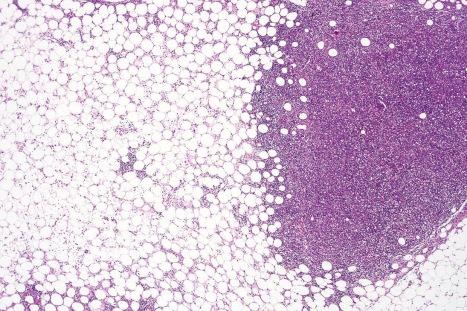
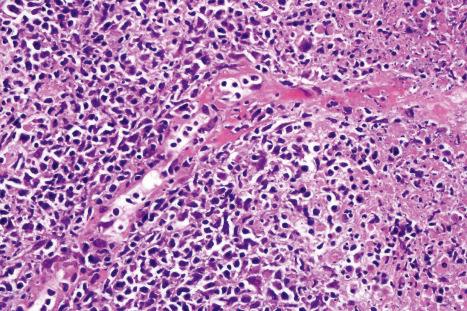
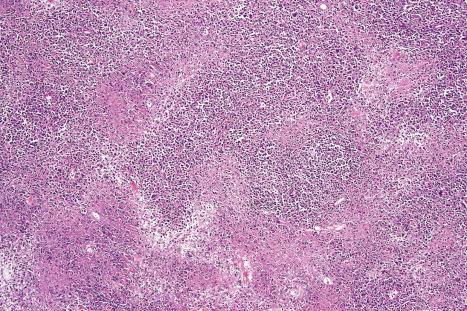
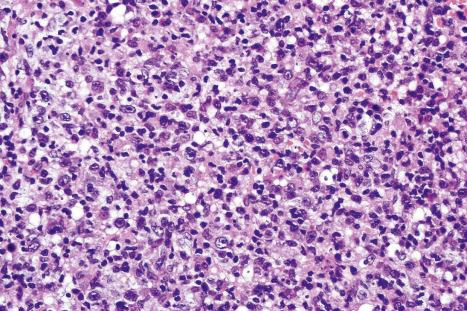
Cases with an NK-cell phenotype typically express CD2 and CD56, as well as cytoplasmic but not membranous CD3. Cytotoxic molecules (TIA-1, granzyme B, perforin) are present, but other T-cell-associated antigens, including CD3, CD4, CD5, CD7 and CD8, are usually lacking, as are the NK-cell antigens CD16 and CD57. Extranodal NK/T-cell lymphoma of NK-cell origin also display a germline pattern of T-cell receptor gene rearrangement. A T-cell lineage is documented in 10–40% of cases and is associated with expression of one or more of CD2, CD3, CD4, CD5, CD7, and CD8, together with cytotoxic molecules and/or a monoclonal T-cell receptor gene rearrangement.
Before the advent of immunophenotyping, NK/T-cell cutaneous lymphoma and lymphomatoid granulomatosis were readily confused. It now recognized that lymphomatoid granulomatosis represents an EBV-positive clonal B-cell proliferation associated with a brisk reactive T-cell infiltrate. Immunohistochemistry and in situ hybridization for EBV should also allow most cases to be readily distinguished from other lymphoma subtypes including subcutaneous panniculitis-like T-cell lymphoma, blastic plasmacytoid dendritic cell neoplasm (BPDCN), primary cutaneous CD8+ aggressive epidermotropic cytotoxic T-cell lymphoma, cutaneous γ/δT-cell lymphoma, and peripheral T-cell lymphoma, unspecified. There may be considerable pathological overlap between extranodal NK/T-cell lymphoma and HV-like lymphoproliferative disorder, separation often being largely dependent on clinical features. HV-like lymphoproliferative disorder typically presents in a younger age group and has a protracted, rather than a rapidly progressive, course.
The majority of cutaneous T-cell lymphomas (CTCLs) consist of lymphocytes with the phenotype of resting or activated CD4-positive memory T cells. However, a proportion exhibit a CD8-positive cytotoxic phenotype. Expression of CD8 may be characteristic of a particular entity, as in subcutaneous panniculitis-like T-cell lymphoma. CD8 expression may occasionally be seen in lymphoma subtypes that more commonly express CD4, including typical cases of mycosis fungoides, pagetoid reticulosis, lymphomatoid papulosis, and cutaneous anaplastic large cell lymphoma. In addition, there is a subset of CD8-positive lymphomas with a distinctive clinical presentation and aggressive clinical course, suggesting a specific entity, primary cutaneous CD8-positive epidermotropic cytotoxic T-cell lymphoma. This was a provisional entity in the 2008 WHO classification and remains so in the 2016 update. Examples may previously have been described as generalized pagetoid reticulosis (Ketron-Goodman disease) or mycosis fungoides d'emblee.
Primary cutaneous CD8-positive aggressive epidermotropic cytotoxic T-cell lymphoma accounts for less than 1% of all CTCLs. Most patients are adults who present with a generalized, rapidly progressive eruption consisting of erythematous patches and plaques, verrucous hemorrhagic papules, nodules, and tumors with occasional oral involvement ( Fig. 29.163 ). Disease progression is relentless, with widespread visceral metastases to uncommon sites including the testis, lungs, spleen, and CNS (without lymphadenopathy) and high mortality (mean survival time, 32 months).
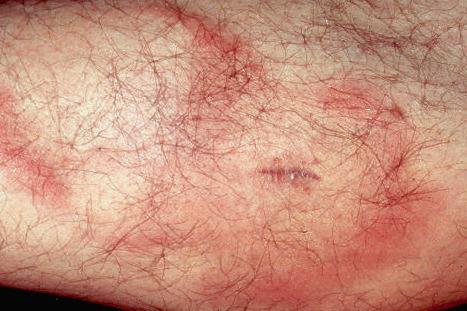
Histologically, lesions are characterized by a highly epidermotropic atypical lymphoid infiltrate ( Figs 29.164 and 29.165 ), usually with a pagetoid appearance and usually lacking Pautrier microabscesses. Associated epidermal necrosis is common. The tumor cells display varying cytology but are often of medium to large size with enlarged hyperchromatic nuclei. A dermal infiltrate is almost always present and often extends to the deep reticular dermis or subcutaneous fat. Angiocentricity and angioinvasion are also frequently present. Syringotropism and folliculotropism can be seen. Histiocytes, eosinophils, and plasma cells might also be noted.
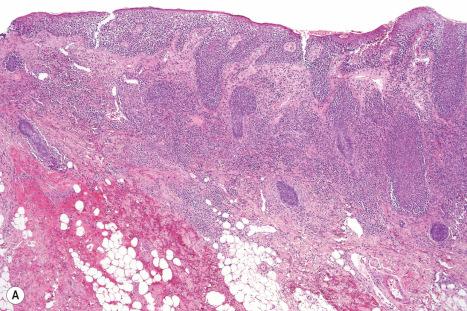
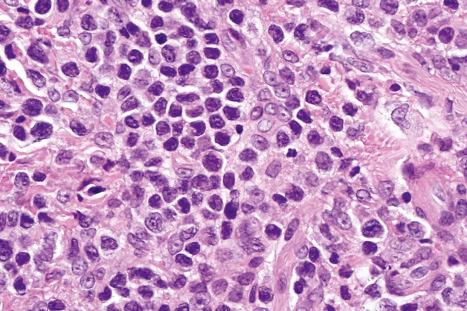
The tumor cells are of alpha/beta phenotype, react with antibodies to beta F1, and express CD3 and CD8 ( Fig. 29.166 ). They usually express CD7, while CD2 and CD5 are frequently lost, and CD4 is negative. TIA1 is detectable, but perforin and granzyme B may be negative. There is no association with EBV infection. Flow cytometry results suggest that the tumor cells may express CD15, and that circulating CD8-positive tumor cells are detectable in peripheral blood, although the latter seems to be antibody dependent.
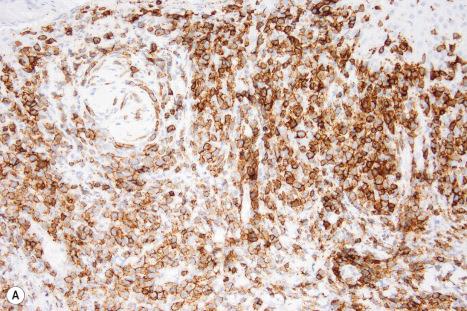
Clinical correlation is paramount in distinguishing primary cutaneous CD8-positive epidermotropic cytotoxic T-cell lymphoma from other CD8-positive lymphoproliferations that may also display marked epidermotropism. These include mycosis fungoides, pagetoid reticulosis, and some cases of lymphomatoid papulosis. In particular, short history and disseminated nature of lesions at presentation, together with the rapid clinical course, sets primary cutaneous CD8-positive epidermotropic cytotoxic T-cell lymphoma apart. Distinction from primary cutaneous gamma-delta T-cell lymphoma, which is occasionally CD8-positive, can be achieved by determining the nature of the surface T-cell receptor by staining with antibodies to the ΒF1, γ, and/or δ subunits.
HV was historically defined in Western countries as a photosensitivity disorder of childhood characterized by development of papules and vesicles on sun-exposed skin of the face and dorsum of hands. Lesions evolve to crusts that heal, leaving varicelliform scars. In most cases, the onset is in childhood with resolution during early adult life. There are no associated systemic symptoms. Conversely, HV-like lymphoma was the name given to a clinical syndrome clinically very similar to HV but with a more aggressive clinical course. This was described predominantly in children from East Asia, Latin America, and Mexico. Patients with HV-like lymphoma present with marked facial edema and recurring vesiculopapular rashes with development of large ulcers and crusts. Healing of these lesions is associated with severe scarring and disfigurement. Unlike classical HV, the skin lesions develop on sun-exposed and non-sun-exposed skin. In addition, systemic symptoms are usually present in the form of fever, weight loss, hepatosplenomegaly, and lymphadenopathy. There is frequent association with severe mosquito bite hypersensitivity, and the prognosis is often poor with a fatal outcome. Past names for this condition include edematous scarring vasculitic panniculitis, hydroa-like lymphoma, and angiocentric cutaneous T-cell lymphoma of childhood. Cases referred to as severe HV-like eruption are probably part of the spectrum. This entity was incorporated into the 2008 WHO classification and considered separate from classical HV.
Further analysis of cases has shown considerable clinical and pathological overlap between patients originally designated classical HV and HV-like lymphoma, and there is a lack of reproducible morphological, immunophenotypic, and molecular findings to allow the distinction of these two putative entities. It has therefore been proposed that there is a spectrum of EBV-associated T/NK-cell lymphoproliferations with HV-like cutaneous manifestations. Classic, self-resolving HV lies at one end of this spectrum and HV-like lymphoma with an aggressive clinical course at the other. Consequently, the currently preferred approach is to include all such lesions under the heading of HV-like lymphoproliferative disorder (LPD), and this is the recommended nomenclature used in the 2016 update of the WHO classification.
The clinical features of HV-like LPD are as described above. All cases run a waxing and waning course. Extensive and disfiguring skin lesions, involvement of non-sun-exposed sites, and a potentially fatal clinical course characterize the more severe form of the illness. Cases that behave aggressively typically have severe symptoms at presentation. Death results from progression to T- or NK-cell lymphoma or leukemia, hepatic failure, or the consequences of treatment. There is no standard treatment. Multiagent chemotherapy and radiotherapy offer little benefit, and these modalities may also increase the chances of dying from sepsis or liver failure. Immunomodulatory therapies, using agents such as prednisolone, IFN-α, chloroquine, and thalidomide may offer a better alternative as frontline treatment and have been shown to provide temporary remission or improvement of symptoms.
It is presumed that EBV is involved in driving proliferation of latently infected lymphocytes. Deletions of the long arm of chromosome 6 are seen, as in other EBV-associated lymphomas.
Histologically, HV-like LPD is characterized by a perivascular and periadnexal lymphoid infiltrate. This may be relatively sparse in some cases with only few reactive appearing lymphocytes, but in others the infiltrate is dense with obvious cytological atypia manifesting as large cells with irregular nuclei, prominent nucleoli, and abundant clear cytoplasm. There may be associated angiodestruction with extension into the subcutaneous fat. There is no epidermotropism, but spongiotic vesicles are often present and lesions are frequently ulcerated.
By definition, the infiltrating cells are positive for EBV by in situ hybridization, although they only rarely express LMP1 and are negative for EBNA2. They typically account for only a proportion of the infiltrate (10–40%), with the remaining cells being reactive. The phenotype of the EBV-positive cells is variable. In some cases they display a T-cell phenotype (60–70%), whilst others are proliferations of NK cells (30–40%). The majority of cases of T-lineage show clonal rearrangement of the T-cell receptor gene. The presence of more extensive, deeper infiltrates, often with involvement of the subcutis, tends to correlate with more severe symptomatology. Cases with an NK phenotype more often suffer from severe hypersensitivity to mosquito bite, more often have a prominent eosinophil component to the infiltrate, and show a tendency toward panniculitic lesions. However, there are no pathological features that reliably predict clinical course.
Demonstration of EBV in the neoplastic cells is essential in differentiating HV-like LPD from other entities that may also display an angiocentric and angiodestructive growth pattern, including primary cutaneous aggressive epidermotropic CD8-positive T-cell lymphoma and primary cutaneous γδ T-cell lymphoma. There is considerable pathological overlap between HV-like LPD and extranodal NK/T-cell lymphoma, and separation may be largely dependent on clinical features. HV-like LPD presents in a younger age group and has a more protracted course dominated by recurring papules and vesicles, with or without systemic symptoms and organomegaly, rather than progressively destructive masses.
Gamma/delta T cells are cytotoxic members of the innate immune system. They represent about 5% of the mature lymphocyte population and preferentially localize to epithelial-rich tissues and mucosal surfaces (skin, intestine and reproductive tract, and the sinusoidal areas of the spleen). Tumors of gamma/delta T cells mirror this physiological distribution.
Primary cutaneous gamma/delta T-cell lymphoma (PCGD-TCL) is now recognized as a distinct entity in the most recent (2016) WHO classification and includes cases previously referred to as subcutaneous panniculitis-like T-cell lymphoma with a gamma/delta phenotype, and examples of CD4/CD8 double-negative cutaneous T-cell lymphoma. Mucosal gamma/delta T-cell lymphoma is a closely related entity, but hepatosplenic gamma/delta T-cell lymphoma is biologically distinct, being derived from functionally immature gamma/delta T cells, which seem to belong to a different Vδ subset than the lymphocytes of PCGD-TCL.
PCGD-TCL comprises only about 1% of all cutaneous T-cell lymphomas. Most cases arise in adults, mainly males, with a wide age range (13–84 years; median, 59 years). Presentation is with plaques reminiscent of mycosis fungoides, nodules, and (in some patients) subcutaneous lesions ( Fig. 29.167 ). There may be ulceration. Lesions are usually generalized at presentation, with preferential involvement of the extremities and also the trunk. Hemophagocytic syndrome occurs in up to 25% of patients, and the majority of patients have B symptoms. The disease is resistant to treatment and the prognosis is poor, with a median survival of 15 months. Cases with prominent subcutaneous involvement may carry a poorer prognosis than those with disease limited to the epidermis and dermis. It has recently been suggested that a subgroup of gamma-delta cutaneous T-cell lymphomas in which epidermotropic cells represent more than 75% of the infiltrate, are distinctive and have better prognosis than those that are predominantly dermal and/or subcutaneous.
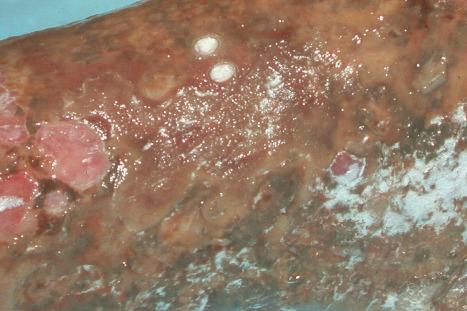
Three major histologic patterns are recognized, but more than one pattern can be present in different biopsies from the same patient, or even within a single biopsy. Plaques are characterized by epidermotropic infiltrates. The degree of epidermotropism may range from mild to pagetoid reticulosis-like. Tumors may show predominantly dermal involvement, can be separated from the epidermis by a grenz zone, and extend into subcutaneous fat ( Figs 29.168 and 29.169 ). In subcutaneous lesions, the features closely resemble subcutaneous panniculitis-like T-cell lymphoma, including rimming of fat cells, although dermal and epidermal involvement is usually also present ( Fig. 20.170 ). Tumor cells are medium to large with coarsely clumped chromatin. Blast cells are usually relatively infrequent. Necrosis and angioinvasion are common.
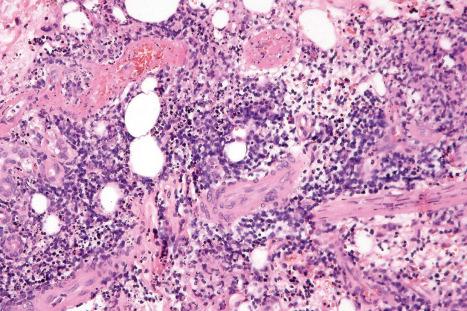
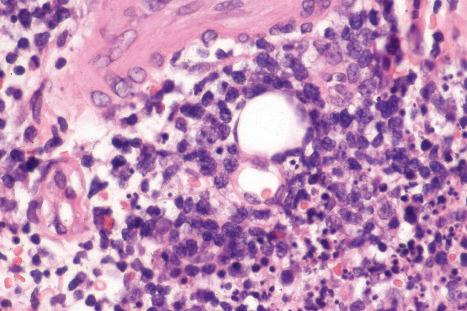
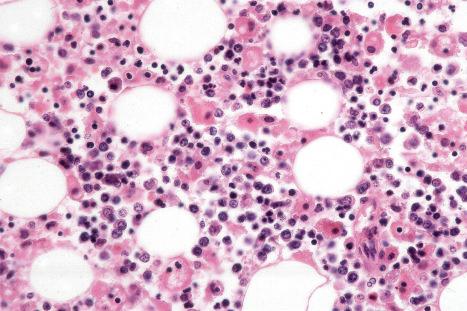
By definition, the neoplastic lymphocytes in PCGD-TCL should express a gamma/delta heterodimer on the cell surface. This can now be demonstrated by antibodies to TCR-gamma in paraffin sections. The tumor cells typically express CD2, CD3, and also CD7; CD5 is usually absent. Most cases lack both CD4 and CD8, although occasional CD8-positive cases are reported, and there is strong expression of the cytotoxic molecules TIA-1, perforin, and granzyme B. CD56 is often expressed, particularly in subcutaneous cases, but may be negative. EBV is usually absent.
TCR-gamma and TCR-delta genes are clonally rearranged. The TCR-beta gene may be rearranged or deleted, but is not expressed.
The differential diagnosis of PCGD-TCL includes subcutaneous panniculitis-like T-cell lymphoma and extranodal NK/T-cell lymphoma. The combination of clinical features and gamma/delta phenotype should allow a correct diagnosis to be established in most cases. Extranodal NK/T-cell lymphoma is almost invariably EBV positive. In addition, rare cases of mycosis fungoides and lymphomatoid papulosis express a γδ phenotype. Clinical correlation is required to separate these from PCGD-TCL.
Peripheral T-cell lymphoma, not otherwise specified, is a heterogeneous group of nodal and extranodal mature T-cell lymphomas that do not fit into one of the well-defined subtypes of T-cell lymphoma/leukemia. They not uncommonly involve the skin as a primary or secondary manifestation of disease. When presenting in the skin, they display aggressive behavior with a similarly poor outcome, whether or not there is concomitant lymph node involvement. Cases which do not fit well into any of the above described categories of cutaneous T-cell lymphoma should, therefore, be assigned to this group. Cutaneous involvement by systemic T-cell lymphoma is mainly seen in patients with mature T cell or T-cell/NK lymphoma (40% of cases) and less frequently with anaplastic large cell lymphoma (10%) and angioimmunoblastic lymphoma (5%).
Cutaneous pseudolymphoma does not constitute a distinct entity, but is a term used to describe lymphoid infiltrates that simulate malignancy histologically and sometimes also clinically. Cases can be broadly divided into those mimicking T-cell lymphomas (cutaneous T-cell pseudolymphoma) and those masquerading as B-cell neoplasms (cutaneous B-cell pseudolymphoma). This rather arbitrary distinction is based on the histologic pattern and predominant cell type. Many examples contain significant numbers of B cells, often arranged in follicles, and fall into the category of cutaneous B-cell pseudolymphoma. Cases mimicking T-cell lymphoma are less common.
Cases of cutaneous T-cell pseudolymphoma (CTPL) may be idiopathic, but many can be classified as distinct clinicopathological entities, the main ones being lymphomatoid drug eruptions, lymphomatoid contact dermatitis, pseudolymphomatous angiokeratoma (APACHE), T-cell rich angiomatoid polypoid pseudolymphoma (TRAPP), pseudolymphomatous folliculitis, chronic actinic dermatitis (CAD), persistent arthropod bite reaction, lymphomatoid keratosis, and atypical cutaneous lymphoproliferative disorder of HIV infection. Several of these specific entities are discussed below, or elsewhere in this or other chapters. Many idiopathic cases show considerable overlap with primary cutaneous CD4-positive small/medium pleomorphic T-cell lymphoproliferative disorder, and may well be part of the same spectrum of disease.
Rarely, intralymphatic aggregates of CD30 positive or, less commonly, CD30 negative blastic cells are seen in skin biopsies performed in the setting of trauma or various inflammatory and neoplastic pathologies including lichen sclerosus, hidradenitis suppurativa, and hemangioma. The behavior appears to be benign with no adverse effects in any of the cases reported so far.
A variable number of dermal lymphatics appear dilated by a proliferation of blastic cells that are frequently, but not always, CD30 positive ( Figs 29.171–29.173 ). Other T-cell markers including CD3 and CD4 are usually expressed. B-cell markers are negative. The proliferating cells are usually polyclonal.
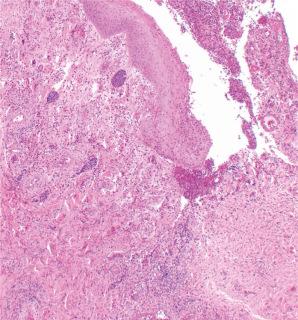
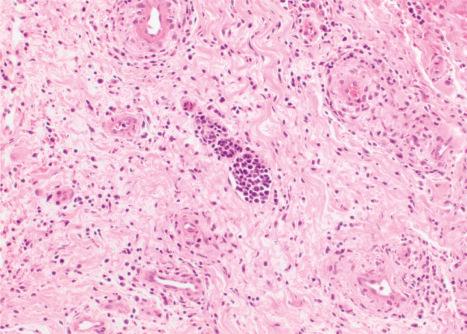
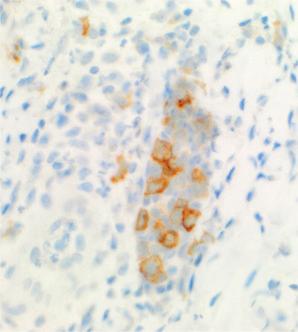
The differential diagnosis includes intravascular T, NK/T, or B cell lymphoma and intravascular histiocytosis. Clinicopathological correlation, immunophenotyping, and clonality studies are crucial to establish the right diagnosis.
Pseudolymphomatous angiokeratoma (acral pseudolymphomatous angiokeratoma, APACHE) was originally described as a disorder presenting as unilateral, asymptomatic, red, angiomatous papules and nodules on acral sites of children with equal sex incidence and predilection for the hands and feet, particularly the digits. However, similar cases have rarely been described in adults with a wider anatomic range including elsewhere on the limbs and the trunk. It is likely that the latter represent examples of T-cell rich angiomatoid polypoid pseudolymphoma (TRAPP, see below). Lesions tend to be persistent and are exceptionally linear.
The etiology is unknown and there is no relation with angiolymphoid hyperplasia (epithelioid hemangioma) as has been suggested. The epidermis appears flattened, and there may be some degree of interface change. In the underlying dermis, there is a prominent, often diffuse infiltrate composed of lymphocytes and variable numbers of plasma cells. Cytological atypia is absent. In the background, there are numerous, small, thin-walled vascular channels. T cells tend to predominate with both CD4+ and CD8+ T cells represented. Rarely, B cells are prominent. Unlike other angiokeratomas, the endothelial cells in pseudolymphomatous angiokeratoma appear to express WT1.
T-cell rich angiomatoid polypoid pseudolymphoma (TRAPP) is a distinctive variant of cutaneous pseudolymphoma. Lesions are solitary and present as a small (less than 1 cm) polypoid angiomatous papule with predilection for the head and trunk. It clinically resembles a nonulcerated pyogenic granuloma, and patients are predominantly young adults with some predilection for females. Regression is not usually seen. There is no tendency for local recurrence.
The pathogenesis of TRAPP is unknown. The typical histology consists of a polypoid, nonulcerated diffuse and well-circumscribed infiltrate often separated from a thinned epidermis by a grenz zone ( Figs 29.173–29.175 ). In the background, there are numerous small blood vessels lined by plump but not epithelioid endothelial cells. These vessels have features of high endothelial venules seen in lymph nodes ( Fig. 29.176 ). The infiltrate consists mainly of CD3-positive lymphocytes, and both CD4+ and CD8+ cells are represented ( Figs 29.177–29.179 ). B cells are sparse. Cytological atypia is not seen. Eosinophils and plasma cells may be seen. Old lesions display some degree of fibrosis.
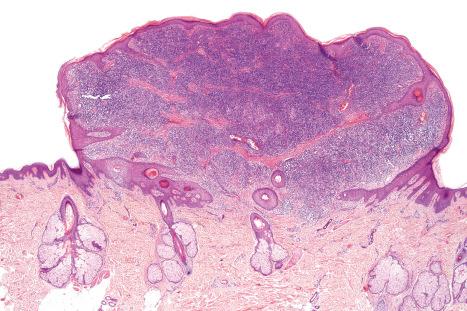
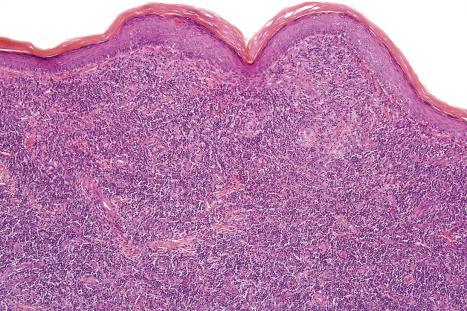
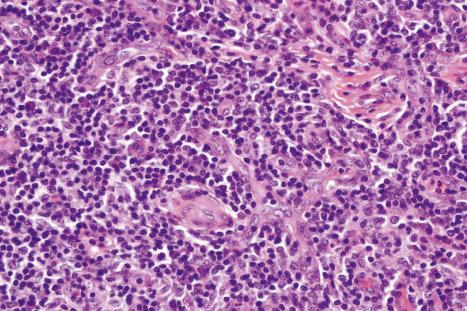
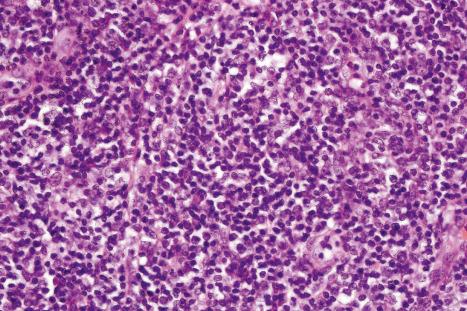
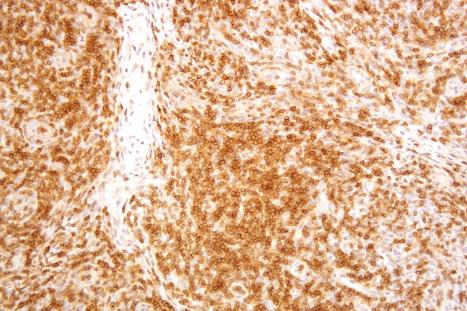
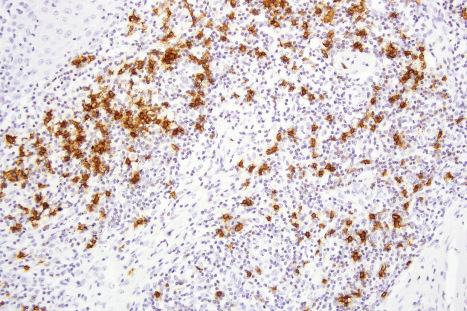
The main differential diagnosis is with pseudolymphomatous angiokeratoma (APACHE). Similar lesions have also been described under different rubrics including papular angiolymphoid proliferation with epithelioid features in adults and children (PALEFACE) and angiolymphoid hyperplasia with high endothelial venules (APA-HEL). There is undoubtedly some overlap with pseudolymphomatous angiokeratoma (APACHE). However, TRAPP occurs on the head and trunk, it presents as a solitary lesion, with adult predilection, and it is always polypoid with an epithelial collarette and lack of interface change.
This is discussed in Chapter 14 .
Pseudolymphomatous folliculitis is uncommon and presents in the head and neck region as solitary red or violaceous, nonulcerated, solitary nodules, measuring up to 3 cm in diameter. The sexes are affected equally, and most patients are in their fourth or fifth decade. Surgery seems to be adequate treatment since only one case of recurring lesions has been reported. Even when not fully excised, lesions tend to spontaneously regress.
The etiology in the vast majority of cases is unknown. One case had a history of previous insect bite, in two a history of antecedent trauma, and in another, B. burgdorferi DNA was demonstrated. The striking folliculocentricity and conspicuous dendritic cell population suggest that the condition most probably represents an exuberant hypersensitivity reaction to an as yet unidentified follicular antigen.
The salient diagnostic features are the presence of a dense nodular or diffuse folliculocentric infiltrate, together with hyperplasia and distortion of pilosebaceous units. The infiltrate is usually separated from the epidermis by a grenz zone and may involve the subcutis. It consists of lymphocytes with variable numbers of histiocytes, plasma cells, and, in some cases, eosinophils. The lymphocytes are usually small, although in some cases medium to large lymphocytes are present, either with irregular hyperchromatic nuclei or an immunoblastic appearance. Lymphoid follicles are rare. The histiocytes generally have an epithelioid appearance and are often clustered around infiltrated hair follicles and sebaceous glands. Small noncaseating granulomata can be seen.
The infiltrate consists of a mixed population of T and B cells. CD8+ T cells are sparse. In most cases, T cells predominate, but in some B cells are present in equal or greater numbers. The epithelioid histiocytes react with antibodies to CD68 whilst antibodies to S100 protein and CD1a highlight collections of perifollicular dendritic cells. There is no evidence of immunoglobulin light chain restriction in the B-cell rich variants.
Gene rearrangement studies were uniformly negative in a Japanese series, but a recent large study from Europe demonstrated clonal T-cell receptor rearrangements by PCR in about 50% of patients, and clonal immunoglobulin gene rearrangement in three out of 42 cases. In one case, both the T-cell receptor and immunoglobulin heavy chain gene were clonally rearranged. Clonal cases of pseudolymphomatous folliculitis show no clinical or pathological differences to nonclonal ones. However, the median follow-up of 3 years in this study is too short to draw definite conclusions. If clonality is found, then close follow-up is advisable.
It is questionable whether pseudolymphomatous folliculitis is truly distinct from other cutaneous lymphoid hyperplasias in which hair follicle hyperplasia is absent. However, it is important to distinguish pseudolymphomatous folliculitis from cases of lymphoma, especially as follicular hyperplasia has also been reported, albeit rarely, in a variety of primary and secondary cutaneous lymphomas of T- and B-cell type. The presence of solitary lesions, absence of an aberrant phenotype, and demonstration of polyclonality by light chain immunohistochemistry all favor a benign diagnosis. However, as evidenced above, care must be taken interpreting the results of gene rearrangement studies, as not all molecularly clonal lesions are lymphomas.
Also known as pseudo-Sézary syndrome, this rare condition presents with widespread, pruritic, and often erythematous patches, papules, and plaques. Lesions are sometimes lichenified. Hyperpigmentation is common and occasionally hypopigmentation is noted. Erythroderma, palmoplantar keratoderma, and photosensitivity are also described. Patients typically have advanced HIV disease with severe immunosuppression. Lymphadenopathy is present in a minority of patients, and circulating Sézary-like cells may be detected. The clinical course is chronic and may be modified by introduction of antiretroviral therapy. Exceptionally, cutaneous T-cell lymphoma supervenes.
The etiology is unknown although the infiltrate has been shown to be HIV specific and directed toward a variety of antigens. There is no evidence of a drug-related pathogenesis. Photosensitivity may be an initiating event, at least in some patients. HTLV-I proviral DNA has been identified in the skin and peripheral blood of two patients but is absent in others.
Histologically, there is a superficial and deep perivascular and perifollicular polymorphous infiltrate composed of lymphocytes, eosinophils, plasma cells, and rare neutrophils accompanied by an atypical mitotically active lymphoid population with enlarged irregular nuclei containing prominent nucleoli. Mycosis/Sézary cells may be present. Epidermotropism is variably present, being reported in some cases but described as absent or minimal in others.
The lymphoid cells are CLA+, CD2+, CD3+, CD5+, CD8+, and TCRβ+. CD7 may be diminished. CD4, CD15, and CD30 are negative. B cells are absent. TCR gene rearrangement studies are negative.
Become a Clinical Tree membership for Full access and enjoy Unlimited articles
If you are a member. Log in here